Procurement and Housing Construction
VerifiedAdded on 2023/01/19
|80
|17547
|64
AI Summary
This paper discusses the role of procurement in the construction industry, with a focus on housing construction. It explores the concept of affordable housing, the current state of housing stocks, and the need for collaboration between local authorities and housing associations. The paper also highlights the importance of strategic planning and the impact of procurement strategies on the overall success of construction projects.
Contribute Materials
Your contribution can guide someone’s learning journey. Share your
documents today.
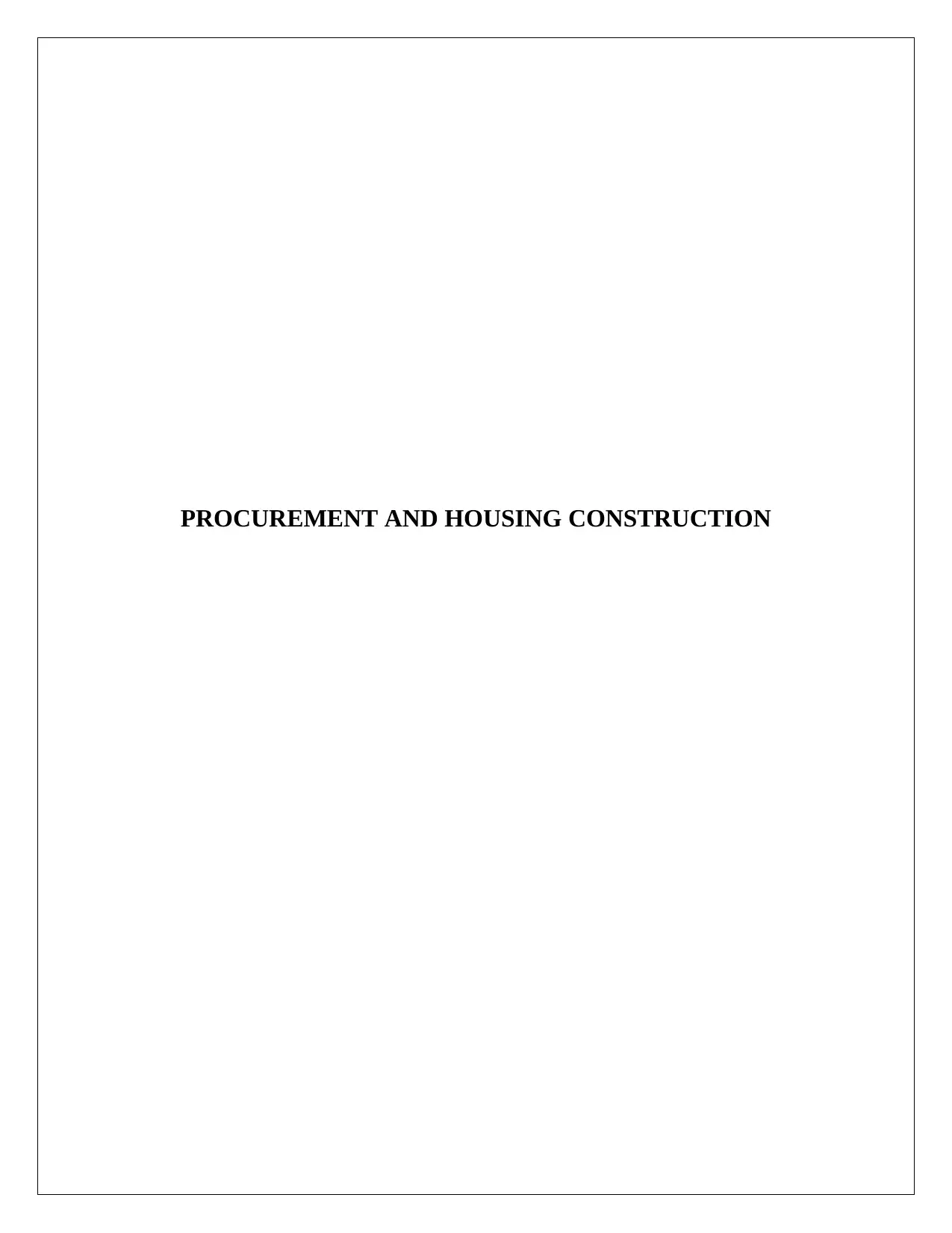
PROCUREMENT AND HOUSING CONSTRUCTION
Secure Best Marks with AI Grader
Need help grading? Try our AI Grader for instant feedback on your assignments.
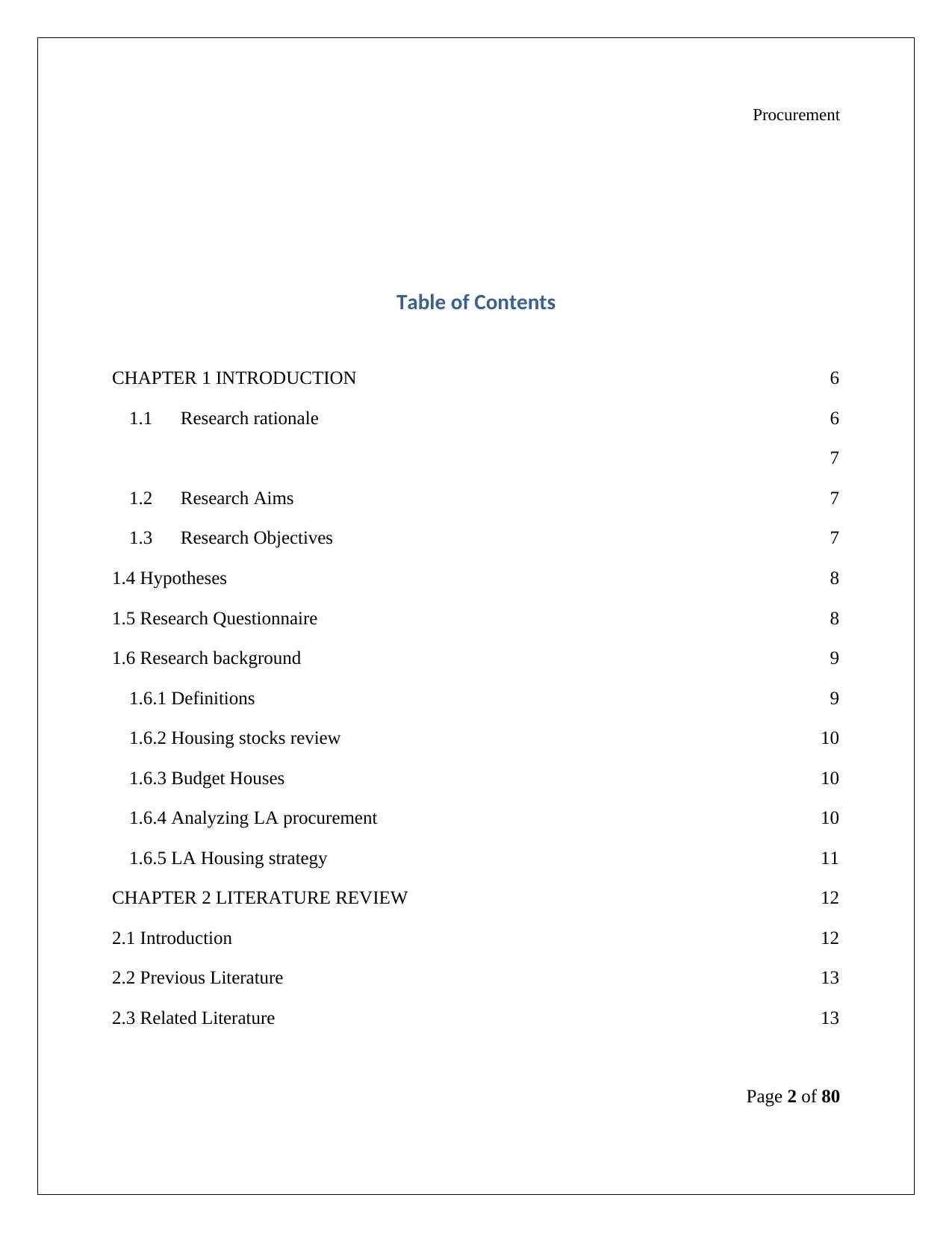
Procurement
Table of Contents
CHAPTER 1 INTRODUCTION 6
1.1 Research rationale 6
7
1.2 Research Aims 7
1.3 Research Objectives 7
1.4 Hypotheses 8
1.5 Research Questionnaire 8
1.6 Research background 9
1.6.1 Definitions 9
1.6.2 Housing stocks review 10
1.6.3 Budget Houses 10
1.6.4 Analyzing LA procurement 10
1.6.5 LA Housing strategy 11
CHAPTER 2 LITERATURE REVIEW 12
2.1 Introduction 12
2.2 Previous Literature 13
2.3 Related Literature 13
Page 2 of 80
Table of Contents
CHAPTER 1 INTRODUCTION 6
1.1 Research rationale 6
7
1.2 Research Aims 7
1.3 Research Objectives 7
1.4 Hypotheses 8
1.5 Research Questionnaire 8
1.6 Research background 9
1.6.1 Definitions 9
1.6.2 Housing stocks review 10
1.6.3 Budget Houses 10
1.6.4 Analyzing LA procurement 10
1.6.5 LA Housing strategy 11
CHAPTER 2 LITERATURE REVIEW 12
2.1 Introduction 12
2.2 Previous Literature 13
2.3 Related Literature 13
Page 2 of 80
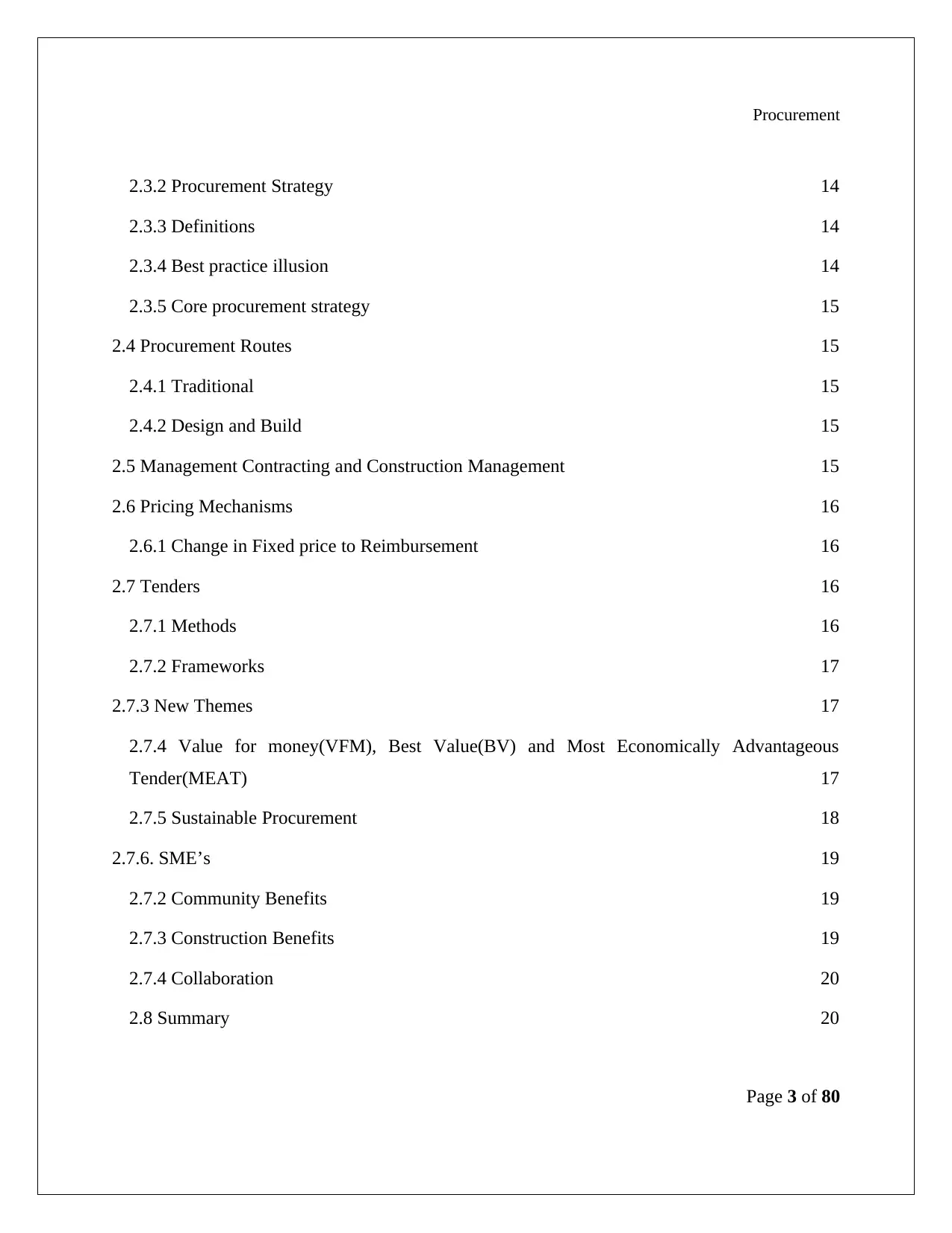
Procurement
2.3.2 Procurement Strategy 14
2.3.3 Definitions 14
2.3.4 Best practice illusion 14
2.3.5 Core procurement strategy 15
2.4 Procurement Routes 15
2.4.1 Traditional 15
2.4.2 Design and Build 15
2.5 Management Contracting and Construction Management 15
2.6 Pricing Mechanisms 16
2.6.1 Change in Fixed price to Reimbursement 16
2.7 Tenders 16
2.7.1 Methods 16
2.7.2 Frameworks 17
2.7.3 New Themes 17
2.7.4 Value for money(VFM), Best Value(BV) and Most Economically Advantageous
Tender(MEAT) 17
2.7.5 Sustainable Procurement 18
2.7.6. SME’s 19
2.7.2 Community Benefits 19
2.7.3 Construction Benefits 19
2.7.4 Collaboration 20
2.8 Summary 20
Page 3 of 80
2.3.2 Procurement Strategy 14
2.3.3 Definitions 14
2.3.4 Best practice illusion 14
2.3.5 Core procurement strategy 15
2.4 Procurement Routes 15
2.4.1 Traditional 15
2.4.2 Design and Build 15
2.5 Management Contracting and Construction Management 15
2.6 Pricing Mechanisms 16
2.6.1 Change in Fixed price to Reimbursement 16
2.7 Tenders 16
2.7.1 Methods 16
2.7.2 Frameworks 17
2.7.3 New Themes 17
2.7.4 Value for money(VFM), Best Value(BV) and Most Economically Advantageous
Tender(MEAT) 17
2.7.5 Sustainable Procurement 18
2.7.6. SME’s 19
2.7.2 Community Benefits 19
2.7.3 Construction Benefits 19
2.7.4 Collaboration 20
2.8 Summary 20
Page 3 of 80
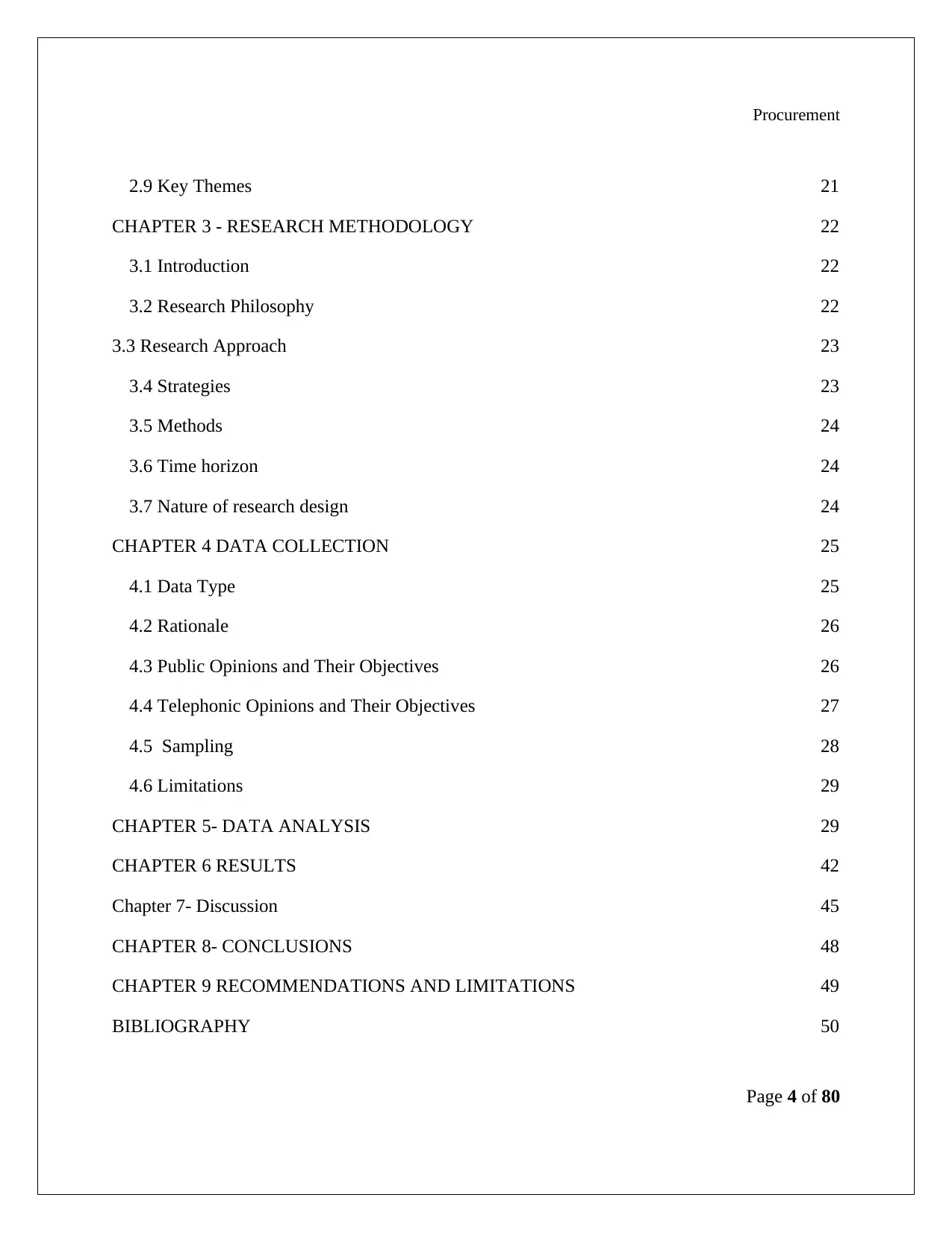
Procurement
2.9 Key Themes 21
CHAPTER 3 - RESEARCH METHODOLOGY 22
3.1 Introduction 22
3.2 Research Philosophy 22
3.3 Research Approach 23
3.4 Strategies 23
3.5 Methods 24
3.6 Time horizon 24
3.7 Nature of research design 24
CHAPTER 4 DATA COLLECTION 25
4.1 Data Type 25
4.2 Rationale 26
4.3 Public Opinions and Their Objectives 26
4.4 Telephonic Opinions and Their Objectives 27
4.5 Sampling 28
4.6 Limitations 29
CHAPTER 5- DATA ANALYSIS 29
CHAPTER 6 RESULTS 42
Chapter 7- Discussion 45
CHAPTER 8- CONCLUSIONS 48
CHAPTER 9 RECOMMENDATIONS AND LIMITATIONS 49
BIBLIOGRAPHY 50
Page 4 of 80
2.9 Key Themes 21
CHAPTER 3 - RESEARCH METHODOLOGY 22
3.1 Introduction 22
3.2 Research Philosophy 22
3.3 Research Approach 23
3.4 Strategies 23
3.5 Methods 24
3.6 Time horizon 24
3.7 Nature of research design 24
CHAPTER 4 DATA COLLECTION 25
4.1 Data Type 25
4.2 Rationale 26
4.3 Public Opinions and Their Objectives 26
4.4 Telephonic Opinions and Their Objectives 27
4.5 Sampling 28
4.6 Limitations 29
CHAPTER 5- DATA ANALYSIS 29
CHAPTER 6 RESULTS 42
Chapter 7- Discussion 45
CHAPTER 8- CONCLUSIONS 48
CHAPTER 9 RECOMMENDATIONS AND LIMITATIONS 49
BIBLIOGRAPHY 50
Page 4 of 80
Secure Best Marks with AI Grader
Need help grading? Try our AI Grader for instant feedback on your assignments.

Procurement
Table 3: Questions based on adaptibility 58
Table 4: Questions based on security and location 59
Table 5: Summary decoded from table 1,2,3 and 4 59
Page 5 of 80
Table 3: Questions based on adaptibility 58
Table 4: Questions based on security and location 59
Table 5: Summary decoded from table 1,2,3 and 4 59
Page 5 of 80
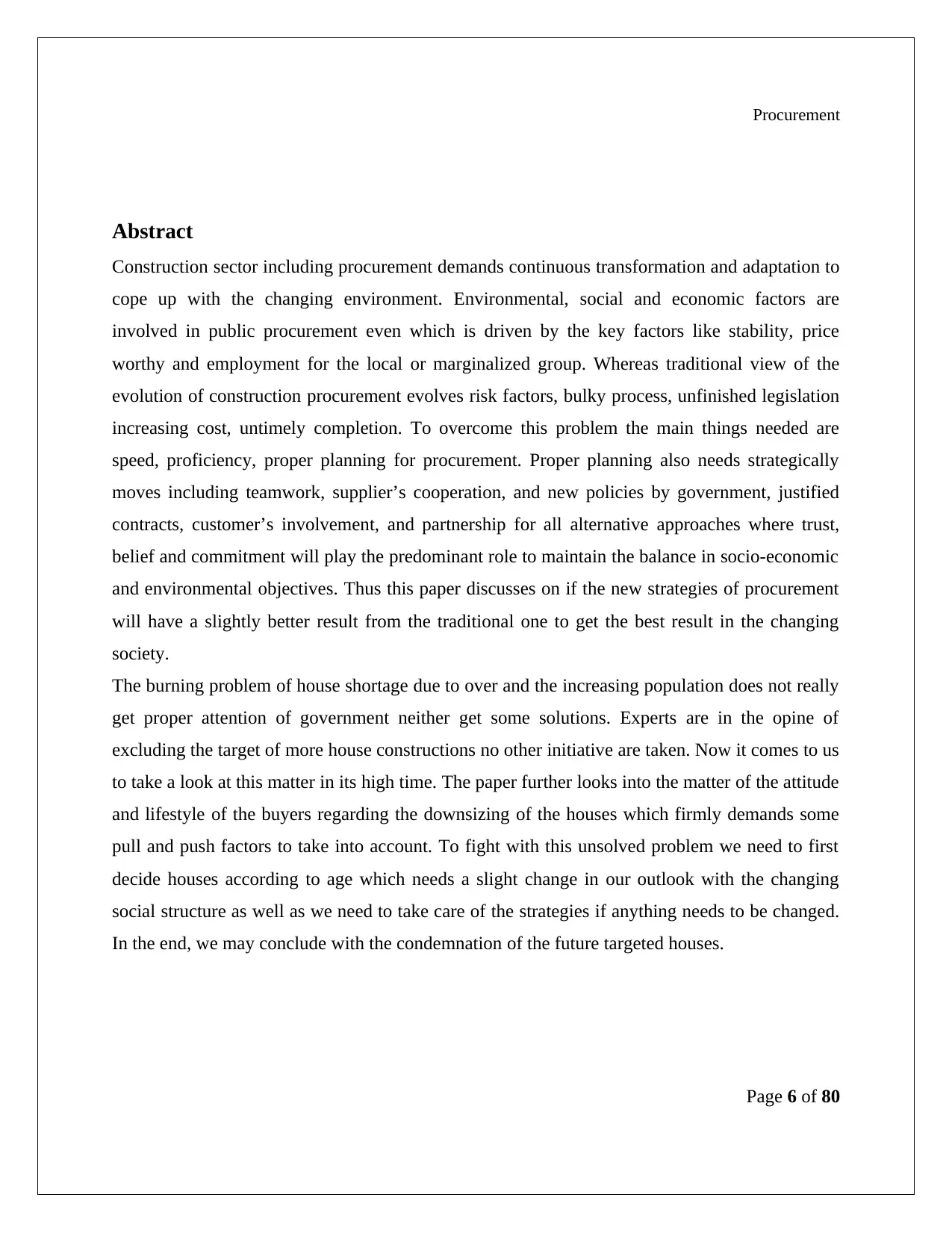
Procurement
Abstract
Construction sector including procurement demands continuous transformation and adaptation to
cope up with the changing environment. Environmental, social and economic factors are
involved in public procurement even which is driven by the key factors like stability, price
worthy and employment for the local or marginalized group. Whereas traditional view of the
evolution of construction procurement evolves risk factors, bulky process, unfinished legislation
increasing cost, untimely completion. To overcome this problem the main things needed are
speed, proficiency, proper planning for procurement. Proper planning also needs strategically
moves including teamwork, supplier’s cooperation, and new policies by government, justified
contracts, customer’s involvement, and partnership for all alternative approaches where trust,
belief and commitment will play the predominant role to maintain the balance in socio-economic
and environmental objectives. Thus this paper discusses on if the new strategies of procurement
will have a slightly better result from the traditional one to get the best result in the changing
society.
The burning problem of house shortage due to over and the increasing population does not really
get proper attention of government neither get some solutions. Experts are in the opine of
excluding the target of more house constructions no other initiative are taken. Now it comes to us
to take a look at this matter in its high time. The paper further looks into the matter of the attitude
and lifestyle of the buyers regarding the downsizing of the houses which firmly demands some
pull and push factors to take into account. To fight with this unsolved problem we need to first
decide houses according to age which needs a slight change in our outlook with the changing
social structure as well as we need to take care of the strategies if anything needs to be changed.
In the end, we may conclude with the condemnation of the future targeted houses.
Page 6 of 80
Abstract
Construction sector including procurement demands continuous transformation and adaptation to
cope up with the changing environment. Environmental, social and economic factors are
involved in public procurement even which is driven by the key factors like stability, price
worthy and employment for the local or marginalized group. Whereas traditional view of the
evolution of construction procurement evolves risk factors, bulky process, unfinished legislation
increasing cost, untimely completion. To overcome this problem the main things needed are
speed, proficiency, proper planning for procurement. Proper planning also needs strategically
moves including teamwork, supplier’s cooperation, and new policies by government, justified
contracts, customer’s involvement, and partnership for all alternative approaches where trust,
belief and commitment will play the predominant role to maintain the balance in socio-economic
and environmental objectives. Thus this paper discusses on if the new strategies of procurement
will have a slightly better result from the traditional one to get the best result in the changing
society.
The burning problem of house shortage due to over and the increasing population does not really
get proper attention of government neither get some solutions. Experts are in the opine of
excluding the target of more house constructions no other initiative are taken. Now it comes to us
to take a look at this matter in its high time. The paper further looks into the matter of the attitude
and lifestyle of the buyers regarding the downsizing of the houses which firmly demands some
pull and push factors to take into account. To fight with this unsolved problem we need to first
decide houses according to age which needs a slight change in our outlook with the changing
social structure as well as we need to take care of the strategies if anything needs to be changed.
In the end, we may conclude with the condemnation of the future targeted houses.
Page 6 of 80
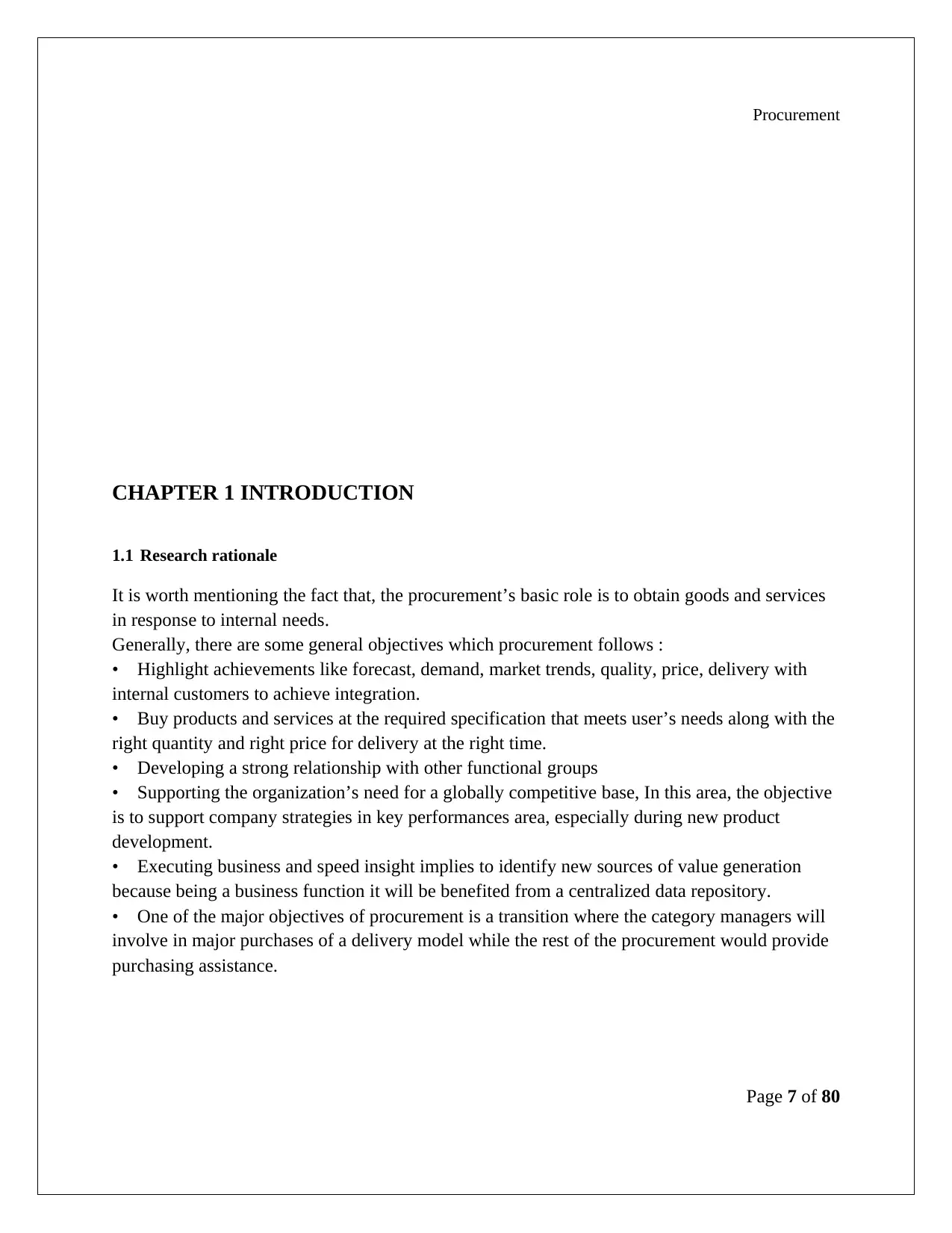
Procurement
CHAPTER 1 INTRODUCTION
1.1 Research rationale
It is worth mentioning the fact that, the procurement’s basic role is to obtain goods and services
in response to internal needs.
Generally, there are some general objectives which procurement follows :
• Highlight achievements like forecast, demand, market trends, quality, price, delivery with
internal customers to achieve integration.
• Buy products and services at the required specification that meets user’s needs along with the
right quantity and right price for delivery at the right time.
• Developing a strong relationship with other functional groups
• Supporting the organization’s need for a globally competitive base, In this area, the objective
is to support company strategies in key performances area, especially during new product
development.
• Executing business and speed insight implies to identify new sources of value generation
because being a business function it will be benefited from a centralized data repository.
• One of the major objectives of procurement is a transition where the category managers will
involve in major purchases of a delivery model while the rest of the procurement would provide
purchasing assistance.
Page 7 of 80
CHAPTER 1 INTRODUCTION
1.1 Research rationale
It is worth mentioning the fact that, the procurement’s basic role is to obtain goods and services
in response to internal needs.
Generally, there are some general objectives which procurement follows :
• Highlight achievements like forecast, demand, market trends, quality, price, delivery with
internal customers to achieve integration.
• Buy products and services at the required specification that meets user’s needs along with the
right quantity and right price for delivery at the right time.
• Developing a strong relationship with other functional groups
• Supporting the organization’s need for a globally competitive base, In this area, the objective
is to support company strategies in key performances area, especially during new product
development.
• Executing business and speed insight implies to identify new sources of value generation
because being a business function it will be benefited from a centralized data repository.
• One of the major objectives of procurement is a transition where the category managers will
involve in major purchases of a delivery model while the rest of the procurement would provide
purchasing assistance.
Page 7 of 80
Paraphrase This Document
Need a fresh take? Get an instant paraphrase of this document with our AI Paraphraser
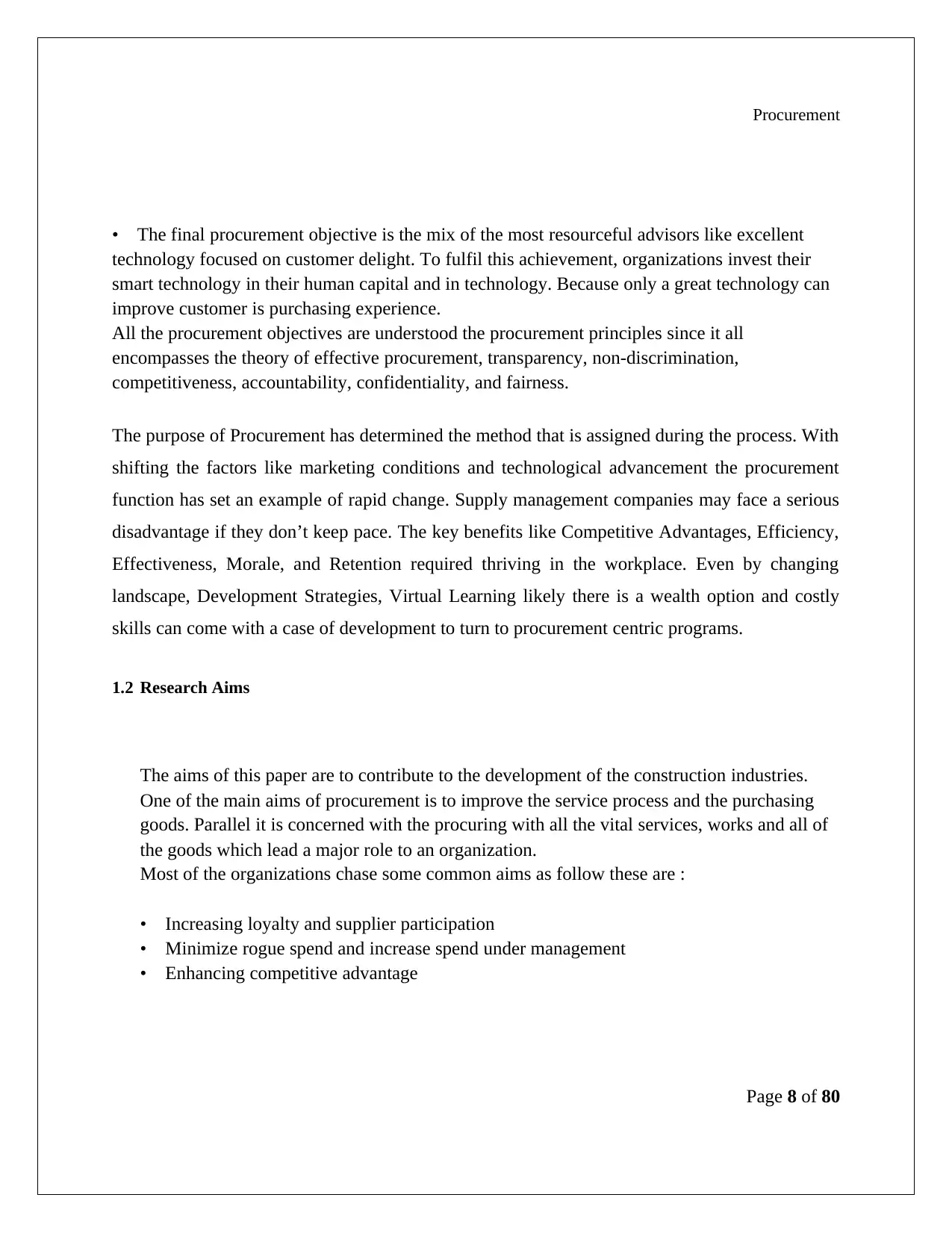
Procurement
• The final procurement objective is the mix of the most resourceful advisors like excellent
technology focused on customer delight. To fulfil this achievement, organizations invest their
smart technology in their human capital and in technology. Because only a great technology can
improve customer is purchasing experience.
All the procurement objectives are understood the procurement principles since it all
encompasses the theory of effective procurement, transparency, non-discrimination,
competitiveness, accountability, confidentiality, and fairness.
The purpose of Procurement has determined the method that is assigned during the process. With
shifting the factors like marketing conditions and technological advancement the procurement
function has set an example of rapid change. Supply management companies may face a serious
disadvantage if they don’t keep pace. The key benefits like Competitive Advantages, Efficiency,
Effectiveness, Morale, and Retention required thriving in the workplace. Even by changing
landscape, Development Strategies, Virtual Learning likely there is a wealth option and costly
skills can come with a case of development to turn to procurement centric programs.
1.2 Research Aims
The aims of this paper are to contribute to the development of the construction industries.
One of the main aims of procurement is to improve the service process and the purchasing
goods. Parallel it is concerned with the procuring with all the vital services, works and all of
the goods which lead a major role to an organization.
Most of the organizations chase some common aims as follow these are :
• Increasing loyalty and supplier participation
• Minimize rogue spend and increase spend under management
• Enhancing competitive advantage
Page 8 of 80
• The final procurement objective is the mix of the most resourceful advisors like excellent
technology focused on customer delight. To fulfil this achievement, organizations invest their
smart technology in their human capital and in technology. Because only a great technology can
improve customer is purchasing experience.
All the procurement objectives are understood the procurement principles since it all
encompasses the theory of effective procurement, transparency, non-discrimination,
competitiveness, accountability, confidentiality, and fairness.
The purpose of Procurement has determined the method that is assigned during the process. With
shifting the factors like marketing conditions and technological advancement the procurement
function has set an example of rapid change. Supply management companies may face a serious
disadvantage if they don’t keep pace. The key benefits like Competitive Advantages, Efficiency,
Effectiveness, Morale, and Retention required thriving in the workplace. Even by changing
landscape, Development Strategies, Virtual Learning likely there is a wealth option and costly
skills can come with a case of development to turn to procurement centric programs.
1.2 Research Aims
The aims of this paper are to contribute to the development of the construction industries.
One of the main aims of procurement is to improve the service process and the purchasing
goods. Parallel it is concerned with the procuring with all the vital services, works and all of
the goods which lead a major role to an organization.
Most of the organizations chase some common aims as follow these are :
• Increasing loyalty and supplier participation
• Minimize rogue spend and increase spend under management
• Enhancing competitive advantage
Page 8 of 80
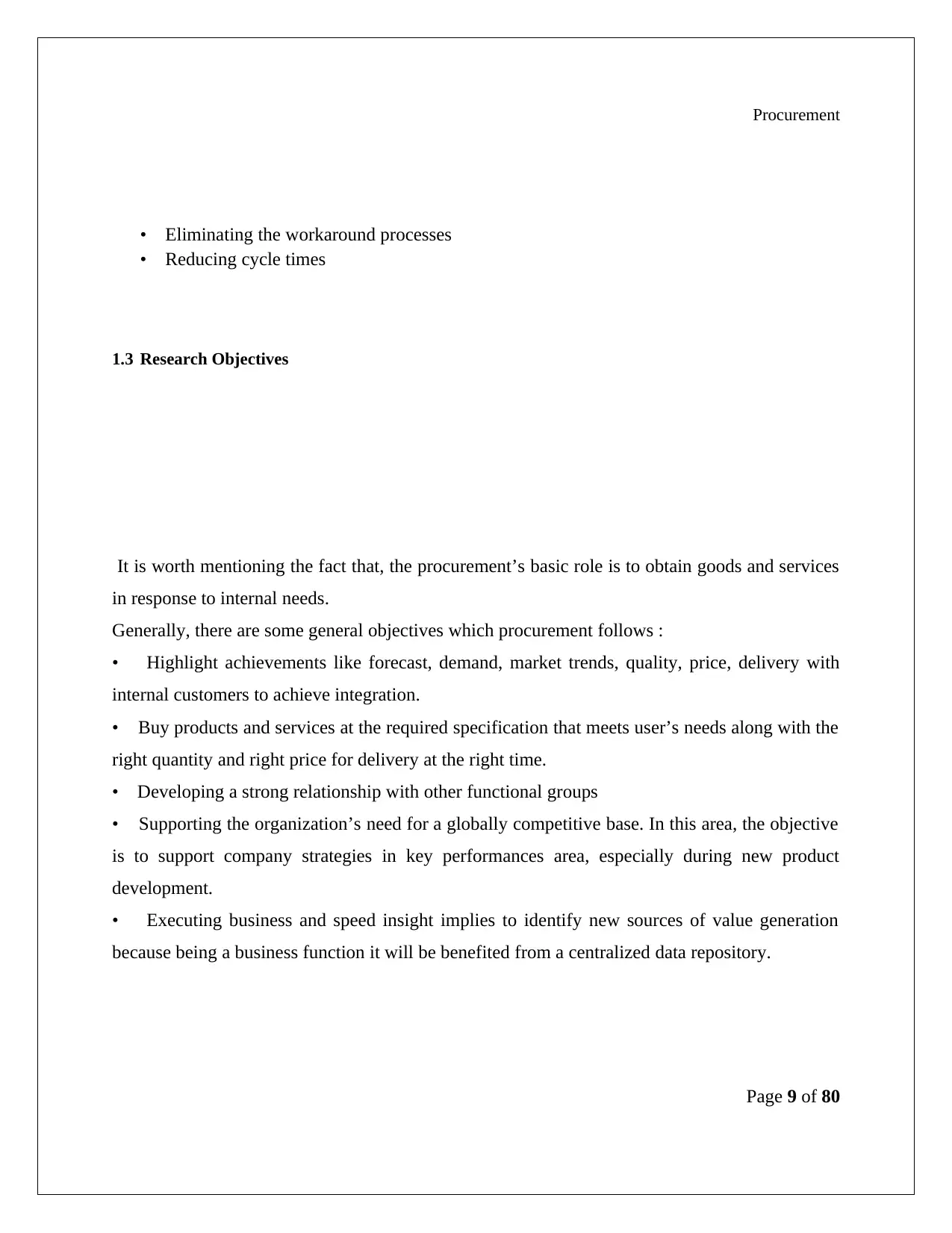
Procurement
• Eliminating the workaround processes
• Reducing cycle times
1.3 Research Objectives
It is worth mentioning the fact that, the procurement’s basic role is to obtain goods and services
in response to internal needs.
Generally, there are some general objectives which procurement follows :
• Highlight achievements like forecast, demand, market trends, quality, price, delivery with
internal customers to achieve integration.
• Buy products and services at the required specification that meets user’s needs along with the
right quantity and right price for delivery at the right time.
• Developing a strong relationship with other functional groups
• Supporting the organization’s need for a globally competitive base. In this area, the objective
is to support company strategies in key performances area, especially during new product
development.
• Executing business and speed insight implies to identify new sources of value generation
because being a business function it will be benefited from a centralized data repository.
Page 9 of 80
• Eliminating the workaround processes
• Reducing cycle times
1.3 Research Objectives
It is worth mentioning the fact that, the procurement’s basic role is to obtain goods and services
in response to internal needs.
Generally, there are some general objectives which procurement follows :
• Highlight achievements like forecast, demand, market trends, quality, price, delivery with
internal customers to achieve integration.
• Buy products and services at the required specification that meets user’s needs along with the
right quantity and right price for delivery at the right time.
• Developing a strong relationship with other functional groups
• Supporting the organization’s need for a globally competitive base. In this area, the objective
is to support company strategies in key performances area, especially during new product
development.
• Executing business and speed insight implies to identify new sources of value generation
because being a business function it will be benefited from a centralized data repository.
Page 9 of 80

Procurement
• One of the major objectives of procurement is a transition where the category managers will
involve in major purchases of a delivery model while the rest of the procurement would provide
purchasing assistance.
• The final procurement objective is the mix of the most resourceful advisors like excellent
technology focused on customer delight. To fulfill this achievement, organizations invest their
smart technology in their human capital and in technology. Because only a great technology can
improve customer is purchasing experience.
All the procurement objectives are understood the procurement principles since it all
encompasses the theory of effective procurement, transparency, non-discrimination,
competitiveness, accountability, confidentiality, and fairness.
1.4 Hypotheses
The hypothesis is an idea, which proposed as a required explanation to highlight all the
procurement strategies in major importance. The hypothesis generally highlights all procurement
strategies. These procurement strategies used to improve the organization’s profit, reduce raw
materials prices and costs, and identify the better source of supply. There are some
procurement’s strategic perspectives which have taken great importance in multinational
companies.
Page 10 of 80
• One of the major objectives of procurement is a transition where the category managers will
involve in major purchases of a delivery model while the rest of the procurement would provide
purchasing assistance.
• The final procurement objective is the mix of the most resourceful advisors like excellent
technology focused on customer delight. To fulfill this achievement, organizations invest their
smart technology in their human capital and in technology. Because only a great technology can
improve customer is purchasing experience.
All the procurement objectives are understood the procurement principles since it all
encompasses the theory of effective procurement, transparency, non-discrimination,
competitiveness, accountability, confidentiality, and fairness.
1.4 Hypotheses
The hypothesis is an idea, which proposed as a required explanation to highlight all the
procurement strategies in major importance. The hypothesis generally highlights all procurement
strategies. These procurement strategies used to improve the organization’s profit, reduce raw
materials prices and costs, and identify the better source of supply. There are some
procurement’s strategic perspectives which have taken great importance in multinational
companies.
Page 10 of 80
Secure Best Marks with AI Grader
Need help grading? Try our AI Grader for instant feedback on your assignments.
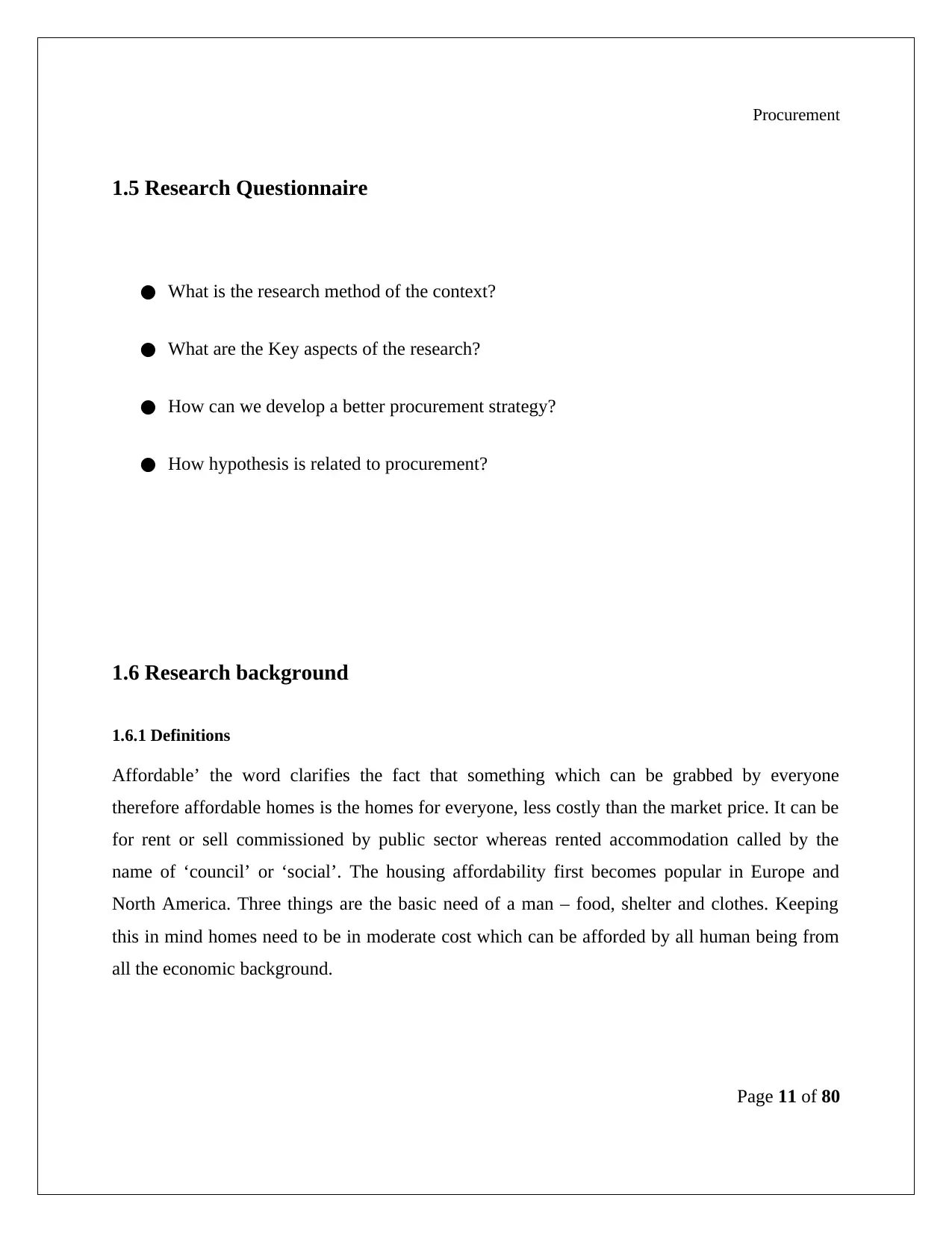
Procurement
1.5 Research Questionnaire
● What is the research method of the context?
● What are the Key aspects of the research?
● How can we develop a better procurement strategy?
● How hypothesis is related to procurement?
1.6 Research background
1.6.1 Definitions
Affordable’ the word clarifies the fact that something which can be grabbed by everyone
therefore affordable homes is the homes for everyone, less costly than the market price. It can be
for rent or sell commissioned by public sector whereas rented accommodation called by the
name of ‘council’ or ‘social’. The housing affordability first becomes popular in Europe and
North America. Three things are the basic need of a man – food, shelter and clothes. Keeping
this in mind homes need to be in moderate cost which can be afforded by all human being from
all the economic background.
Page 11 of 80
1.5 Research Questionnaire
● What is the research method of the context?
● What are the Key aspects of the research?
● How can we develop a better procurement strategy?
● How hypothesis is related to procurement?
1.6 Research background
1.6.1 Definitions
Affordable’ the word clarifies the fact that something which can be grabbed by everyone
therefore affordable homes is the homes for everyone, less costly than the market price. It can be
for rent or sell commissioned by public sector whereas rented accommodation called by the
name of ‘council’ or ‘social’. The housing affordability first becomes popular in Europe and
North America. Three things are the basic need of a man – food, shelter and clothes. Keeping
this in mind homes need to be in moderate cost which can be afforded by all human being from
all the economic background.
Page 11 of 80
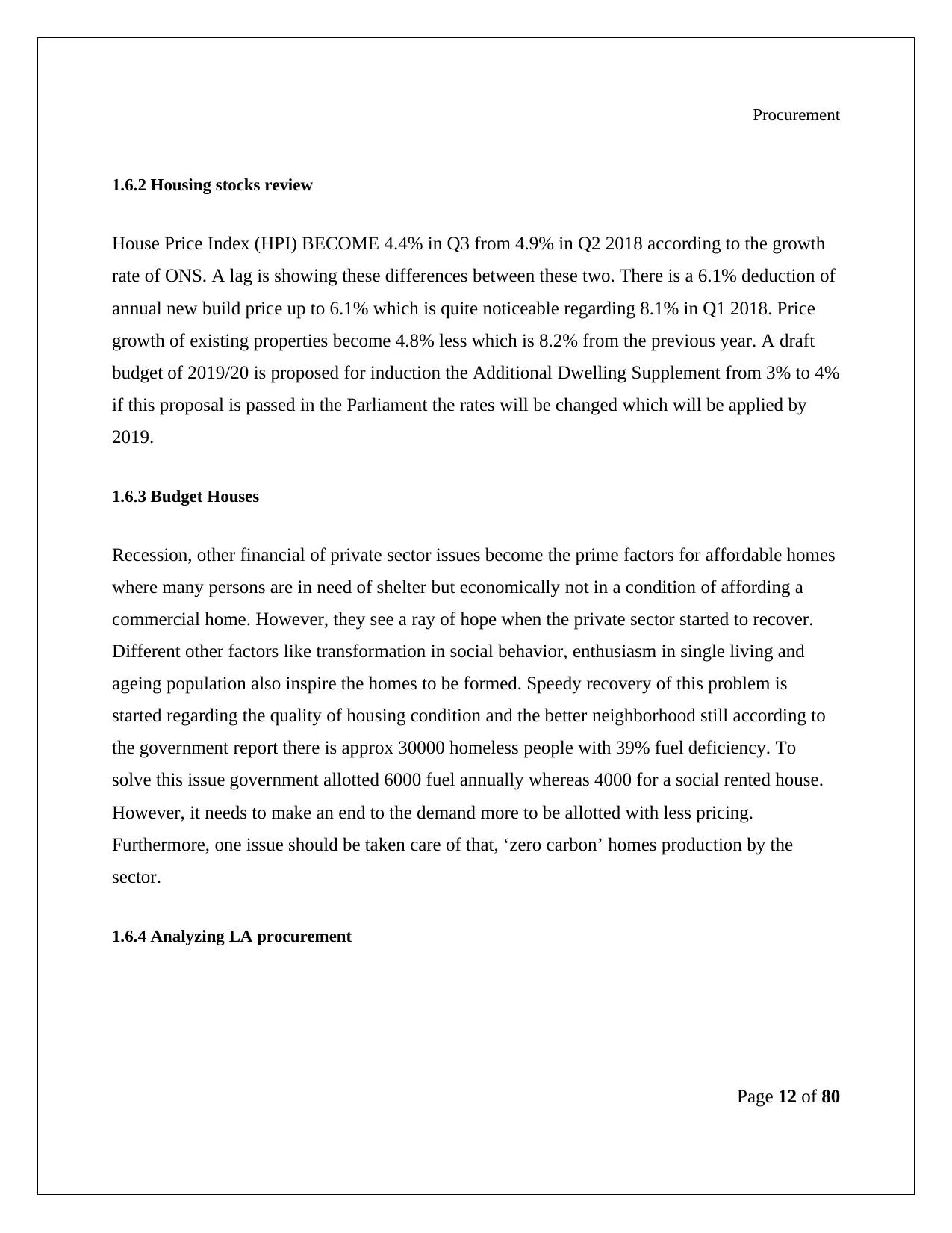
Procurement
1.6.2 Housing stocks review
House Price Index (HPI) BECOME 4.4% in Q3 from 4.9% in Q2 2018 according to the growth
rate of ONS. A lag is showing these differences between these two. There is a 6.1% deduction of
annual new build price up to 6.1% which is quite noticeable regarding 8.1% in Q1 2018. Price
growth of existing properties become 4.8% less which is 8.2% from the previous year. A draft
budget of 2019/20 is proposed for induction the Additional Dwelling Supplement from 3% to 4%
if this proposal is passed in the Parliament the rates will be changed which will be applied by
2019.
1.6.3 Budget Houses
Recession, other financial of private sector issues become the prime factors for affordable homes
where many persons are in need of shelter but economically not in a condition of affording a
commercial home. However, they see a ray of hope when the private sector started to recover.
Different other factors like transformation in social behavior, enthusiasm in single living and
ageing population also inspire the homes to be formed. Speedy recovery of this problem is
started regarding the quality of housing condition and the better neighborhood still according to
the government report there is approx 30000 homeless people with 39% fuel deficiency. To
solve this issue government allotted 6000 fuel annually whereas 4000 for a social rented house.
However, it needs to make an end to the demand more to be allotted with less pricing.
Furthermore, one issue should be taken care of that, ‘zero carbon’ homes production by the
sector.
1.6.4 Analyzing LA procurement
Page 12 of 80
1.6.2 Housing stocks review
House Price Index (HPI) BECOME 4.4% in Q3 from 4.9% in Q2 2018 according to the growth
rate of ONS. A lag is showing these differences between these two. There is a 6.1% deduction of
annual new build price up to 6.1% which is quite noticeable regarding 8.1% in Q1 2018. Price
growth of existing properties become 4.8% less which is 8.2% from the previous year. A draft
budget of 2019/20 is proposed for induction the Additional Dwelling Supplement from 3% to 4%
if this proposal is passed in the Parliament the rates will be changed which will be applied by
2019.
1.6.3 Budget Houses
Recession, other financial of private sector issues become the prime factors for affordable homes
where many persons are in need of shelter but economically not in a condition of affording a
commercial home. However, they see a ray of hope when the private sector started to recover.
Different other factors like transformation in social behavior, enthusiasm in single living and
ageing population also inspire the homes to be formed. Speedy recovery of this problem is
started regarding the quality of housing condition and the better neighborhood still according to
the government report there is approx 30000 homeless people with 39% fuel deficiency. To
solve this issue government allotted 6000 fuel annually whereas 4000 for a social rented house.
However, it needs to make an end to the demand more to be allotted with less pricing.
Furthermore, one issue should be taken care of that, ‘zero carbon’ homes production by the
sector.
1.6.4 Analyzing LA procurement
Page 12 of 80
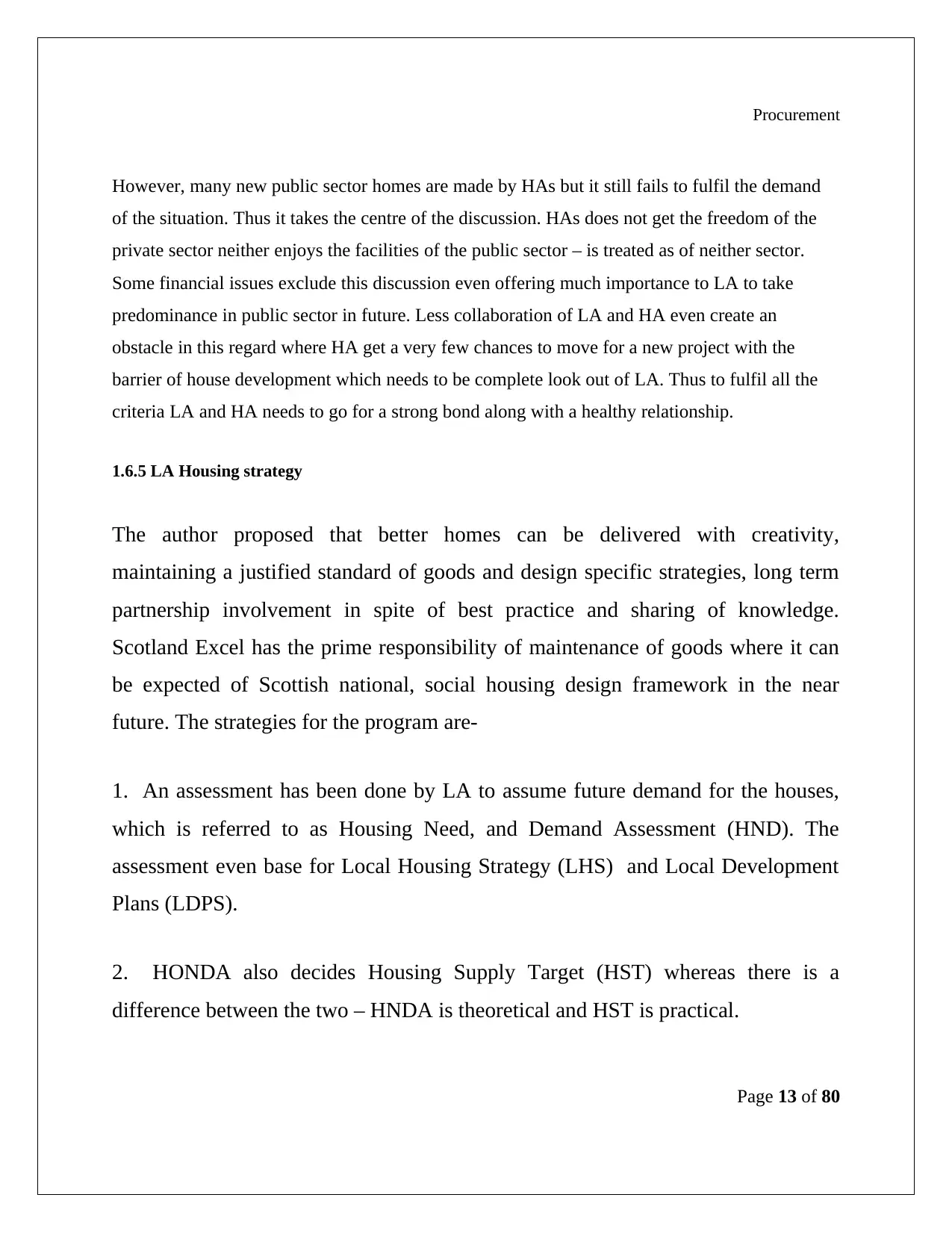
Procurement
However, many new public sector homes are made by HAs but it still fails to fulfil the demand
of the situation. Thus it takes the centre of the discussion. HAs does not get the freedom of the
private sector neither enjoys the facilities of the public sector – is treated as of neither sector.
Some financial issues exclude this discussion even offering much importance to LA to take
predominance in public sector in future. Less collaboration of LA and HA even create an
obstacle in this regard where HA get a very few chances to move for a new project with the
barrier of house development which needs to be complete look out of LA. Thus to fulfil all the
criteria LA and HA needs to go for a strong bond along with a healthy relationship.
1.6.5 LA Housing strategy
The author proposed that better homes can be delivered with creativity,
maintaining a justified standard of goods and design specific strategies, long term
partnership involvement in spite of best practice and sharing of knowledge.
Scotland Excel has the prime responsibility of maintenance of goods where it can
be expected of Scottish national, social housing design framework in the near
future. The strategies for the program are-
1. An assessment has been done by LA to assume future demand for the houses,
which is referred to as Housing Need, and Demand Assessment (HND). The
assessment even base for Local Housing Strategy (LHS) and Local Development
Plans (LDPS).
2. HONDA also decides Housing Supply Target (HST) whereas there is a
difference between the two – HNDA is theoretical and HST is practical.
Page 13 of 80
However, many new public sector homes are made by HAs but it still fails to fulfil the demand
of the situation. Thus it takes the centre of the discussion. HAs does not get the freedom of the
private sector neither enjoys the facilities of the public sector – is treated as of neither sector.
Some financial issues exclude this discussion even offering much importance to LA to take
predominance in public sector in future. Less collaboration of LA and HA even create an
obstacle in this regard where HA get a very few chances to move for a new project with the
barrier of house development which needs to be complete look out of LA. Thus to fulfil all the
criteria LA and HA needs to go for a strong bond along with a healthy relationship.
1.6.5 LA Housing strategy
The author proposed that better homes can be delivered with creativity,
maintaining a justified standard of goods and design specific strategies, long term
partnership involvement in spite of best practice and sharing of knowledge.
Scotland Excel has the prime responsibility of maintenance of goods where it can
be expected of Scottish national, social housing design framework in the near
future. The strategies for the program are-
1. An assessment has been done by LA to assume future demand for the houses,
which is referred to as Housing Need, and Demand Assessment (HND). The
assessment even base for Local Housing Strategy (LHS) and Local Development
Plans (LDPS).
2. HONDA also decides Housing Supply Target (HST) whereas there is a
difference between the two – HNDA is theoretical and HST is practical.
Page 13 of 80
Paraphrase This Document
Need a fresh take? Get an instant paraphrase of this document with our AI Paraphraser
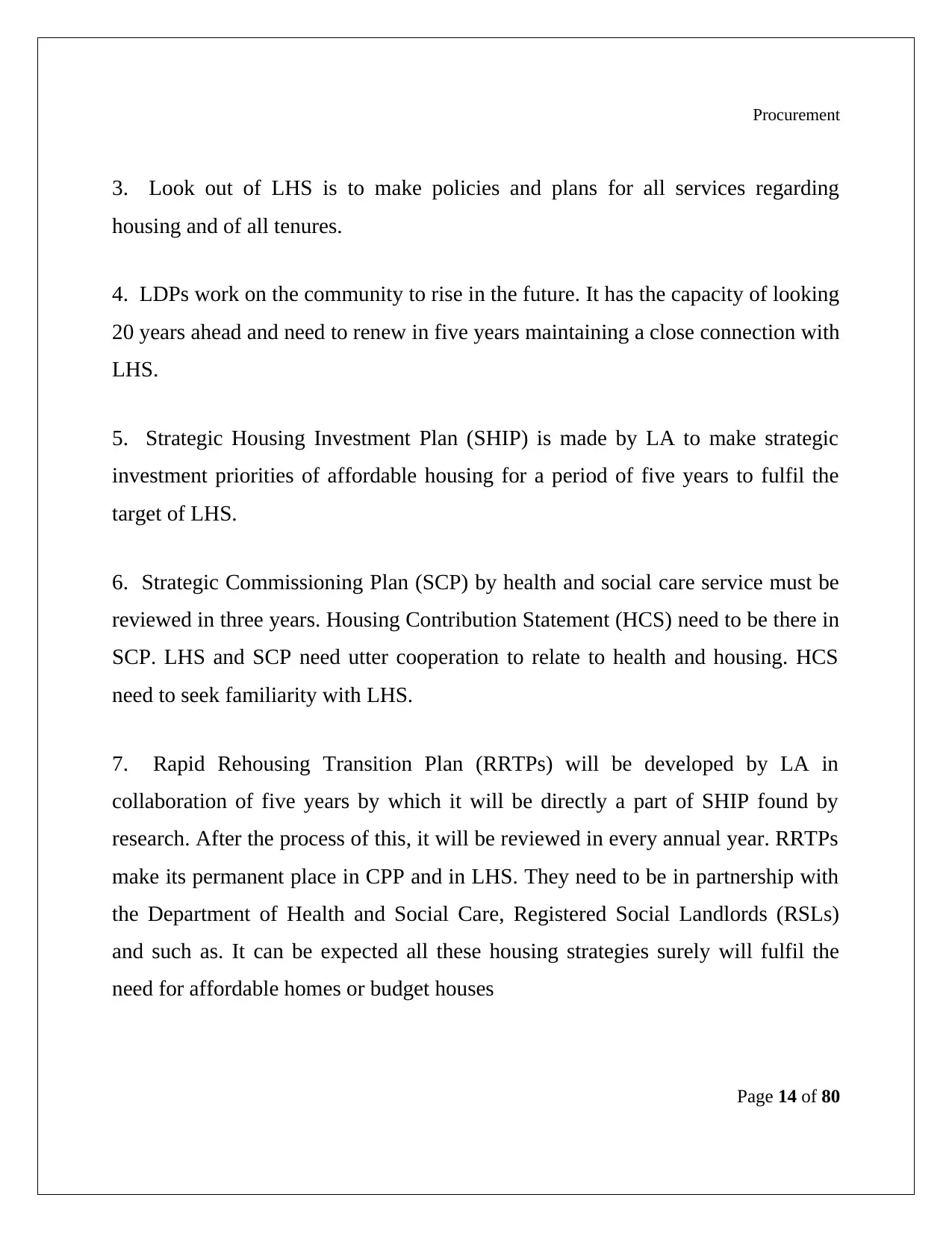
Procurement
3. Look out of LHS is to make policies and plans for all services regarding
housing and of all tenures.
4. LDPs work on the community to rise in the future. It has the capacity of looking
20 years ahead and need to renew in five years maintaining a close connection with
LHS.
5. Strategic Housing Investment Plan (SHIP) is made by LA to make strategic
investment priorities of affordable housing for a period of five years to fulfil the
target of LHS.
6. Strategic Commissioning Plan (SCP) by health and social care service must be
reviewed in three years. Housing Contribution Statement (HCS) need to be there in
SCP. LHS and SCP need utter cooperation to relate to health and housing. HCS
need to seek familiarity with LHS.
7. Rapid Rehousing Transition Plan (RRTPs) will be developed by LA in
collaboration of five years by which it will be directly a part of SHIP found by
research. After the process of this, it will be reviewed in every annual year. RRTPs
make its permanent place in CPP and in LHS. They need to be in partnership with
the Department of Health and Social Care, Registered Social Landlords (RSLs)
and such as. It can be expected all these housing strategies surely will fulfil the
need for affordable homes or budget houses
Page 14 of 80
3. Look out of LHS is to make policies and plans for all services regarding
housing and of all tenures.
4. LDPs work on the community to rise in the future. It has the capacity of looking
20 years ahead and need to renew in five years maintaining a close connection with
LHS.
5. Strategic Housing Investment Plan (SHIP) is made by LA to make strategic
investment priorities of affordable housing for a period of five years to fulfil the
target of LHS.
6. Strategic Commissioning Plan (SCP) by health and social care service must be
reviewed in three years. Housing Contribution Statement (HCS) need to be there in
SCP. LHS and SCP need utter cooperation to relate to health and housing. HCS
need to seek familiarity with LHS.
7. Rapid Rehousing Transition Plan (RRTPs) will be developed by LA in
collaboration of five years by which it will be directly a part of SHIP found by
research. After the process of this, it will be reviewed in every annual year. RRTPs
make its permanent place in CPP and in LHS. They need to be in partnership with
the Department of Health and Social Care, Registered Social Landlords (RSLs)
and such as. It can be expected all these housing strategies surely will fulfil the
need for affordable homes or budget houses
Page 14 of 80
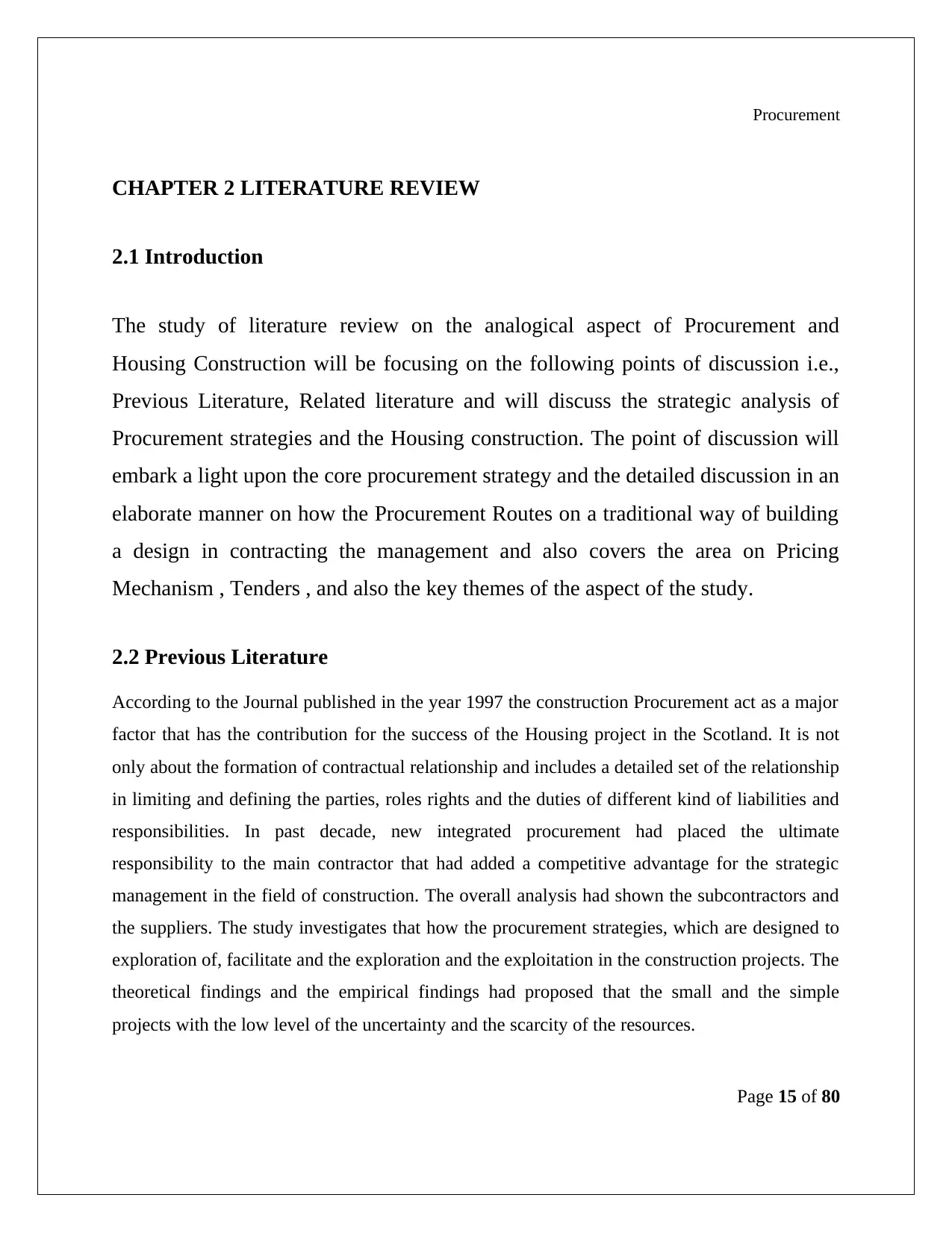
Procurement
CHAPTER 2 LITERATURE REVIEW
2.1 Introduction
The study of literature review on the analogical aspect of Procurement and
Housing Construction will be focusing on the following points of discussion i.e.,
Previous Literature, Related literature and will discuss the strategic analysis of
Procurement strategies and the Housing construction. The point of discussion will
embark a light upon the core procurement strategy and the detailed discussion in an
elaborate manner on how the Procurement Routes on a traditional way of building
a design in contracting the management and also covers the area on Pricing
Mechanism , Tenders , and also the key themes of the aspect of the study.
2.2 Previous Literature
According to the Journal published in the year 1997 the construction Procurement act as a major
factor that has the contribution for the success of the Housing project in the Scotland. It is not
only about the formation of contractual relationship and includes a detailed set of the relationship
in limiting and defining the parties, roles rights and the duties of different kind of liabilities and
responsibilities. In past decade, new integrated procurement had placed the ultimate
responsibility to the main contractor that had added a competitive advantage for the strategic
management in the field of construction. The overall analysis had shown the subcontractors and
the suppliers. The study investigates that how the procurement strategies, which are designed to
exploration of, facilitate and the exploration and the exploitation in the construction projects. The
theoretical findings and the empirical findings had proposed that the small and the simple
projects with the low level of the uncertainty and the scarcity of the resources.
Page 15 of 80
CHAPTER 2 LITERATURE REVIEW
2.1 Introduction
The study of literature review on the analogical aspect of Procurement and
Housing Construction will be focusing on the following points of discussion i.e.,
Previous Literature, Related literature and will discuss the strategic analysis of
Procurement strategies and the Housing construction. The point of discussion will
embark a light upon the core procurement strategy and the detailed discussion in an
elaborate manner on how the Procurement Routes on a traditional way of building
a design in contracting the management and also covers the area on Pricing
Mechanism , Tenders , and also the key themes of the aspect of the study.
2.2 Previous Literature
According to the Journal published in the year 1997 the construction Procurement act as a major
factor that has the contribution for the success of the Housing project in the Scotland. It is not
only about the formation of contractual relationship and includes a detailed set of the relationship
in limiting and defining the parties, roles rights and the duties of different kind of liabilities and
responsibilities. In past decade, new integrated procurement had placed the ultimate
responsibility to the main contractor that had added a competitive advantage for the strategic
management in the field of construction. The overall analysis had shown the subcontractors and
the suppliers. The study investigates that how the procurement strategies, which are designed to
exploration of, facilitate and the exploration and the exploitation in the construction projects. The
theoretical findings and the empirical findings had proposed that the small and the simple
projects with the low level of the uncertainty and the scarcity of the resources.
Page 15 of 80

Procurement
2.3 Related Literature
According to the journal and the study of the different past theoretical part, it had been presumed
that the process of Procurement had been defined around the milestones, which needs to
achievable for the successful completion of the project (Walker, and Brammer, 2009). These are
also referred to as Designing Buildings as the assessment of the need that is required for the
procurement. The feasibility study had been conducted so that the assessed the options through
the brief strategies. The development of conceptual design and the design done on the detail and
scrutinize the effect of the design. The procurement routes selection for time aspects, cost
quality, tendering of process and engrossment contract, in the delivery of the project.
2.3.2 Procurement Strategy
2.3.3 Definitions
A general definition of the Procurement is the process where the service and the goods are
generated from the following paths for the implementation of the business in the housing sector.
2.3.4 Best practice illusion
The evolution of the procurement from the beginning had started with a traditional approach in
the contracting management lately it focuses on the build and the design. The organizational and
evolution based on the concept from time to time. The strategy developed for the selection of the
right procurement system. Project cost and duration need to be designed to be completed before
the design of the tender. The relationship of the parties involved that control the function and
organizes the management of the project management that are hugely affected by the nomination
of various subcontractors that also had a direct impact on the Procurement Project (Leird., 2017).
The difference in the design and the issues related to the separation is the negative aspect for the
designer contractor which is the root cause of the damages of the project performance (Allock.,
Page 16 of 80
2.3 Related Literature
According to the journal and the study of the different past theoretical part, it had been presumed
that the process of Procurement had been defined around the milestones, which needs to
achievable for the successful completion of the project (Walker, and Brammer, 2009). These are
also referred to as Designing Buildings as the assessment of the need that is required for the
procurement. The feasibility study had been conducted so that the assessed the options through
the brief strategies. The development of conceptual design and the design done on the detail and
scrutinize the effect of the design. The procurement routes selection for time aspects, cost
quality, tendering of process and engrossment contract, in the delivery of the project.
2.3.2 Procurement Strategy
2.3.3 Definitions
A general definition of the Procurement is the process where the service and the goods are
generated from the following paths for the implementation of the business in the housing sector.
2.3.4 Best practice illusion
The evolution of the procurement from the beginning had started with a traditional approach in
the contracting management lately it focuses on the build and the design. The organizational and
evolution based on the concept from time to time. The strategy developed for the selection of the
right procurement system. Project cost and duration need to be designed to be completed before
the design of the tender. The relationship of the parties involved that control the function and
organizes the management of the project management that are hugely affected by the nomination
of various subcontractors that also had a direct impact on the Procurement Project (Leird., 2017).
The difference in the design and the issues related to the separation is the negative aspect for the
designer contractor which is the root cause of the damages of the project performance (Allock.,
Page 16 of 80
Secure Best Marks with AI Grader
Need help grading? Try our AI Grader for instant feedback on your assignments.
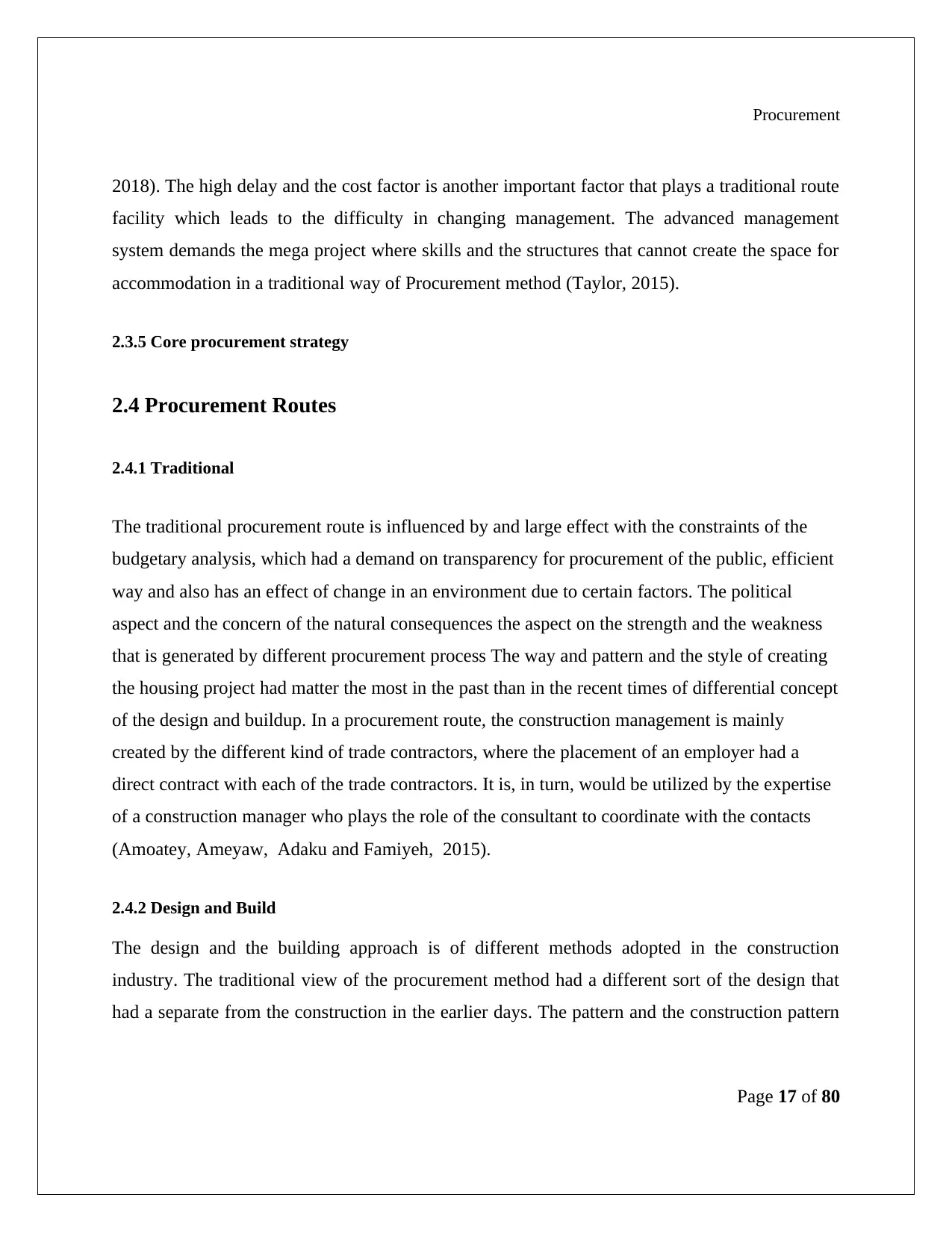
Procurement
2018). The high delay and the cost factor is another important factor that plays a traditional route
facility which leads to the difficulty in changing management. The advanced management
system demands the mega project where skills and the structures that cannot create the space for
accommodation in a traditional way of Procurement method (Taylor, 2015).
2.3.5 Core procurement strategy
2.4 Procurement Routes
2.4.1 Traditional
The traditional procurement route is influenced by and large effect with the constraints of the
budgetary analysis, which had a demand on transparency for procurement of the public, efficient
way and also has an effect of change in an environment due to certain factors. The political
aspect and the concern of the natural consequences the aspect on the strength and the weakness
that is generated by different procurement process The way and pattern and the style of creating
the housing project had matter the most in the past than in the recent times of differential concept
of the design and buildup. In a procurement route, the construction management is mainly
created by the different kind of trade contractors, where the placement of an employer had a
direct contract with each of the trade contractors. It is, in turn, would be utilized by the expertise
of a construction manager who plays the role of the consultant to coordinate with the contacts
(Amoatey, Ameyaw, Adaku and Famiyeh, 2015).
2.4.2 Design and Build
The design and the building approach is of different methods adopted in the construction
industry. The traditional view of the procurement method had a different sort of the design that
had a separate from the construction in the earlier days. The pattern and the construction pattern
Page 17 of 80
2018). The high delay and the cost factor is another important factor that plays a traditional route
facility which leads to the difficulty in changing management. The advanced management
system demands the mega project where skills and the structures that cannot create the space for
accommodation in a traditional way of Procurement method (Taylor, 2015).
2.3.5 Core procurement strategy
2.4 Procurement Routes
2.4.1 Traditional
The traditional procurement route is influenced by and large effect with the constraints of the
budgetary analysis, which had a demand on transparency for procurement of the public, efficient
way and also has an effect of change in an environment due to certain factors. The political
aspect and the concern of the natural consequences the aspect on the strength and the weakness
that is generated by different procurement process The way and pattern and the style of creating
the housing project had matter the most in the past than in the recent times of differential concept
of the design and buildup. In a procurement route, the construction management is mainly
created by the different kind of trade contractors, where the placement of an employer had a
direct contract with each of the trade contractors. It is, in turn, would be utilized by the expertise
of a construction manager who plays the role of the consultant to coordinate with the contacts
(Amoatey, Ameyaw, Adaku and Famiyeh, 2015).
2.4.2 Design and Build
The design and the building approach is of different methods adopted in the construction
industry. The traditional view of the procurement method had a different sort of the design that
had a separate from the construction in the earlier days. The pattern and the construction pattern
Page 17 of 80
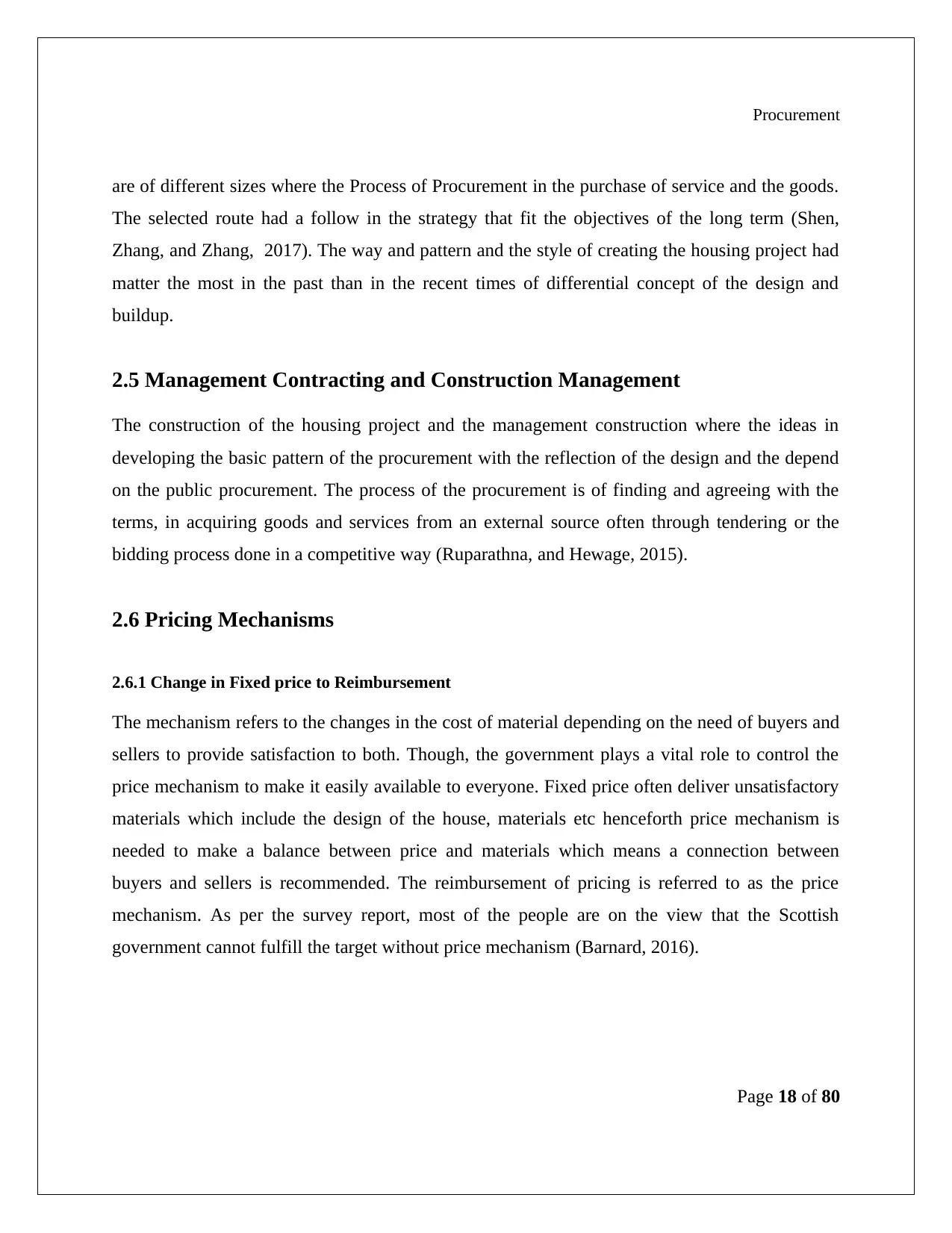
Procurement
are of different sizes where the Process of Procurement in the purchase of service and the goods.
The selected route had a follow in the strategy that fit the objectives of the long term (Shen,
Zhang, and Zhang, 2017). The way and pattern and the style of creating the housing project had
matter the most in the past than in the recent times of differential concept of the design and
buildup.
2.5 Management Contracting and Construction Management
The construction of the housing project and the management construction where the ideas in
developing the basic pattern of the procurement with the reflection of the design and the depend
on the public procurement. The process of the procurement is of finding and agreeing with the
terms, in acquiring goods and services from an external source often through tendering or the
bidding process done in a competitive way (Ruparathna, and Hewage, 2015).
2.6 Pricing Mechanisms
2.6.1 Change in Fixed price to Reimbursement
The mechanism refers to the changes in the cost of material depending on the need of buyers and
sellers to provide satisfaction to both. Though, the government plays a vital role to control the
price mechanism to make it easily available to everyone. Fixed price often deliver unsatisfactory
materials which include the design of the house, materials etc henceforth price mechanism is
needed to make a balance between price and materials which means a connection between
buyers and sellers is recommended. The reimbursement of pricing is referred to as the price
mechanism. As per the survey report, most of the people are on the view that the Scottish
government cannot fulfill the target without price mechanism (Barnard, 2016).
Page 18 of 80
are of different sizes where the Process of Procurement in the purchase of service and the goods.
The selected route had a follow in the strategy that fit the objectives of the long term (Shen,
Zhang, and Zhang, 2017). The way and pattern and the style of creating the housing project had
matter the most in the past than in the recent times of differential concept of the design and
buildup.
2.5 Management Contracting and Construction Management
The construction of the housing project and the management construction where the ideas in
developing the basic pattern of the procurement with the reflection of the design and the depend
on the public procurement. The process of the procurement is of finding and agreeing with the
terms, in acquiring goods and services from an external source often through tendering or the
bidding process done in a competitive way (Ruparathna, and Hewage, 2015).
2.6 Pricing Mechanisms
2.6.1 Change in Fixed price to Reimbursement
The mechanism refers to the changes in the cost of material depending on the need of buyers and
sellers to provide satisfaction to both. Though, the government plays a vital role to control the
price mechanism to make it easily available to everyone. Fixed price often deliver unsatisfactory
materials which include the design of the house, materials etc henceforth price mechanism is
needed to make a balance between price and materials which means a connection between
buyers and sellers is recommended. The reimbursement of pricing is referred to as the price
mechanism. As per the survey report, most of the people are on the view that the Scottish
government cannot fulfill the target without price mechanism (Barnard, 2016).
Page 18 of 80
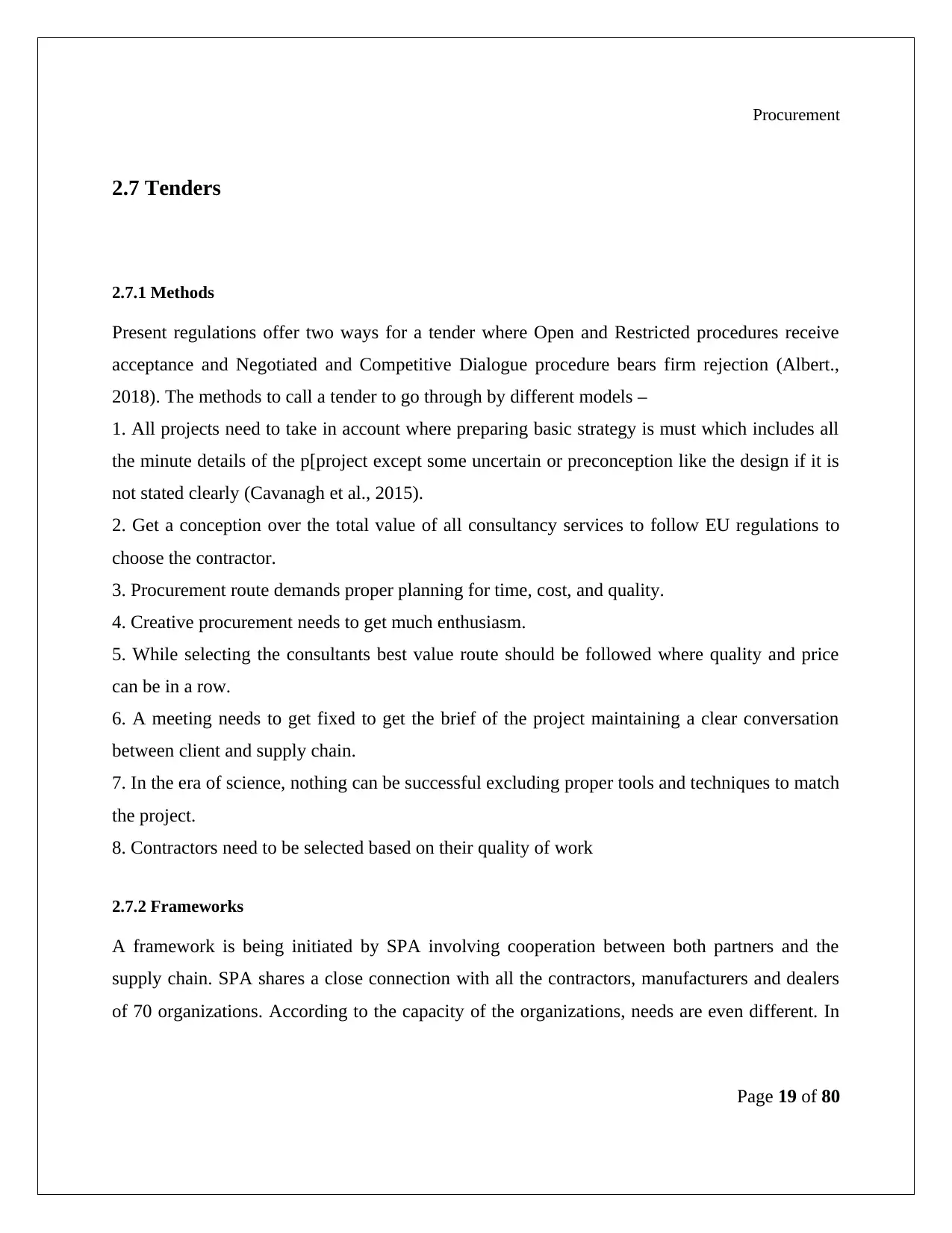
Procurement
2.7 Tenders
2.7.1 Methods
Present regulations offer two ways for a tender where Open and Restricted procedures receive
acceptance and Negotiated and Competitive Dialogue procedure bears firm rejection (Albert.,
2018). The methods to call a tender to go through by different models –
1. All projects need to take in account where preparing basic strategy is must which includes all
the minute details of the p[project except some uncertain or preconception like the design if it is
not stated clearly (Cavanagh et al., 2015).
2. Get a conception over the total value of all consultancy services to follow EU regulations to
choose the contractor.
3. Procurement route demands proper planning for time, cost, and quality.
4. Creative procurement needs to get much enthusiasm.
5. While selecting the consultants best value route should be followed where quality and price
can be in a row.
6. A meeting needs to get fixed to get the brief of the project maintaining a clear conversation
between client and supply chain.
7. In the era of science, nothing can be successful excluding proper tools and techniques to match
the project.
8. Contractors need to be selected based on their quality of work
2.7.2 Frameworks
A framework is being initiated by SPA involving cooperation between both partners and the
supply chain. SPA shares a close connection with all the contractors, manufacturers and dealers
of 70 organizations. According to the capacity of the organizations, needs are even different. In
Page 19 of 80
2.7 Tenders
2.7.1 Methods
Present regulations offer two ways for a tender where Open and Restricted procedures receive
acceptance and Negotiated and Competitive Dialogue procedure bears firm rejection (Albert.,
2018). The methods to call a tender to go through by different models –
1. All projects need to take in account where preparing basic strategy is must which includes all
the minute details of the p[project except some uncertain or preconception like the design if it is
not stated clearly (Cavanagh et al., 2015).
2. Get a conception over the total value of all consultancy services to follow EU regulations to
choose the contractor.
3. Procurement route demands proper planning for time, cost, and quality.
4. Creative procurement needs to get much enthusiasm.
5. While selecting the consultants best value route should be followed where quality and price
can be in a row.
6. A meeting needs to get fixed to get the brief of the project maintaining a clear conversation
between client and supply chain.
7. In the era of science, nothing can be successful excluding proper tools and techniques to match
the project.
8. Contractors need to be selected based on their quality of work
2.7.2 Frameworks
A framework is being initiated by SPA involving cooperation between both partners and the
supply chain. SPA shares a close connection with all the contractors, manufacturers and dealers
of 70 organizations. According to the capacity of the organizations, needs are even different. In
Page 19 of 80
Paraphrase This Document
Need a fresh take? Get an instant paraphrase of this document with our AI Paraphraser
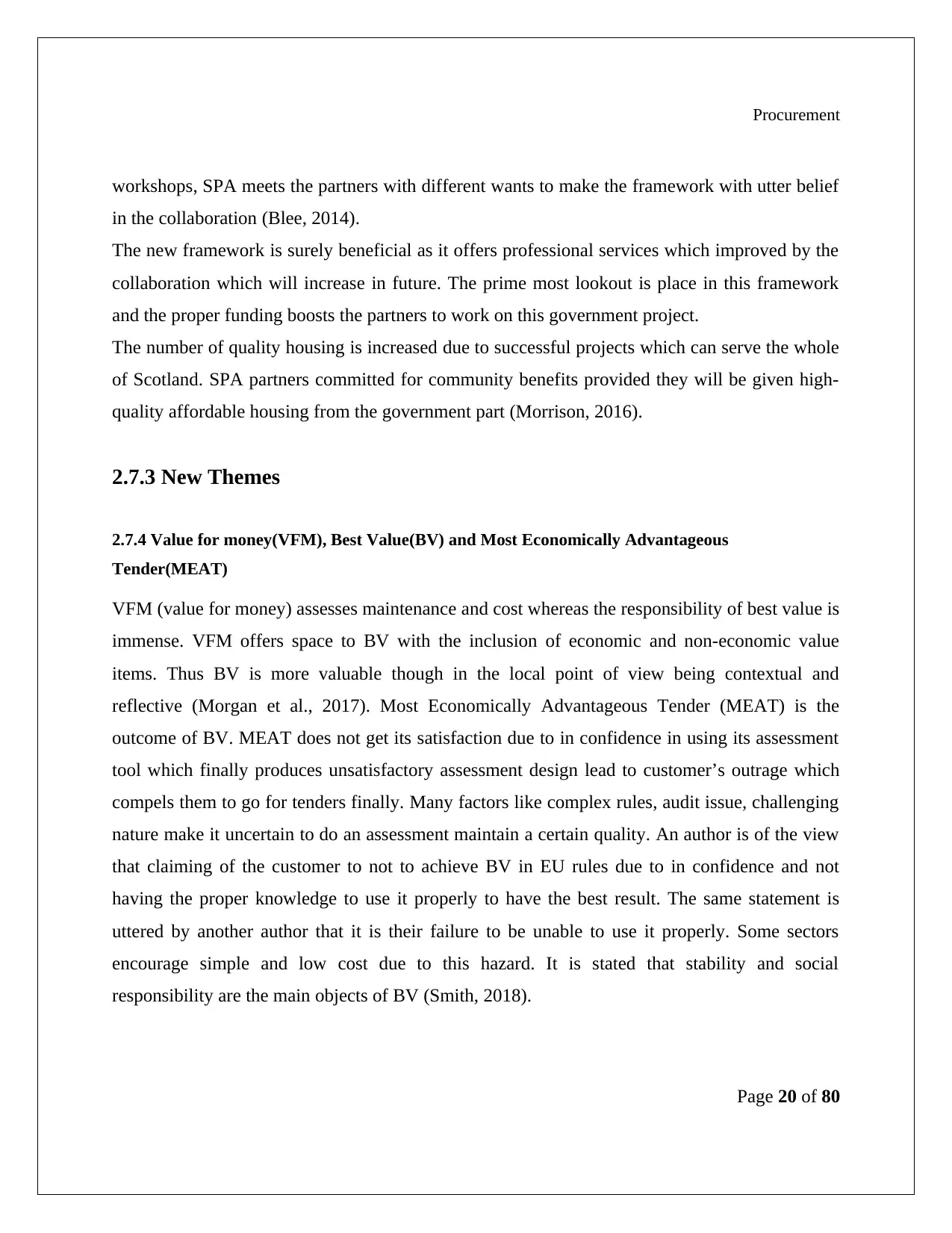
Procurement
workshops, SPA meets the partners with different wants to make the framework with utter belief
in the collaboration (Blee, 2014).
The new framework is surely beneficial as it offers professional services which improved by the
collaboration which will increase in future. The prime most lookout is place in this framework
and the proper funding boosts the partners to work on this government project.
The number of quality housing is increased due to successful projects which can serve the whole
of Scotland. SPA partners committed for community benefits provided they will be given high-
quality affordable housing from the government part (Morrison, 2016).
2.7.3 New Themes
2.7.4 Value for money(VFM), Best Value(BV) and Most Economically Advantageous
Tender(MEAT)
VFM (value for money) assesses maintenance and cost whereas the responsibility of best value is
immense. VFM offers space to BV with the inclusion of economic and non-economic value
items. Thus BV is more valuable though in the local point of view being contextual and
reflective (Morgan et al., 2017). Most Economically Advantageous Tender (MEAT) is the
outcome of BV. MEAT does not get its satisfaction due to in confidence in using its assessment
tool which finally produces unsatisfactory assessment design lead to customer’s outrage which
compels them to go for tenders finally. Many factors like complex rules, audit issue, challenging
nature make it uncertain to do an assessment maintain a certain quality. An author is of the view
that claiming of the customer to not to achieve BV in EU rules due to in confidence and not
having the proper knowledge to use it properly to have the best result. The same statement is
uttered by another author that it is their failure to be unable to use it properly. Some sectors
encourage simple and low cost due to this hazard. It is stated that stability and social
responsibility are the main objects of BV (Smith, 2018).
Page 20 of 80
workshops, SPA meets the partners with different wants to make the framework with utter belief
in the collaboration (Blee, 2014).
The new framework is surely beneficial as it offers professional services which improved by the
collaboration which will increase in future. The prime most lookout is place in this framework
and the proper funding boosts the partners to work on this government project.
The number of quality housing is increased due to successful projects which can serve the whole
of Scotland. SPA partners committed for community benefits provided they will be given high-
quality affordable housing from the government part (Morrison, 2016).
2.7.3 New Themes
2.7.4 Value for money(VFM), Best Value(BV) and Most Economically Advantageous
Tender(MEAT)
VFM (value for money) assesses maintenance and cost whereas the responsibility of best value is
immense. VFM offers space to BV with the inclusion of economic and non-economic value
items. Thus BV is more valuable though in the local point of view being contextual and
reflective (Morgan et al., 2017). Most Economically Advantageous Tender (MEAT) is the
outcome of BV. MEAT does not get its satisfaction due to in confidence in using its assessment
tool which finally produces unsatisfactory assessment design lead to customer’s outrage which
compels them to go for tenders finally. Many factors like complex rules, audit issue, challenging
nature make it uncertain to do an assessment maintain a certain quality. An author is of the view
that claiming of the customer to not to achieve BV in EU rules due to in confidence and not
having the proper knowledge to use it properly to have the best result. The same statement is
uttered by another author that it is their failure to be unable to use it properly. Some sectors
encourage simple and low cost due to this hazard. It is stated that stability and social
responsibility are the main objects of BV (Smith, 2018).
Page 20 of 80
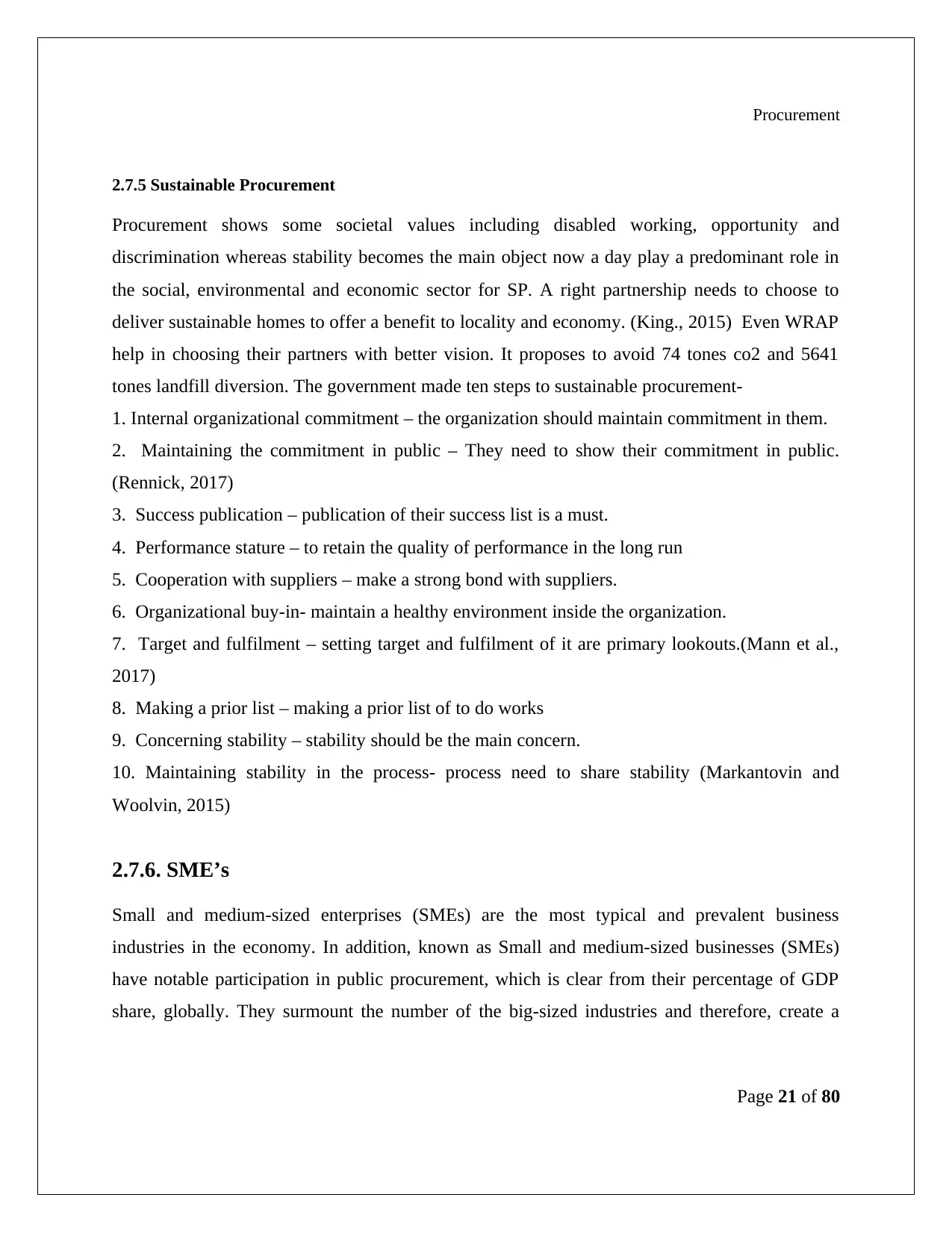
Procurement
2.7.5 Sustainable Procurement
Procurement shows some societal values including disabled working, opportunity and
discrimination whereas stability becomes the main object now a day play a predominant role in
the social, environmental and economic sector for SP. A right partnership needs to choose to
deliver sustainable homes to offer a benefit to locality and economy. (King., 2015) Even WRAP
help in choosing their partners with better vision. It proposes to avoid 74 tones co2 and 5641
tones landfill diversion. The government made ten steps to sustainable procurement-
1. Internal organizational commitment – the organization should maintain commitment in them.
2. Maintaining the commitment in public – They need to show their commitment in public.
(Rennick, 2017)
3. Success publication – publication of their success list is a must.
4. Performance stature – to retain the quality of performance in the long run
5. Cooperation with suppliers – make a strong bond with suppliers.
6. Organizational buy-in- maintain a healthy environment inside the organization.
7. Target and fulfilment – setting target and fulfilment of it are primary lookouts.(Mann et al.,
2017)
8. Making a prior list – making a prior list of to do works
9. Concerning stability – stability should be the main concern.
10. Maintaining stability in the process- process need to share stability (Markantovin and
Woolvin, 2015)
2.7.6. SME’s
Small and medium-sized enterprises (SMEs) are the most typical and prevalent business
industries in the economy. In addition, known as Small and medium-sized businesses (SMEs)
have notable participation in public procurement, which is clear from their percentage of GDP
share, globally. They surmount the number of the big-sized industries and therefore, create a
Page 21 of 80
2.7.5 Sustainable Procurement
Procurement shows some societal values including disabled working, opportunity and
discrimination whereas stability becomes the main object now a day play a predominant role in
the social, environmental and economic sector for SP. A right partnership needs to choose to
deliver sustainable homes to offer a benefit to locality and economy. (King., 2015) Even WRAP
help in choosing their partners with better vision. It proposes to avoid 74 tones co2 and 5641
tones landfill diversion. The government made ten steps to sustainable procurement-
1. Internal organizational commitment – the organization should maintain commitment in them.
2. Maintaining the commitment in public – They need to show their commitment in public.
(Rennick, 2017)
3. Success publication – publication of their success list is a must.
4. Performance stature – to retain the quality of performance in the long run
5. Cooperation with suppliers – make a strong bond with suppliers.
6. Organizational buy-in- maintain a healthy environment inside the organization.
7. Target and fulfilment – setting target and fulfilment of it are primary lookouts.(Mann et al.,
2017)
8. Making a prior list – making a prior list of to do works
9. Concerning stability – stability should be the main concern.
10. Maintaining stability in the process- process need to share stability (Markantovin and
Woolvin, 2015)
2.7.6. SME’s
Small and medium-sized enterprises (SMEs) are the most typical and prevalent business
industries in the economy. In addition, known as Small and medium-sized businesses (SMEs)
have notable participation in public procurement, which is clear from their percentage of GDP
share, globally. They surmount the number of the big-sized industries and therefore, create a
Page 21 of 80

Procurement
larger amount of employment opportunities to people. They play a huge role in sowing seeds of
the initiative, creativity and absolute innovation among limited resourced people aspiring for
business, in the economy. People with restricted skill and knowledge have the opportunity to
enhance themselves and mobilize their talents for attaining beneficial targets. Across different
countries in the world, SMEs are gaining a considerable position. SMEs are evolving as a
leading business type over diverse sectors. They promote prosperity, globalisation as well as
economic sustainability. Participation of SMEs in public procurement is important. In the
construction sector, SMEs act as an impetus. Therefore, the future of construction depends
partially on the small and medium-sized enterprises also. But there might be a difficulty while
performing large scale construction projects. Some studies have shown that SMEs can help in the
growth and expansion of procurement and housing construction.
2.7.2 Community Benefits
Community benefits are those activities and requirements, which lead to the enhancement of
various portions of construction. It helps in building up powerful and secure communities.
Community benefits need to be considered in the Procurement and Housing construction. It
regulates proper tender prices and also supplies with subcontracting chances. There are several
benefits like provision of training opportunities in this sector. It also furnishes favourable
chances for employment to the desiring people. Compliance with policies and regulations lead to
the offering of community benefits. It also contributes to the education and cultivation. It creates
options for small and medium-sized enterprises to flourish (Mahamadu et al., 2018).
2.7.3 Construction Benefits
Modern Methods of Construction is to widen its capacity where performance-based work gets
much importance with honest outlook. It also beneficial as the development of innovative
approaches is initiated by Early Contractor Involvement (ECI) to increase the number of
Page 22 of 80
larger amount of employment opportunities to people. They play a huge role in sowing seeds of
the initiative, creativity and absolute innovation among limited resourced people aspiring for
business, in the economy. People with restricted skill and knowledge have the opportunity to
enhance themselves and mobilize their talents for attaining beneficial targets. Across different
countries in the world, SMEs are gaining a considerable position. SMEs are evolving as a
leading business type over diverse sectors. They promote prosperity, globalisation as well as
economic sustainability. Participation of SMEs in public procurement is important. In the
construction sector, SMEs act as an impetus. Therefore, the future of construction depends
partially on the small and medium-sized enterprises also. But there might be a difficulty while
performing large scale construction projects. Some studies have shown that SMEs can help in the
growth and expansion of procurement and housing construction.
2.7.2 Community Benefits
Community benefits are those activities and requirements, which lead to the enhancement of
various portions of construction. It helps in building up powerful and secure communities.
Community benefits need to be considered in the Procurement and Housing construction. It
regulates proper tender prices and also supplies with subcontracting chances. There are several
benefits like provision of training opportunities in this sector. It also furnishes favourable
chances for employment to the desiring people. Compliance with policies and regulations lead to
the offering of community benefits. It also contributes to the education and cultivation. It creates
options for small and medium-sized enterprises to flourish (Mahamadu et al., 2018).
2.7.3 Construction Benefits
Modern Methods of Construction is to widen its capacity where performance-based work gets
much importance with honest outlook. It also beneficial as the development of innovative
approaches is initiated by Early Contractor Involvement (ECI) to increase the number of
Page 22 of 80
Secure Best Marks with AI Grader
Need help grading? Try our AI Grader for instant feedback on your assignments.
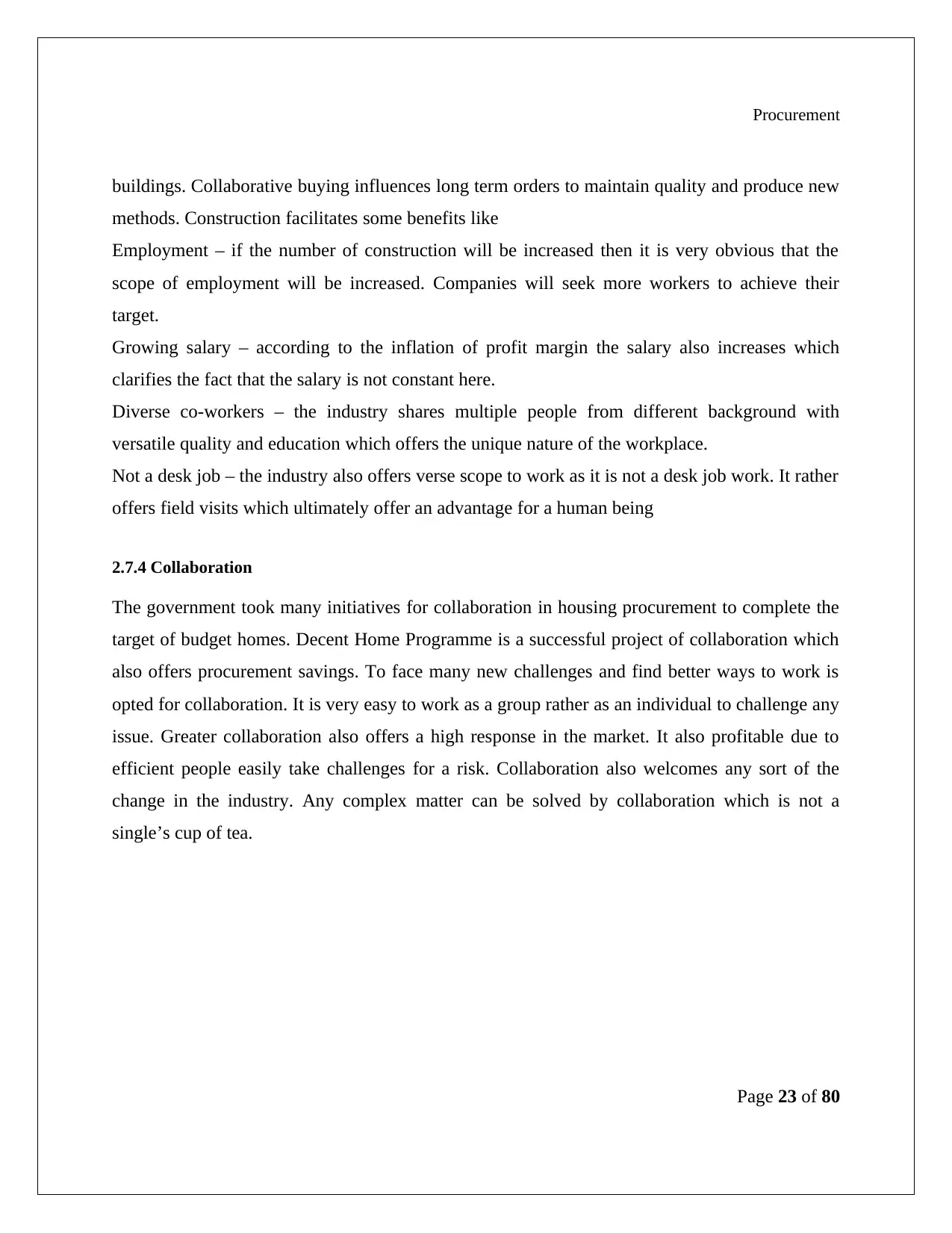
Procurement
buildings. Collaborative buying influences long term orders to maintain quality and produce new
methods. Construction facilitates some benefits like
Employment – if the number of construction will be increased then it is very obvious that the
scope of employment will be increased. Companies will seek more workers to achieve their
target.
Growing salary – according to the inflation of profit margin the salary also increases which
clarifies the fact that the salary is not constant here.
Diverse co-workers – the industry shares multiple people from different background with
versatile quality and education which offers the unique nature of the workplace.
Not a desk job – the industry also offers verse scope to work as it is not a desk job work. It rather
offers field visits which ultimately offer an advantage for a human being
2.7.4 Collaboration
The government took many initiatives for collaboration in housing procurement to complete the
target of budget homes. Decent Home Programme is a successful project of collaboration which
also offers procurement savings. To face many new challenges and find better ways to work is
opted for collaboration. It is very easy to work as a group rather as an individual to challenge any
issue. Greater collaboration also offers a high response in the market. It also profitable due to
efficient people easily take challenges for a risk. Collaboration also welcomes any sort of the
change in the industry. Any complex matter can be solved by collaboration which is not a
single’s cup of tea.
Page 23 of 80
buildings. Collaborative buying influences long term orders to maintain quality and produce new
methods. Construction facilitates some benefits like
Employment – if the number of construction will be increased then it is very obvious that the
scope of employment will be increased. Companies will seek more workers to achieve their
target.
Growing salary – according to the inflation of profit margin the salary also increases which
clarifies the fact that the salary is not constant here.
Diverse co-workers – the industry shares multiple people from different background with
versatile quality and education which offers the unique nature of the workplace.
Not a desk job – the industry also offers verse scope to work as it is not a desk job work. It rather
offers field visits which ultimately offer an advantage for a human being
2.7.4 Collaboration
The government took many initiatives for collaboration in housing procurement to complete the
target of budget homes. Decent Home Programme is a successful project of collaboration which
also offers procurement savings. To face many new challenges and find better ways to work is
opted for collaboration. It is very easy to work as a group rather as an individual to challenge any
issue. Greater collaboration also offers a high response in the market. It also profitable due to
efficient people easily take challenges for a risk. Collaboration also welcomes any sort of the
change in the industry. Any complex matter can be solved by collaboration which is not a
single’s cup of tea.
Page 23 of 80
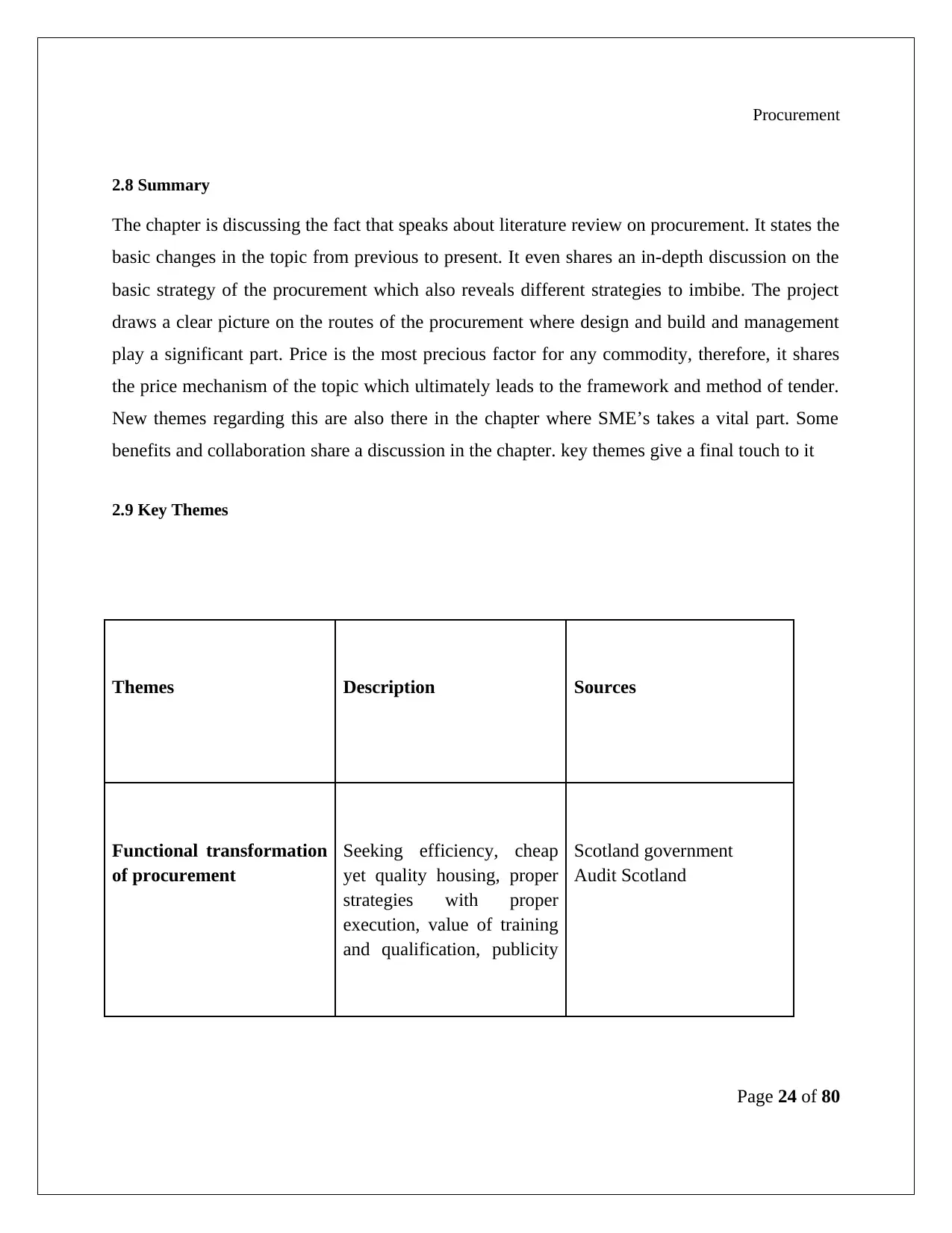
Procurement
2.8 Summary
The chapter is discussing the fact that speaks about literature review on procurement. It states the
basic changes in the topic from previous to present. It even shares an in-depth discussion on the
basic strategy of the procurement which also reveals different strategies to imbibe. The project
draws a clear picture on the routes of the procurement where design and build and management
play a significant part. Price is the most precious factor for any commodity, therefore, it shares
the price mechanism of the topic which ultimately leads to the framework and method of tender.
New themes regarding this are also there in the chapter where SME’s takes a vital part. Some
benefits and collaboration share a discussion in the chapter. key themes give a final touch to it
2.9 Key Themes
Themes Description Sources
Functional transformation
of procurement
Seeking efficiency, cheap
yet quality housing, proper
strategies with proper
execution, value of training
and qualification, publicity
Scotland government
Audit Scotland
Page 24 of 80
2.8 Summary
The chapter is discussing the fact that speaks about literature review on procurement. It states the
basic changes in the topic from previous to present. It even shares an in-depth discussion on the
basic strategy of the procurement which also reveals different strategies to imbibe. The project
draws a clear picture on the routes of the procurement where design and build and management
play a significant part. Price is the most precious factor for any commodity, therefore, it shares
the price mechanism of the topic which ultimately leads to the framework and method of tender.
New themes regarding this are also there in the chapter where SME’s takes a vital part. Some
benefits and collaboration share a discussion in the chapter. key themes give a final touch to it
2.9 Key Themes
Themes Description Sources
Functional transformation
of procurement
Seeking efficiency, cheap
yet quality housing, proper
strategies with proper
execution, value of training
and qualification, publicity
Scotland government
Audit Scotland
Page 24 of 80
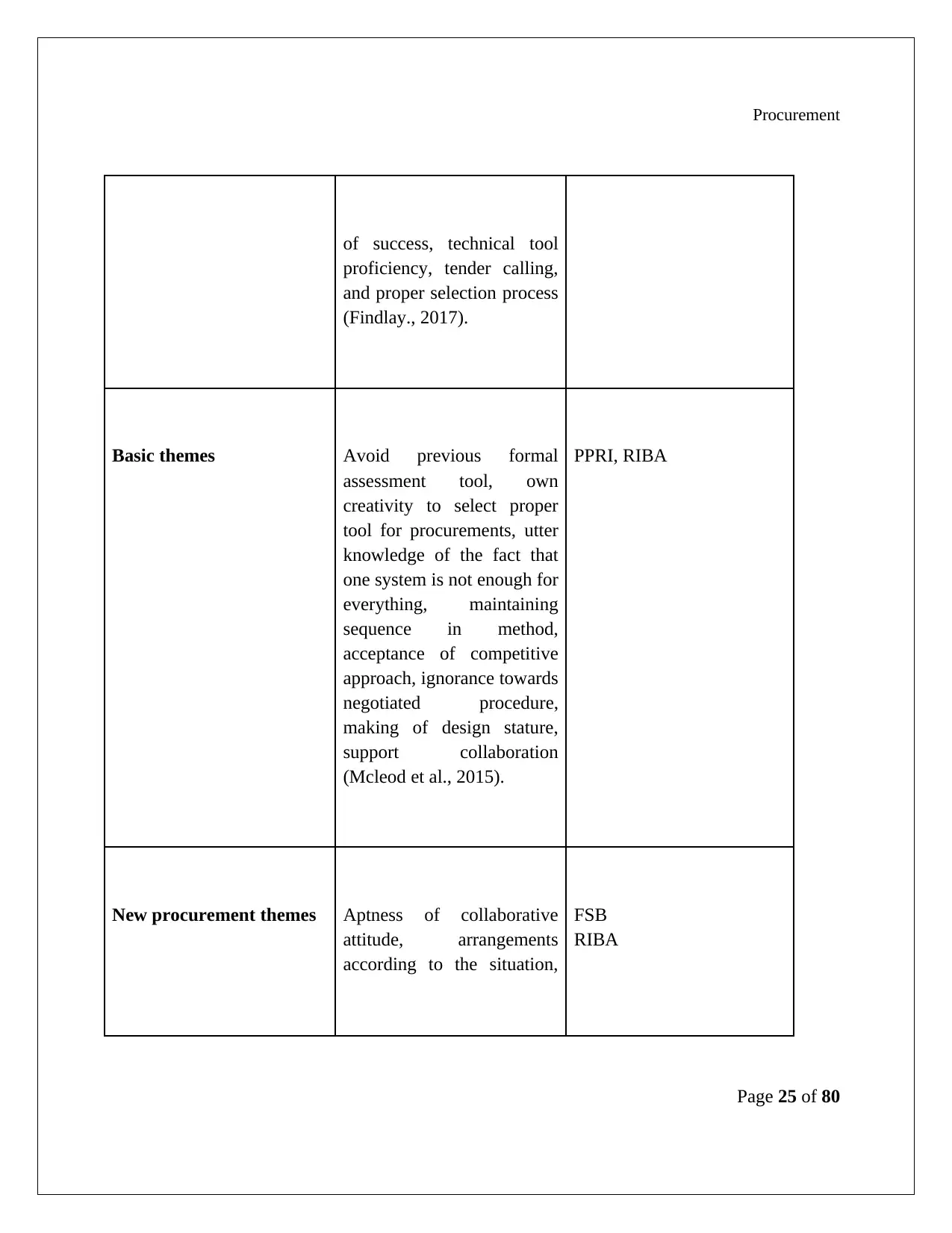
Procurement
of success, technical tool
proficiency, tender calling,
and proper selection process
(Findlay., 2017).
Basic themes Avoid previous formal
assessment tool, own
creativity to select proper
tool for procurements, utter
knowledge of the fact that
one system is not enough for
everything, maintaining
sequence in method,
acceptance of competitive
approach, ignorance towards
negotiated procedure,
making of design stature,
support collaboration
(Mcleod et al., 2015).
PPRI, RIBA
New procurement themes Aptness of collaborative
attitude, arrangements
according to the situation,
FSB
RIBA
Page 25 of 80
of success, technical tool
proficiency, tender calling,
and proper selection process
(Findlay., 2017).
Basic themes Avoid previous formal
assessment tool, own
creativity to select proper
tool for procurements, utter
knowledge of the fact that
one system is not enough for
everything, maintaining
sequence in method,
acceptance of competitive
approach, ignorance towards
negotiated procedure,
making of design stature,
support collaboration
(Mcleod et al., 2015).
PPRI, RIBA
New procurement themes Aptness of collaborative
attitude, arrangements
according to the situation,
FSB
RIBA
Page 25 of 80
Paraphrase This Document
Need a fresh take? Get an instant paraphrase of this document with our AI Paraphraser
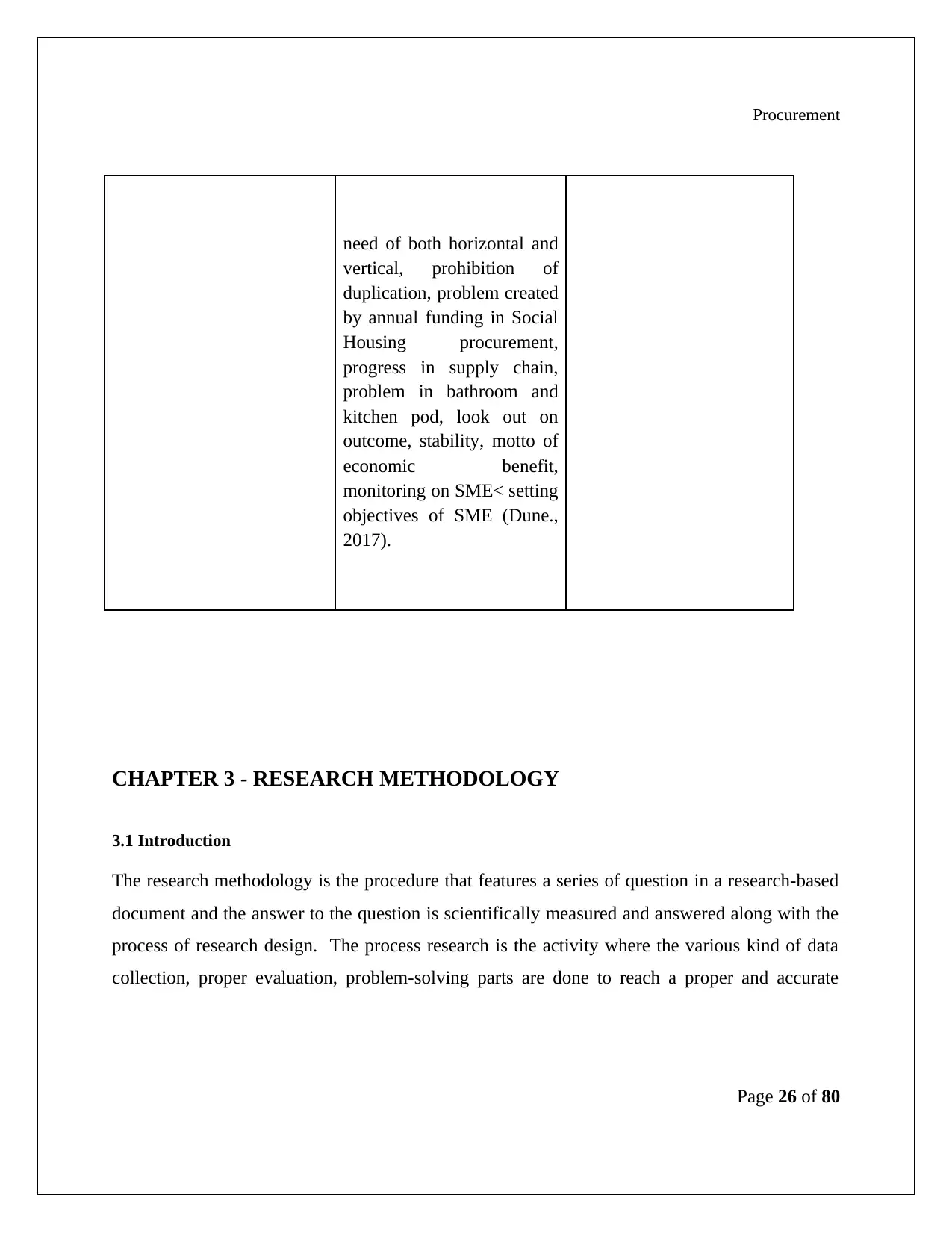
Procurement
need of both horizontal and
vertical, prohibition of
duplication, problem created
by annual funding in Social
Housing procurement,
progress in supply chain,
problem in bathroom and
kitchen pod, look out on
outcome, stability, motto of
economic benefit,
monitoring on SME< setting
objectives of SME (Dune.,
2017).
CHAPTER 3 - RESEARCH METHODOLOGY
3.1 Introduction
The research methodology is the procedure that features a series of question in a research-based
document and the answer to the question is scientifically measured and answered along with the
process of research design. The process research is the activity where the various kind of data
collection, proper evaluation, problem-solving parts are done to reach a proper and accurate
Page 26 of 80
need of both horizontal and
vertical, prohibition of
duplication, problem created
by annual funding in Social
Housing procurement,
progress in supply chain,
problem in bathroom and
kitchen pod, look out on
outcome, stability, motto of
economic benefit,
monitoring on SME< setting
objectives of SME (Dune.,
2017).
CHAPTER 3 - RESEARCH METHODOLOGY
3.1 Introduction
The research methodology is the procedure that features a series of question in a research-based
document and the answer to the question is scientifically measured and answered along with the
process of research design. The process research is the activity where the various kind of data
collection, proper evaluation, problem-solving parts are done to reach a proper and accurate
Page 26 of 80
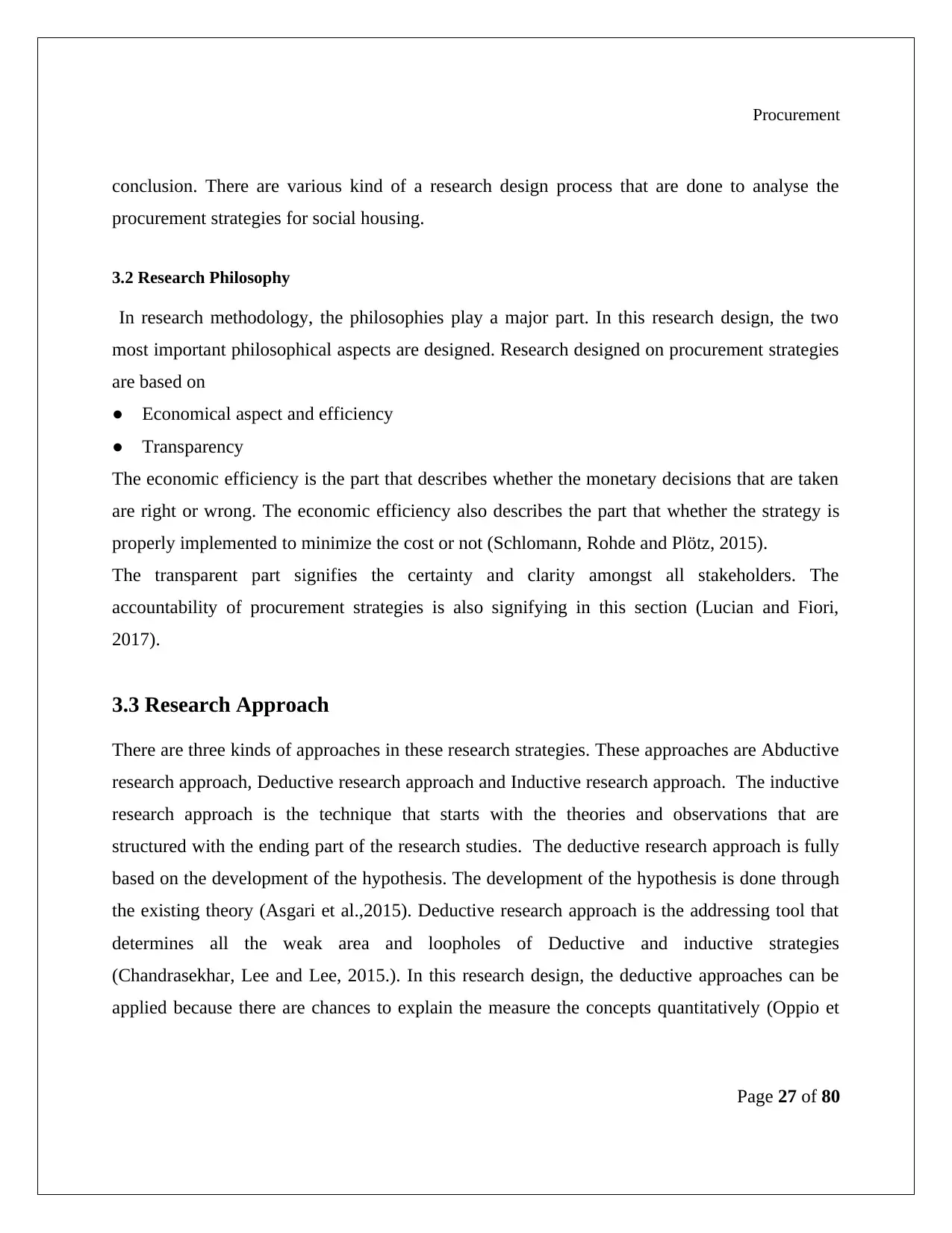
Procurement
conclusion. There are various kind of a research design process that are done to analyse the
procurement strategies for social housing.
3.2 Research Philosophy
In research methodology, the philosophies play a major part. In this research design, the two
most important philosophical aspects are designed. Research designed on procurement strategies
are based on
● Economical aspect and efficiency
● Transparency
The economic efficiency is the part that describes whether the monetary decisions that are taken
are right or wrong. The economic efficiency also describes the part that whether the strategy is
properly implemented to minimize the cost or not (Schlomann, Rohde and Plötz, 2015).
The transparent part signifies the certainty and clarity amongst all stakeholders. The
accountability of procurement strategies is also signifying in this section (Lucian and Fiori,
2017).
3.3 Research Approach
There are three kinds of approaches in these research strategies. These approaches are Abductive
research approach, Deductive research approach and Inductive research approach. The inductive
research approach is the technique that starts with the theories and observations that are
structured with the ending part of the research studies. The deductive research approach is fully
based on the development of the hypothesis. The development of the hypothesis is done through
the existing theory (Asgari et al.,2015). Deductive research approach is the addressing tool that
determines all the weak area and loopholes of Deductive and inductive strategies
(Chandrasekhar, Lee and Lee, 2015.). In this research design, the deductive approaches can be
applied because there are chances to explain the measure the concepts quantitatively (Oppio et
Page 27 of 80
conclusion. There are various kind of a research design process that are done to analyse the
procurement strategies for social housing.
3.2 Research Philosophy
In research methodology, the philosophies play a major part. In this research design, the two
most important philosophical aspects are designed. Research designed on procurement strategies
are based on
● Economical aspect and efficiency
● Transparency
The economic efficiency is the part that describes whether the monetary decisions that are taken
are right or wrong. The economic efficiency also describes the part that whether the strategy is
properly implemented to minimize the cost or not (Schlomann, Rohde and Plötz, 2015).
The transparent part signifies the certainty and clarity amongst all stakeholders. The
accountability of procurement strategies is also signifying in this section (Lucian and Fiori,
2017).
3.3 Research Approach
There are three kinds of approaches in these research strategies. These approaches are Abductive
research approach, Deductive research approach and Inductive research approach. The inductive
research approach is the technique that starts with the theories and observations that are
structured with the ending part of the research studies. The deductive research approach is fully
based on the development of the hypothesis. The development of the hypothesis is done through
the existing theory (Asgari et al.,2015). Deductive research approach is the addressing tool that
determines all the weak area and loopholes of Deductive and inductive strategies
(Chandrasekhar, Lee and Lee, 2015.). In this research design, the deductive approaches can be
applied because there are chances to explain the measure the concepts quantitatively (Oppio et
Page 27 of 80
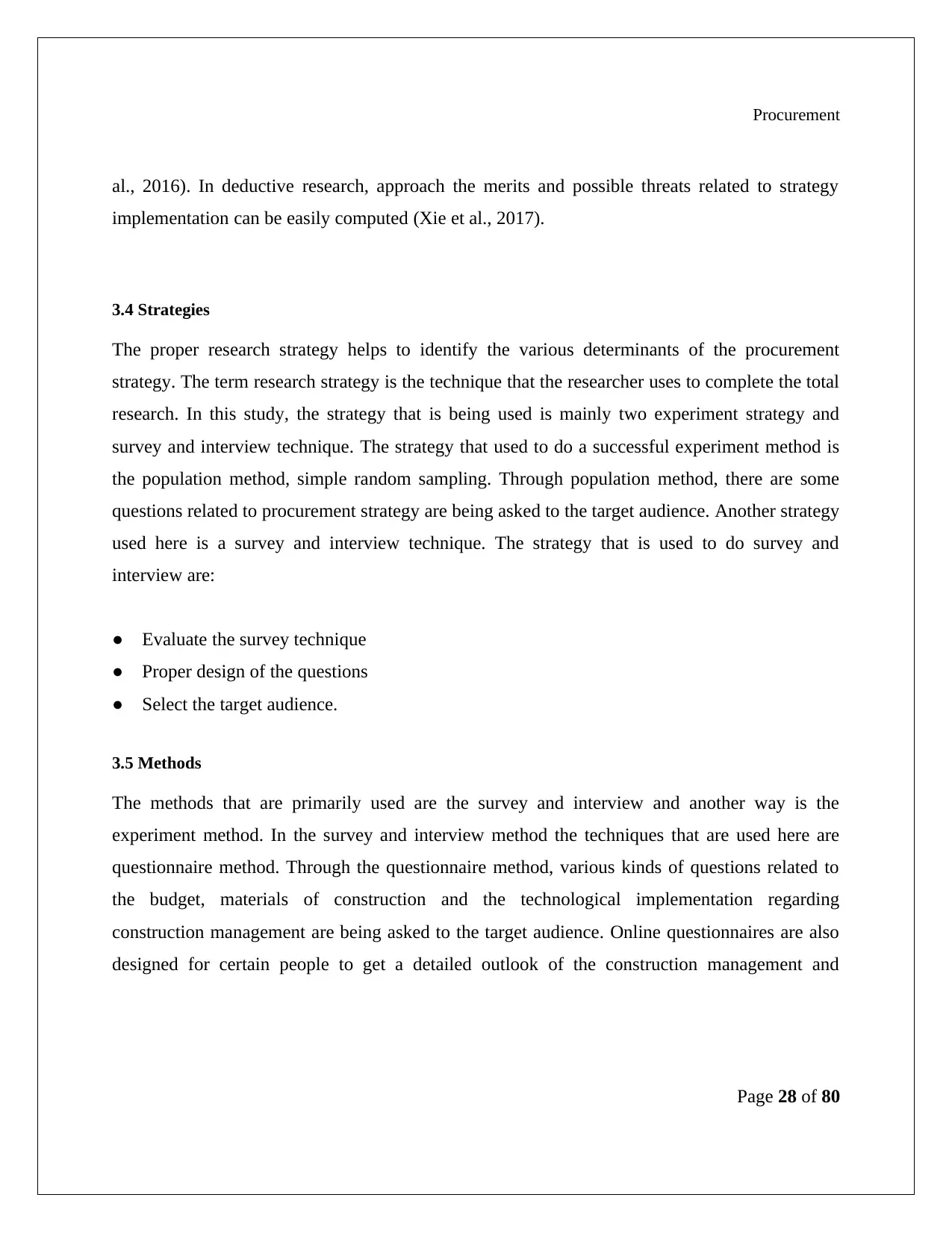
Procurement
al., 2016). In deductive research, approach the merits and possible threats related to strategy
implementation can be easily computed (Xie et al., 2017).
3.4 Strategies
The proper research strategy helps to identify the various determinants of the procurement
strategy. The term research strategy is the technique that the researcher uses to complete the total
research. In this study, the strategy that is being used is mainly two experiment strategy and
survey and interview technique. The strategy that used to do a successful experiment method is
the population method, simple random sampling. Through population method, there are some
questions related to procurement strategy are being asked to the target audience. Another strategy
used here is a survey and interview technique. The strategy that is used to do survey and
interview are:
● Evaluate the survey technique
● Proper design of the questions
● Select the target audience.
3.5 Methods
The methods that are primarily used are the survey and interview and another way is the
experiment method. In the survey and interview method the techniques that are used here are
questionnaire method. Through the questionnaire method, various kinds of questions related to
the budget, materials of construction and the technological implementation regarding
construction management are being asked to the target audience. Online questionnaires are also
designed for certain people to get a detailed outlook of the construction management and
Page 28 of 80
al., 2016). In deductive research, approach the merits and possible threats related to strategy
implementation can be easily computed (Xie et al., 2017).
3.4 Strategies
The proper research strategy helps to identify the various determinants of the procurement
strategy. The term research strategy is the technique that the researcher uses to complete the total
research. In this study, the strategy that is being used is mainly two experiment strategy and
survey and interview technique. The strategy that used to do a successful experiment method is
the population method, simple random sampling. Through population method, there are some
questions related to procurement strategy are being asked to the target audience. Another strategy
used here is a survey and interview technique. The strategy that is used to do survey and
interview are:
● Evaluate the survey technique
● Proper design of the questions
● Select the target audience.
3.5 Methods
The methods that are primarily used are the survey and interview and another way is the
experiment method. In the survey and interview method the techniques that are used here are
questionnaire method. Through the questionnaire method, various kinds of questions related to
the budget, materials of construction and the technological implementation regarding
construction management are being asked to the target audience. Online questionnaires are also
designed for certain people to get a detailed outlook of the construction management and
Page 28 of 80
Secure Best Marks with AI Grader
Need help grading? Try our AI Grader for instant feedback on your assignments.
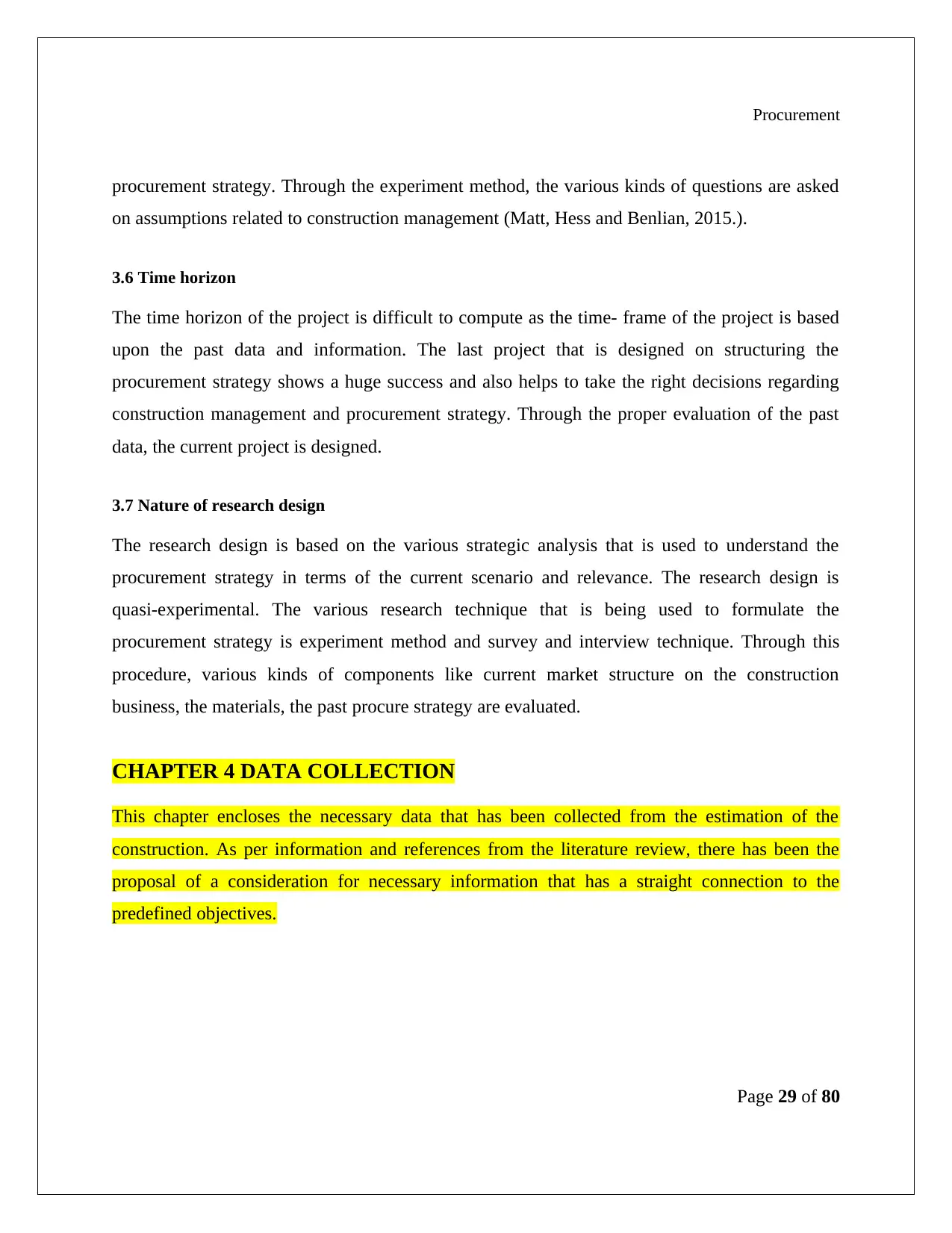
Procurement
procurement strategy. Through the experiment method, the various kinds of questions are asked
on assumptions related to construction management (Matt, Hess and Benlian, 2015.).
3.6 Time horizon
The time horizon of the project is difficult to compute as the time- frame of the project is based
upon the past data and information. The last project that is designed on structuring the
procurement strategy shows a huge success and also helps to take the right decisions regarding
construction management and procurement strategy. Through the proper evaluation of the past
data, the current project is designed.
3.7 Nature of research design
The research design is based on the various strategic analysis that is used to understand the
procurement strategy in terms of the current scenario and relevance. The research design is
quasi-experimental. The various research technique that is being used to formulate the
procurement strategy is experiment method and survey and interview technique. Through this
procedure, various kinds of components like current market structure on the construction
business, the materials, the past procure strategy are evaluated.
CHAPTER 4 DATA COLLECTION
This chapter encloses the necessary data that has been collected from the estimation of the
construction. As per information and references from the literature review, there has been the
proposal of a consideration for necessary information that has a straight connection to the
predefined objectives.
Page 29 of 80
procurement strategy. Through the experiment method, the various kinds of questions are asked
on assumptions related to construction management (Matt, Hess and Benlian, 2015.).
3.6 Time horizon
The time horizon of the project is difficult to compute as the time- frame of the project is based
upon the past data and information. The last project that is designed on structuring the
procurement strategy shows a huge success and also helps to take the right decisions regarding
construction management and procurement strategy. Through the proper evaluation of the past
data, the current project is designed.
3.7 Nature of research design
The research design is based on the various strategic analysis that is used to understand the
procurement strategy in terms of the current scenario and relevance. The research design is
quasi-experimental. The various research technique that is being used to formulate the
procurement strategy is experiment method and survey and interview technique. Through this
procedure, various kinds of components like current market structure on the construction
business, the materials, the past procure strategy are evaluated.
CHAPTER 4 DATA COLLECTION
This chapter encloses the necessary data that has been collected from the estimation of the
construction. As per information and references from the literature review, there has been the
proposal of a consideration for necessary information that has a straight connection to the
predefined objectives.
Page 29 of 80
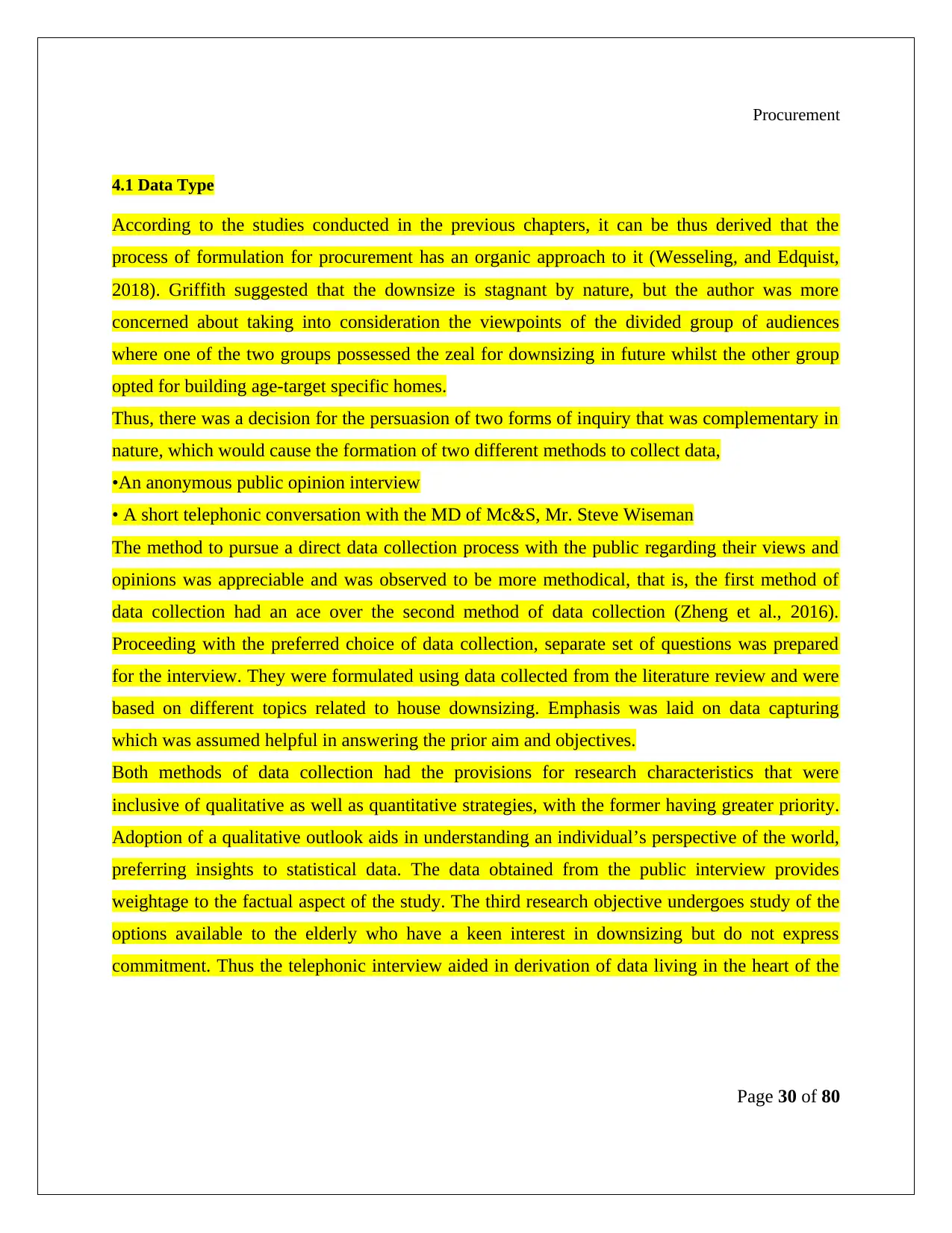
Procurement
4.1 Data Type
According to the studies conducted in the previous chapters, it can be thus derived that the
process of formulation for procurement has an organic approach to it (Wesseling, and Edquist,
2018). Griffith suggested that the downsize is stagnant by nature, but the author was more
concerned about taking into consideration the viewpoints of the divided group of audiences
where one of the two groups possessed the zeal for downsizing in future whilst the other group
opted for building age-target specific homes.
Thus, there was a decision for the persuasion of two forms of inquiry that was complementary in
nature, which would cause the formation of two different methods to collect data,
•An anonymous public opinion interview
• A short telephonic conversation with the MD of Mc&S, Mr. Steve Wiseman
The method to pursue a direct data collection process with the public regarding their views and
opinions was appreciable and was observed to be more methodical, that is, the first method of
data collection had an ace over the second method of data collection (Zheng et al., 2016).
Proceeding with the preferred choice of data collection, separate set of questions was prepared
for the interview. They were formulated using data collected from the literature review and were
based on different topics related to house downsizing. Emphasis was laid on data capturing
which was assumed helpful in answering the prior aim and objectives.
Both methods of data collection had the provisions for research characteristics that were
inclusive of qualitative as well as quantitative strategies, with the former having greater priority.
Adoption of a qualitative outlook aids in understanding an individual’s perspective of the world,
preferring insights to statistical data. The data obtained from the public interview provides
weightage to the factual aspect of the study. The third research objective undergoes study of the
options available to the elderly who have a keen interest in downsizing but do not express
commitment. Thus the telephonic interview aided in derivation of data living in the heart of the
Page 30 of 80
4.1 Data Type
According to the studies conducted in the previous chapters, it can be thus derived that the
process of formulation for procurement has an organic approach to it (Wesseling, and Edquist,
2018). Griffith suggested that the downsize is stagnant by nature, but the author was more
concerned about taking into consideration the viewpoints of the divided group of audiences
where one of the two groups possessed the zeal for downsizing in future whilst the other group
opted for building age-target specific homes.
Thus, there was a decision for the persuasion of two forms of inquiry that was complementary in
nature, which would cause the formation of two different methods to collect data,
•An anonymous public opinion interview
• A short telephonic conversation with the MD of Mc&S, Mr. Steve Wiseman
The method to pursue a direct data collection process with the public regarding their views and
opinions was appreciable and was observed to be more methodical, that is, the first method of
data collection had an ace over the second method of data collection (Zheng et al., 2016).
Proceeding with the preferred choice of data collection, separate set of questions was prepared
for the interview. They were formulated using data collected from the literature review and were
based on different topics related to house downsizing. Emphasis was laid on data capturing
which was assumed helpful in answering the prior aim and objectives.
Both methods of data collection had the provisions for research characteristics that were
inclusive of qualitative as well as quantitative strategies, with the former having greater priority.
Adoption of a qualitative outlook aids in understanding an individual’s perspective of the world,
preferring insights to statistical data. The data obtained from the public interview provides
weightage to the factual aspect of the study. The third research objective undergoes study of the
options available to the elderly who have a keen interest in downsizing but do not express
commitment. Thus the telephonic interview aided in derivation of data living in the heart of the
Page 30 of 80
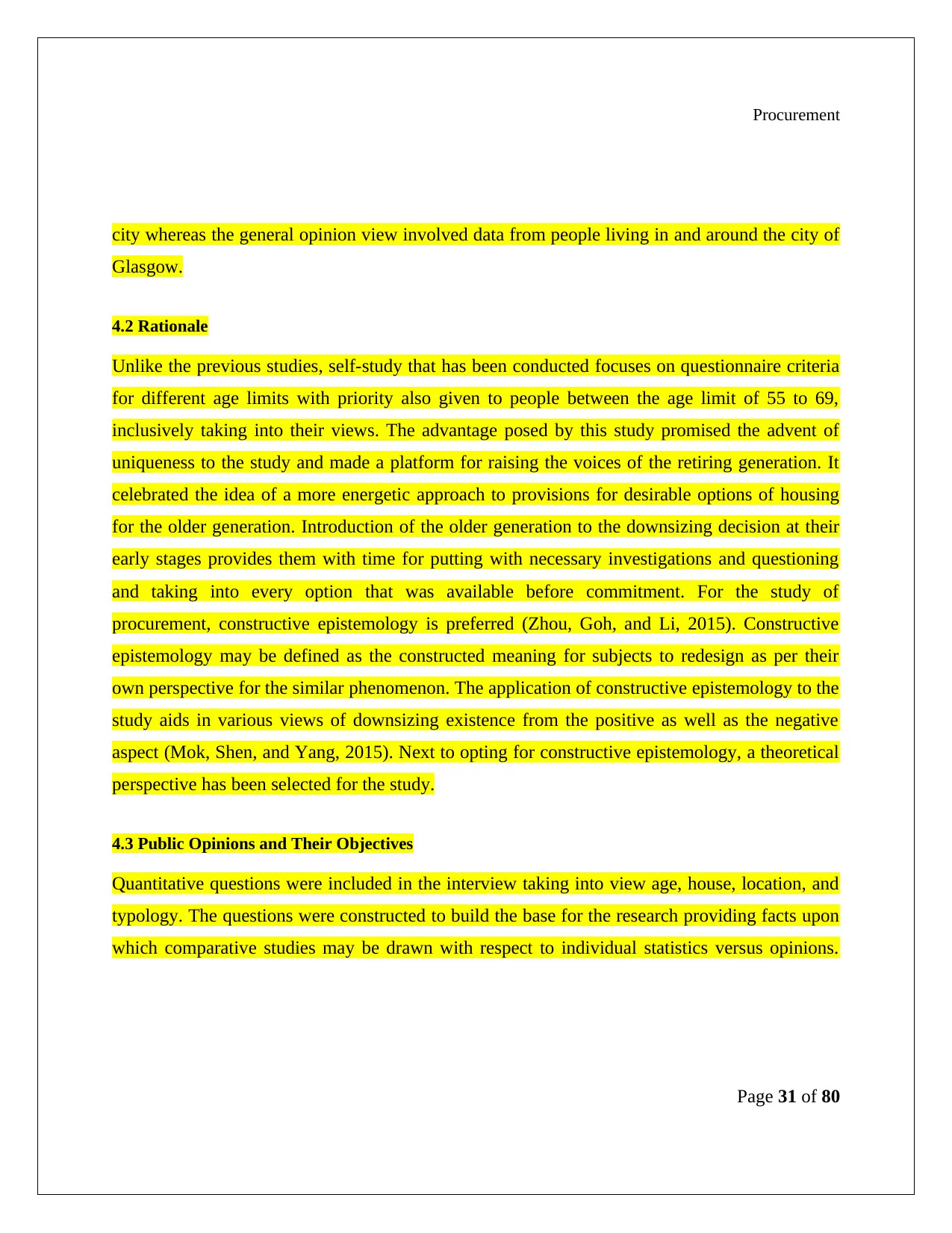
Procurement
city whereas the general opinion view involved data from people living in and around the city of
Glasgow.
4.2 Rationale
Unlike the previous studies, self-study that has been conducted focuses on questionnaire criteria
for different age limits with priority also given to people between the age limit of 55 to 69,
inclusively taking into their views. The advantage posed by this study promised the advent of
uniqueness to the study and made a platform for raising the voices of the retiring generation. It
celebrated the idea of a more energetic approach to provisions for desirable options of housing
for the older generation. Introduction of the older generation to the downsizing decision at their
early stages provides them with time for putting with necessary investigations and questioning
and taking into every option that was available before commitment. For the study of
procurement, constructive epistemology is preferred (Zhou, Goh, and Li, 2015). Constructive
epistemology may be defined as the constructed meaning for subjects to redesign as per their
own perspective for the similar phenomenon. The application of constructive epistemology to the
study aids in various views of downsizing existence from the positive as well as the negative
aspect (Mok, Shen, and Yang, 2015). Next to opting for constructive epistemology, a theoretical
perspective has been selected for the study.
4.3 Public Opinions and Their Objectives
Quantitative questions were included in the interview taking into view age, house, location, and
typology. The questions were constructed to build the base for the research providing facts upon
which comparative studies may be drawn with respect to individual statistics versus opinions.
Page 31 of 80
city whereas the general opinion view involved data from people living in and around the city of
Glasgow.
4.2 Rationale
Unlike the previous studies, self-study that has been conducted focuses on questionnaire criteria
for different age limits with priority also given to people between the age limit of 55 to 69,
inclusively taking into their views. The advantage posed by this study promised the advent of
uniqueness to the study and made a platform for raising the voices of the retiring generation. It
celebrated the idea of a more energetic approach to provisions for desirable options of housing
for the older generation. Introduction of the older generation to the downsizing decision at their
early stages provides them with time for putting with necessary investigations and questioning
and taking into every option that was available before commitment. For the study of
procurement, constructive epistemology is preferred (Zhou, Goh, and Li, 2015). Constructive
epistemology may be defined as the constructed meaning for subjects to redesign as per their
own perspective for the similar phenomenon. The application of constructive epistemology to the
study aids in various views of downsizing existence from the positive as well as the negative
aspect (Mok, Shen, and Yang, 2015). Next to opting for constructive epistemology, a theoretical
perspective has been selected for the study.
4.3 Public Opinions and Their Objectives
Quantitative questions were included in the interview taking into view age, house, location, and
typology. The questions were constructed to build the base for the research providing facts upon
which comparative studies may be drawn with respect to individual statistics versus opinions.
Page 31 of 80
Paraphrase This Document
Need a fresh take? Get an instant paraphrase of this document with our AI Paraphraser
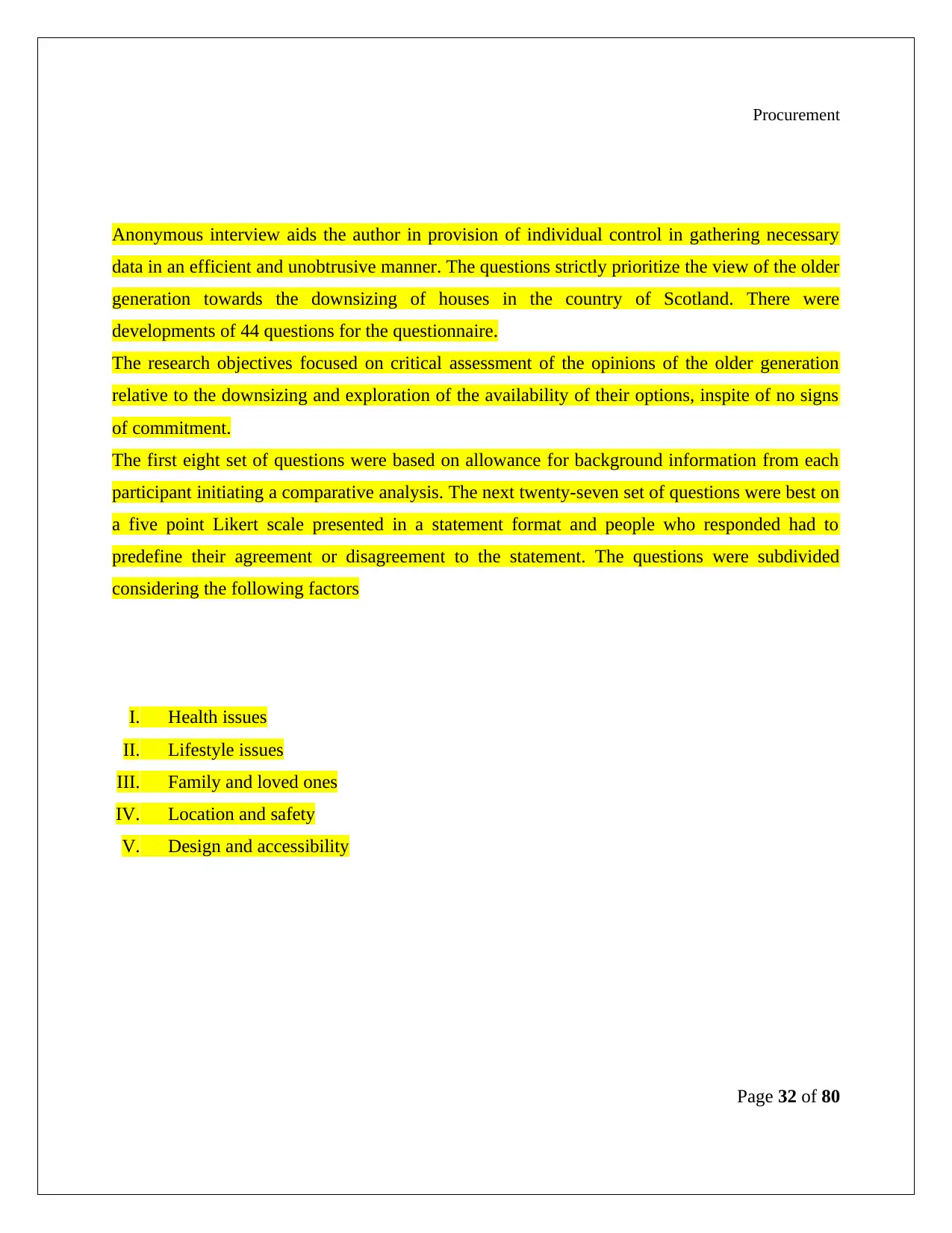
Procurement
Anonymous interview aids the author in provision of individual control in gathering necessary
data in an efficient and unobtrusive manner. The questions strictly prioritize the view of the older
generation towards the downsizing of houses in the country of Scotland. There were
developments of 44 questions for the questionnaire.
The research objectives focused on critical assessment of the opinions of the older generation
relative to the downsizing and exploration of the availability of their options, inspite of no signs
of commitment.
The first eight set of questions were based on allowance for background information from each
participant initiating a comparative analysis. The next twenty-seven set of questions were best on
a five point Likert scale presented in a statement format and people who responded had to
predefine their agreement or disagreement to the statement. The questions were subdivided
considering the following factors
I. Health issues
II. Lifestyle issues
III. Family and loved ones
IV. Location and safety
V. Design and accessibility
Page 32 of 80
Anonymous interview aids the author in provision of individual control in gathering necessary
data in an efficient and unobtrusive manner. The questions strictly prioritize the view of the older
generation towards the downsizing of houses in the country of Scotland. There were
developments of 44 questions for the questionnaire.
The research objectives focused on critical assessment of the opinions of the older generation
relative to the downsizing and exploration of the availability of their options, inspite of no signs
of commitment.
The first eight set of questions were based on allowance for background information from each
participant initiating a comparative analysis. The next twenty-seven set of questions were best on
a five point Likert scale presented in a statement format and people who responded had to
predefine their agreement or disagreement to the statement. The questions were subdivided
considering the following factors
I. Health issues
II. Lifestyle issues
III. Family and loved ones
IV. Location and safety
V. Design and accessibility
Page 32 of 80
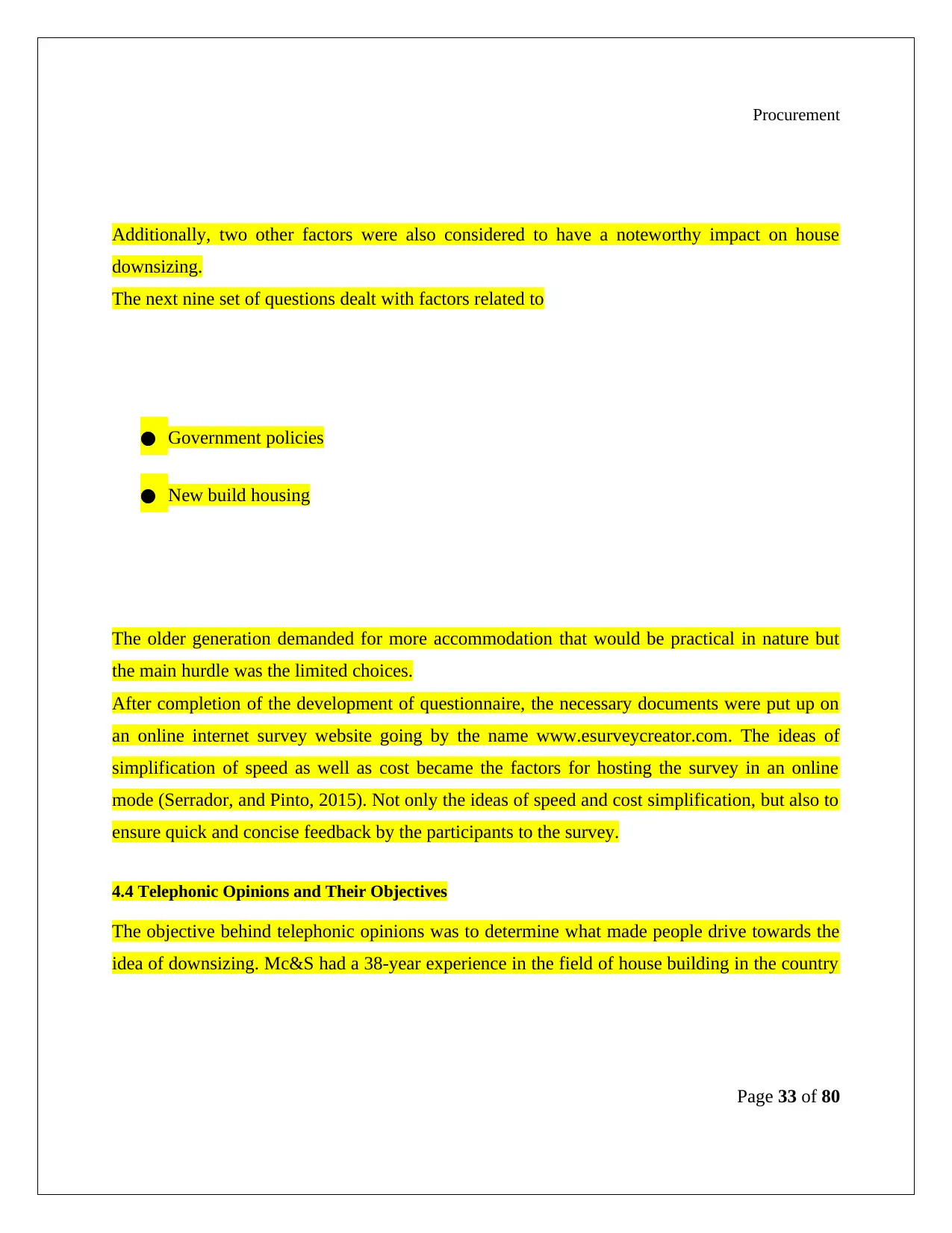
Procurement
Additionally, two other factors were also considered to have a noteworthy impact on house
downsizing.
The next nine set of questions dealt with factors related to
● Government policies
● New build housing
The older generation demanded for more accommodation that would be practical in nature but
the main hurdle was the limited choices.
After completion of the development of questionnaire, the necessary documents were put up on
an online internet survey website going by the name www.esurveycreator.com. The ideas of
simplification of speed as well as cost became the factors for hosting the survey in an online
mode (Serrador, and Pinto, 2015). Not only the ideas of speed and cost simplification, but also to
ensure quick and concise feedback by the participants to the survey.
4.4 Telephonic Opinions and Their Objectives
The objective behind telephonic opinions was to determine what made people drive towards the
idea of downsizing. Mc&S had a 38-year experience in the field of house building in the country
Page 33 of 80
Additionally, two other factors were also considered to have a noteworthy impact on house
downsizing.
The next nine set of questions dealt with factors related to
● Government policies
● New build housing
The older generation demanded for more accommodation that would be practical in nature but
the main hurdle was the limited choices.
After completion of the development of questionnaire, the necessary documents were put up on
an online internet survey website going by the name www.esurveycreator.com. The ideas of
simplification of speed as well as cost became the factors for hosting the survey in an online
mode (Serrador, and Pinto, 2015). Not only the ideas of speed and cost simplification, but also to
ensure quick and concise feedback by the participants to the survey.
4.4 Telephonic Opinions and Their Objectives
The objective behind telephonic opinions was to determine what made people drive towards the
idea of downsizing. Mc&S had a 38-year experience in the field of house building in the country
Page 33 of 80

Procurement
of Scotland and has achieved many awards for their services. The company also has a prominent
section of itself towards downsizing. The managing director of the company, Mr. Steve Wiseman
took into consideration the importance of the telephonic interview and also take into view the
change in the market as observed by the older generation.
In order to achieve more profits, the author prepared a brief outline of the topics and their related
questions and sent them to Mr. Wiseman forty-eight hours before the commencement of the
interview. Emphasis was laid on
● Company’s perspective on the important parts of downsizing
● Perception of the client’s views towards downsizing
● Future market visionaries
The final objective for the telephonic interview had an ace in producing opinions regarding the
upcoming housing trends for the future.
After the interview completed, a transcript had been written and the information was used for the
results section. The ultimate aim was to select the main points in the interview and put them up
Page 34 of 80
of Scotland and has achieved many awards for their services. The company also has a prominent
section of itself towards downsizing. The managing director of the company, Mr. Steve Wiseman
took into consideration the importance of the telephonic interview and also take into view the
change in the market as observed by the older generation.
In order to achieve more profits, the author prepared a brief outline of the topics and their related
questions and sent them to Mr. Wiseman forty-eight hours before the commencement of the
interview. Emphasis was laid on
● Company’s perspective on the important parts of downsizing
● Perception of the client’s views towards downsizing
● Future market visionaries
The final objective for the telephonic interview had an ace in producing opinions regarding the
upcoming housing trends for the future.
After the interview completed, a transcript had been written and the information was used for the
results section. The ultimate aim was to select the main points in the interview and put them up
Page 34 of 80
Secure Best Marks with AI Grader
Need help grading? Try our AI Grader for instant feedback on your assignments.
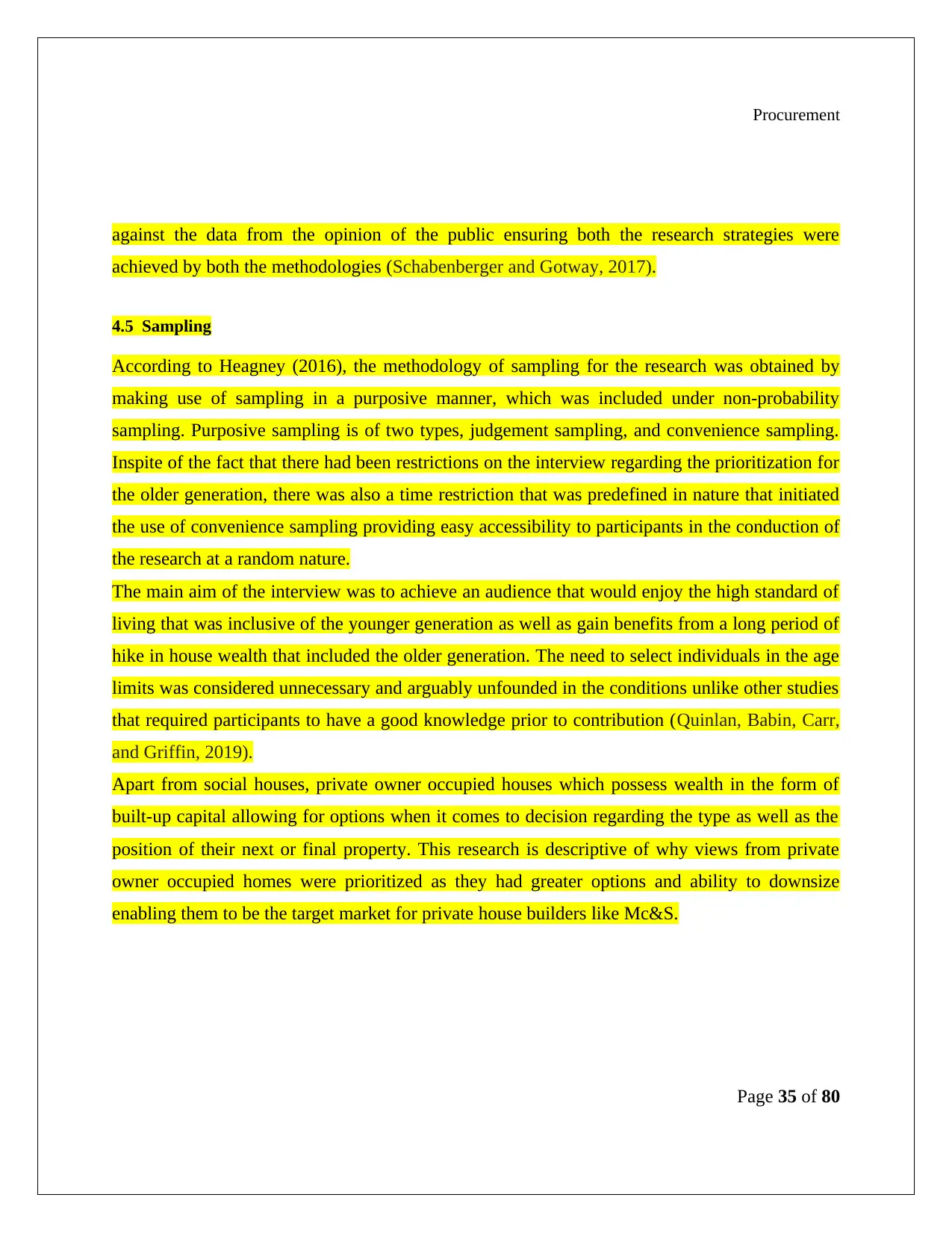
Procurement
against the data from the opinion of the public ensuring both the research strategies were
achieved by both the methodologies (Schabenberger and Gotway, 2017).
4.5 Sampling
According to Heagney (2016), the methodology of sampling for the research was obtained by
making use of sampling in a purposive manner, which was included under non-probability
sampling. Purposive sampling is of two types, judgement sampling, and convenience sampling.
Inspite of the fact that there had been restrictions on the interview regarding the prioritization for
the older generation, there was also a time restriction that was predefined in nature that initiated
the use of convenience sampling providing easy accessibility to participants in the conduction of
the research at a random nature.
The main aim of the interview was to achieve an audience that would enjoy the high standard of
living that was inclusive of the younger generation as well as gain benefits from a long period of
hike in house wealth that included the older generation. The need to select individuals in the age
limits was considered unnecessary and arguably unfounded in the conditions unlike other studies
that required participants to have a good knowledge prior to contribution (Quinlan, Babin, Carr,
and Griffin, 2019).
Apart from social houses, private owner occupied houses which possess wealth in the form of
built-up capital allowing for options when it comes to decision regarding the type as well as the
position of their next or final property. This research is descriptive of why views from private
owner occupied homes were prioritized as they had greater options and ability to downsize
enabling them to be the target market for private house builders like Mc&S.
Page 35 of 80
against the data from the opinion of the public ensuring both the research strategies were
achieved by both the methodologies (Schabenberger and Gotway, 2017).
4.5 Sampling
According to Heagney (2016), the methodology of sampling for the research was obtained by
making use of sampling in a purposive manner, which was included under non-probability
sampling. Purposive sampling is of two types, judgement sampling, and convenience sampling.
Inspite of the fact that there had been restrictions on the interview regarding the prioritization for
the older generation, there was also a time restriction that was predefined in nature that initiated
the use of convenience sampling providing easy accessibility to participants in the conduction of
the research at a random nature.
The main aim of the interview was to achieve an audience that would enjoy the high standard of
living that was inclusive of the younger generation as well as gain benefits from a long period of
hike in house wealth that included the older generation. The need to select individuals in the age
limits was considered unnecessary and arguably unfounded in the conditions unlike other studies
that required participants to have a good knowledge prior to contribution (Quinlan, Babin, Carr,
and Griffin, 2019).
Apart from social houses, private owner occupied houses which possess wealth in the form of
built-up capital allowing for options when it comes to decision regarding the type as well as the
position of their next or final property. This research is descriptive of why views from private
owner occupied homes were prioritized as they had greater options and ability to downsize
enabling them to be the target market for private house builders like Mc&S.
Page 35 of 80
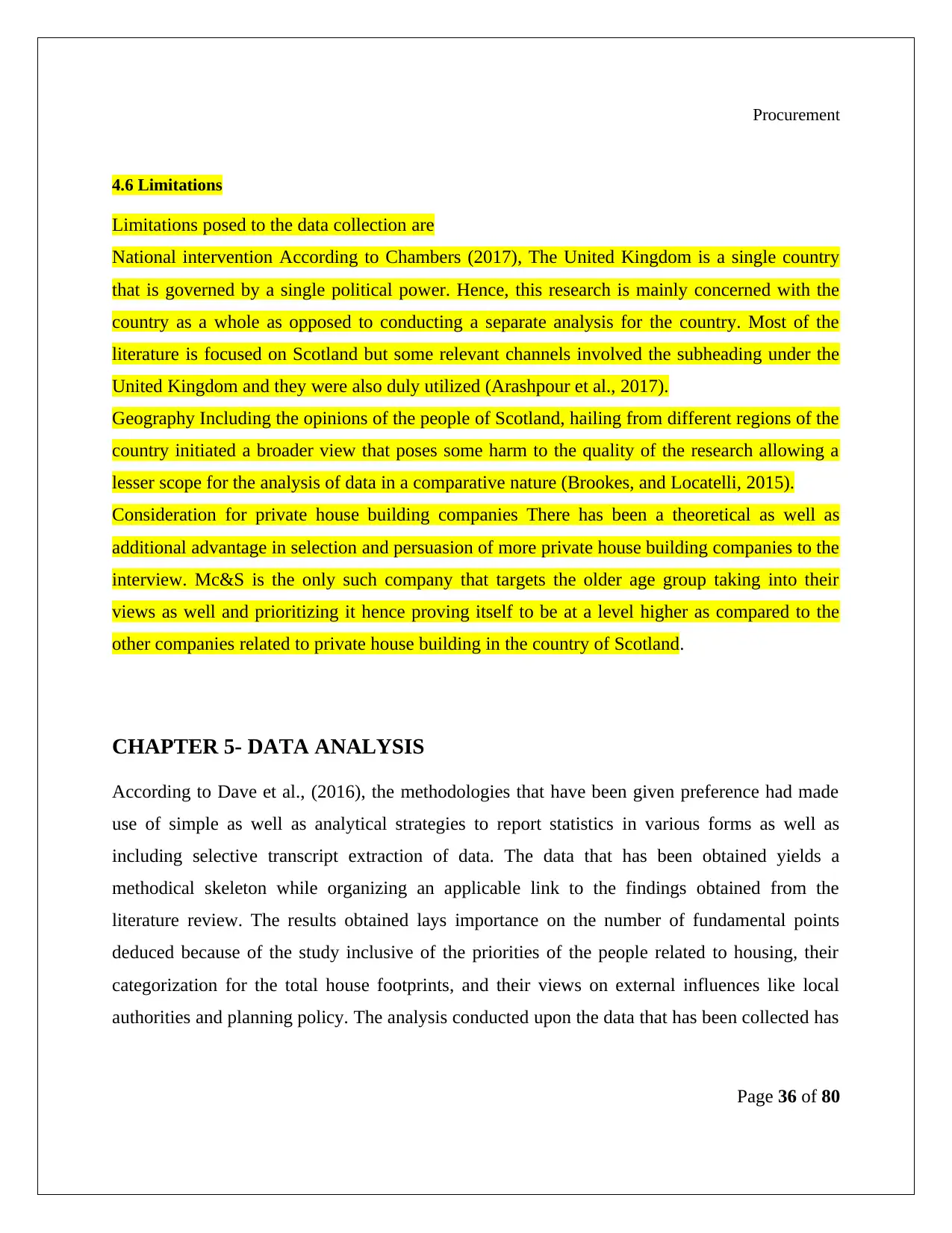
Procurement
4.6 Limitations
Limitations posed to the data collection are
National intervention According to Chambers (2017), The United Kingdom is a single country
that is governed by a single political power. Hence, this research is mainly concerned with the
country as a whole as opposed to conducting a separate analysis for the country. Most of the
literature is focused on Scotland but some relevant channels involved the subheading under the
United Kingdom and they were also duly utilized (Arashpour et al., 2017).
Geography Including the opinions of the people of Scotland, hailing from different regions of the
country initiated a broader view that poses some harm to the quality of the research allowing a
lesser scope for the analysis of data in a comparative nature (Brookes, and Locatelli, 2015).
Consideration for private house building companies There has been a theoretical as well as
additional advantage in selection and persuasion of more private house building companies to the
interview. Mc&S is the only such company that targets the older age group taking into their
views as well and prioritizing it hence proving itself to be at a level higher as compared to the
other companies related to private house building in the country of Scotland.
CHAPTER 5- DATA ANALYSIS
According to Dave et al., (2016), the methodologies that have been given preference had made
use of simple as well as analytical strategies to report statistics in various forms as well as
including selective transcript extraction of data. The data that has been obtained yields a
methodical skeleton while organizing an applicable link to the findings obtained from the
literature review. The results obtained lays importance on the number of fundamental points
deduced because of the study inclusive of the priorities of the people related to housing, their
categorization for the total house footprints, and their views on external influences like local
authorities and planning policy. The analysis conducted upon the data that has been collected has
Page 36 of 80
4.6 Limitations
Limitations posed to the data collection are
National intervention According to Chambers (2017), The United Kingdom is a single country
that is governed by a single political power. Hence, this research is mainly concerned with the
country as a whole as opposed to conducting a separate analysis for the country. Most of the
literature is focused on Scotland but some relevant channels involved the subheading under the
United Kingdom and they were also duly utilized (Arashpour et al., 2017).
Geography Including the opinions of the people of Scotland, hailing from different regions of the
country initiated a broader view that poses some harm to the quality of the research allowing a
lesser scope for the analysis of data in a comparative nature (Brookes, and Locatelli, 2015).
Consideration for private house building companies There has been a theoretical as well as
additional advantage in selection and persuasion of more private house building companies to the
interview. Mc&S is the only such company that targets the older age group taking into their
views as well and prioritizing it hence proving itself to be at a level higher as compared to the
other companies related to private house building in the country of Scotland.
CHAPTER 5- DATA ANALYSIS
According to Dave et al., (2016), the methodologies that have been given preference had made
use of simple as well as analytical strategies to report statistics in various forms as well as
including selective transcript extraction of data. The data that has been obtained yields a
methodical skeleton while organizing an applicable link to the findings obtained from the
literature review. The results obtained lays importance on the number of fundamental points
deduced because of the study inclusive of the priorities of the people related to housing, their
categorization for the total house footprints, and their views on external influences like local
authorities and planning policy. The analysis conducted upon the data that has been collected has
Page 36 of 80
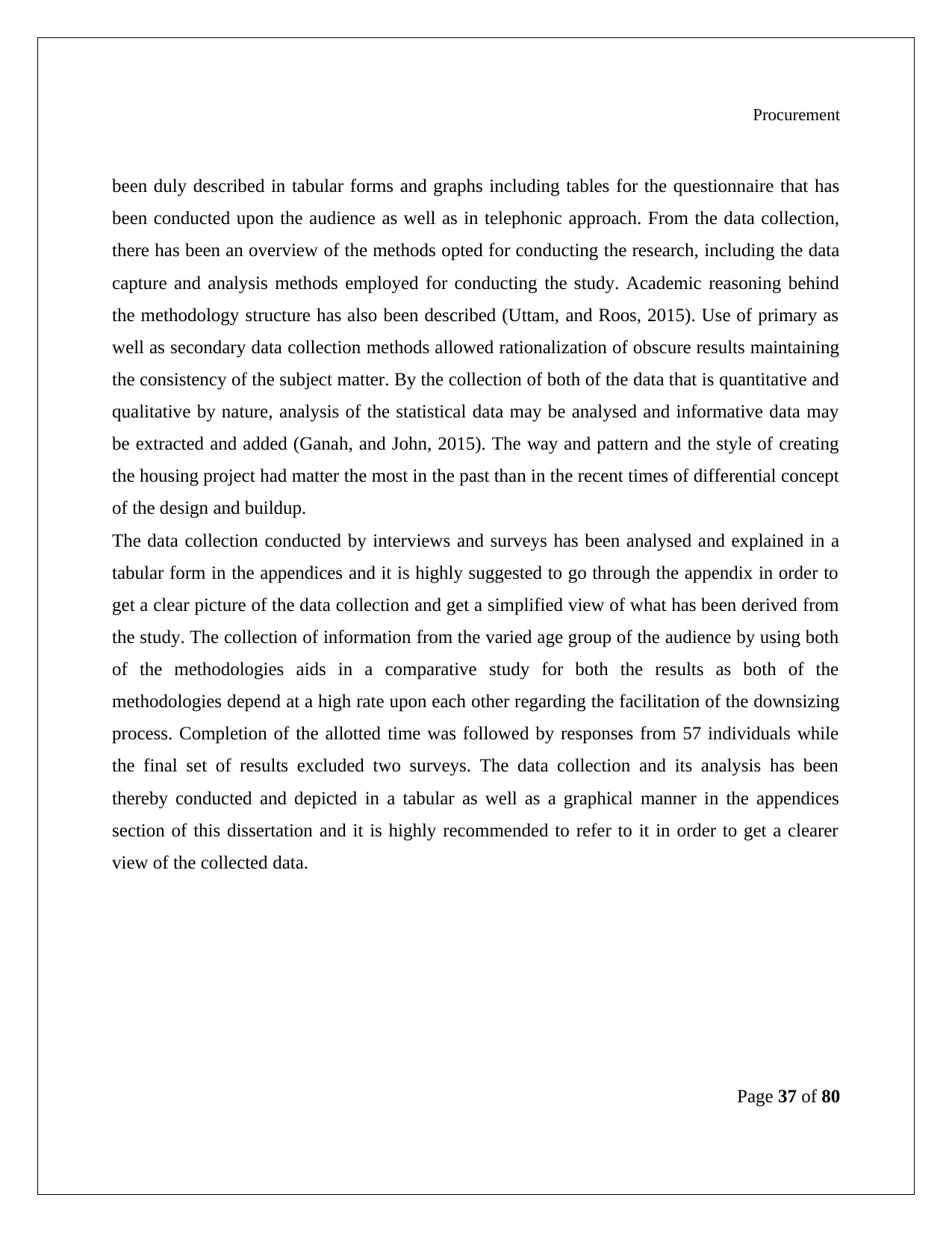
Procurement
been duly described in tabular forms and graphs including tables for the questionnaire that has
been conducted upon the audience as well as in telephonic approach. From the data collection,
there has been an overview of the methods opted for conducting the research, including the data
capture and analysis methods employed for conducting the study. Academic reasoning behind
the methodology structure has also been described (Uttam, and Roos, 2015). Use of primary as
well as secondary data collection methods allowed rationalization of obscure results maintaining
the consistency of the subject matter. By the collection of both of the data that is quantitative and
qualitative by nature, analysis of the statistical data may be analysed and informative data may
be extracted and added (Ganah, and John, 2015). The way and pattern and the style of creating
the housing project had matter the most in the past than in the recent times of differential concept
of the design and buildup.
The data collection conducted by interviews and surveys has been analysed and explained in a
tabular form in the appendices and it is highly suggested to go through the appendix in order to
get a clear picture of the data collection and get a simplified view of what has been derived from
the study. The collection of information from the varied age group of the audience by using both
of the methodologies aids in a comparative study for both the results as both of the
methodologies depend at a high rate upon each other regarding the facilitation of the downsizing
process. Completion of the allotted time was followed by responses from 57 individuals while
the final set of results excluded two surveys. The data collection and its analysis has been
thereby conducted and depicted in a tabular as well as a graphical manner in the appendices
section of this dissertation and it is highly recommended to refer to it in order to get a clearer
view of the collected data.
Page 37 of 80
been duly described in tabular forms and graphs including tables for the questionnaire that has
been conducted upon the audience as well as in telephonic approach. From the data collection,
there has been an overview of the methods opted for conducting the research, including the data
capture and analysis methods employed for conducting the study. Academic reasoning behind
the methodology structure has also been described (Uttam, and Roos, 2015). Use of primary as
well as secondary data collection methods allowed rationalization of obscure results maintaining
the consistency of the subject matter. By the collection of both of the data that is quantitative and
qualitative by nature, analysis of the statistical data may be analysed and informative data may
be extracted and added (Ganah, and John, 2015). The way and pattern and the style of creating
the housing project had matter the most in the past than in the recent times of differential concept
of the design and buildup.
The data collection conducted by interviews and surveys has been analysed and explained in a
tabular form in the appendices and it is highly suggested to go through the appendix in order to
get a clear picture of the data collection and get a simplified view of what has been derived from
the study. The collection of information from the varied age group of the audience by using both
of the methodologies aids in a comparative study for both the results as both of the
methodologies depend at a high rate upon each other regarding the facilitation of the downsizing
process. Completion of the allotted time was followed by responses from 57 individuals while
the final set of results excluded two surveys. The data collection and its analysis has been
thereby conducted and depicted in a tabular as well as a graphical manner in the appendices
section of this dissertation and it is highly recommended to refer to it in order to get a clearer
view of the collected data.
Page 37 of 80
Paraphrase This Document
Need a fresh take? Get an instant paraphrase of this document with our AI Paraphraser
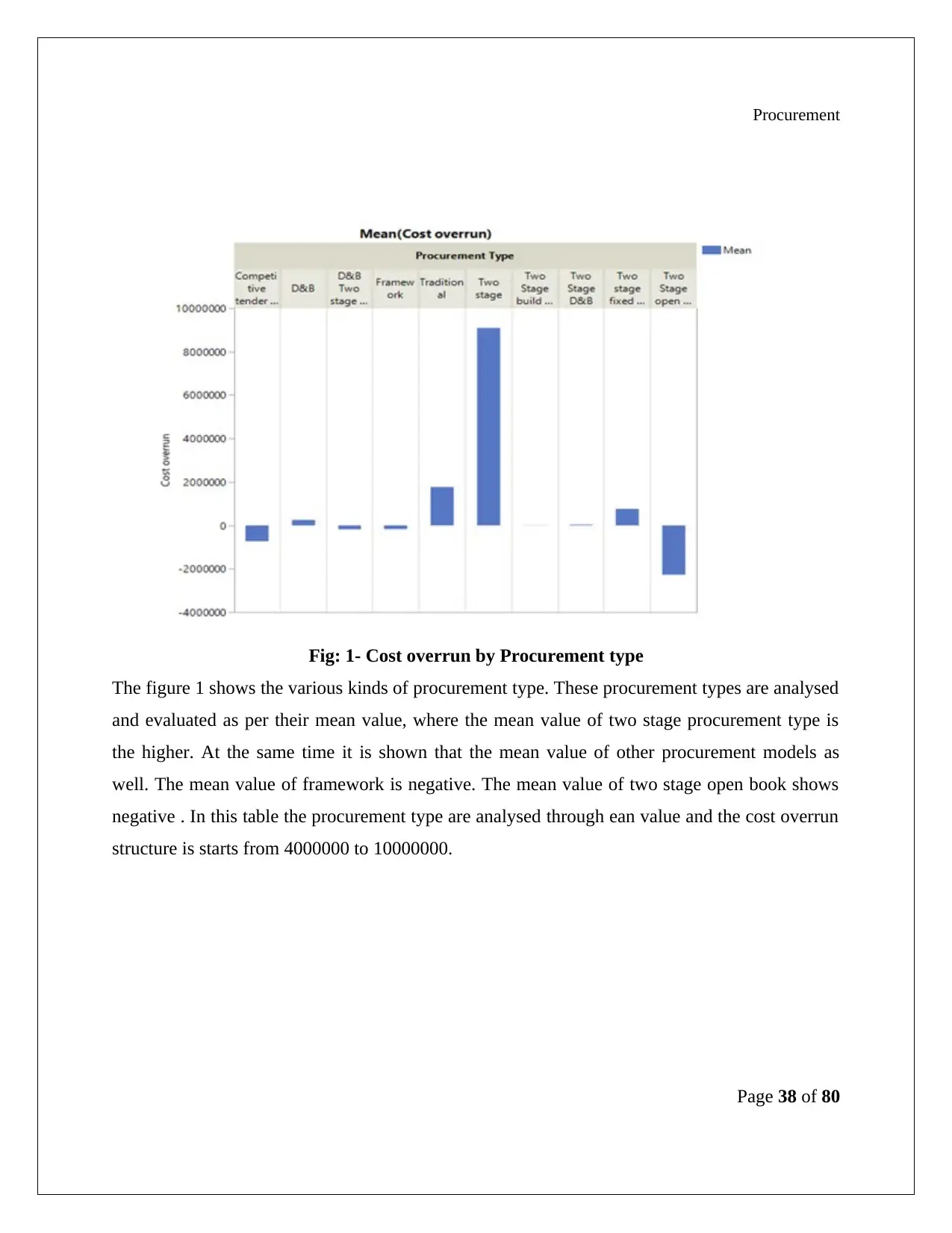
Procurement
Fig: 1- Cost overrun by Procurement type
The figure 1 shows the various kinds of procurement type. These procurement types are analysed
and evaluated as per their mean value, where the mean value of two stage procurement type is
the higher. At the same time it is shown that the mean value of other procurement models as
well. The mean value of framework is negative. The mean value of two stage open book shows
negative . In this table the procurement type are analysed through ean value and the cost overrun
structure is starts from 4000000 to 10000000.
Page 38 of 80
Fig: 1- Cost overrun by Procurement type
The figure 1 shows the various kinds of procurement type. These procurement types are analysed
and evaluated as per their mean value, where the mean value of two stage procurement type is
the higher. At the same time it is shown that the mean value of other procurement models as
well. The mean value of framework is negative. The mean value of two stage open book shows
negative . In this table the procurement type are analysed through ean value and the cost overrun
structure is starts from 4000000 to 10000000.
Page 38 of 80
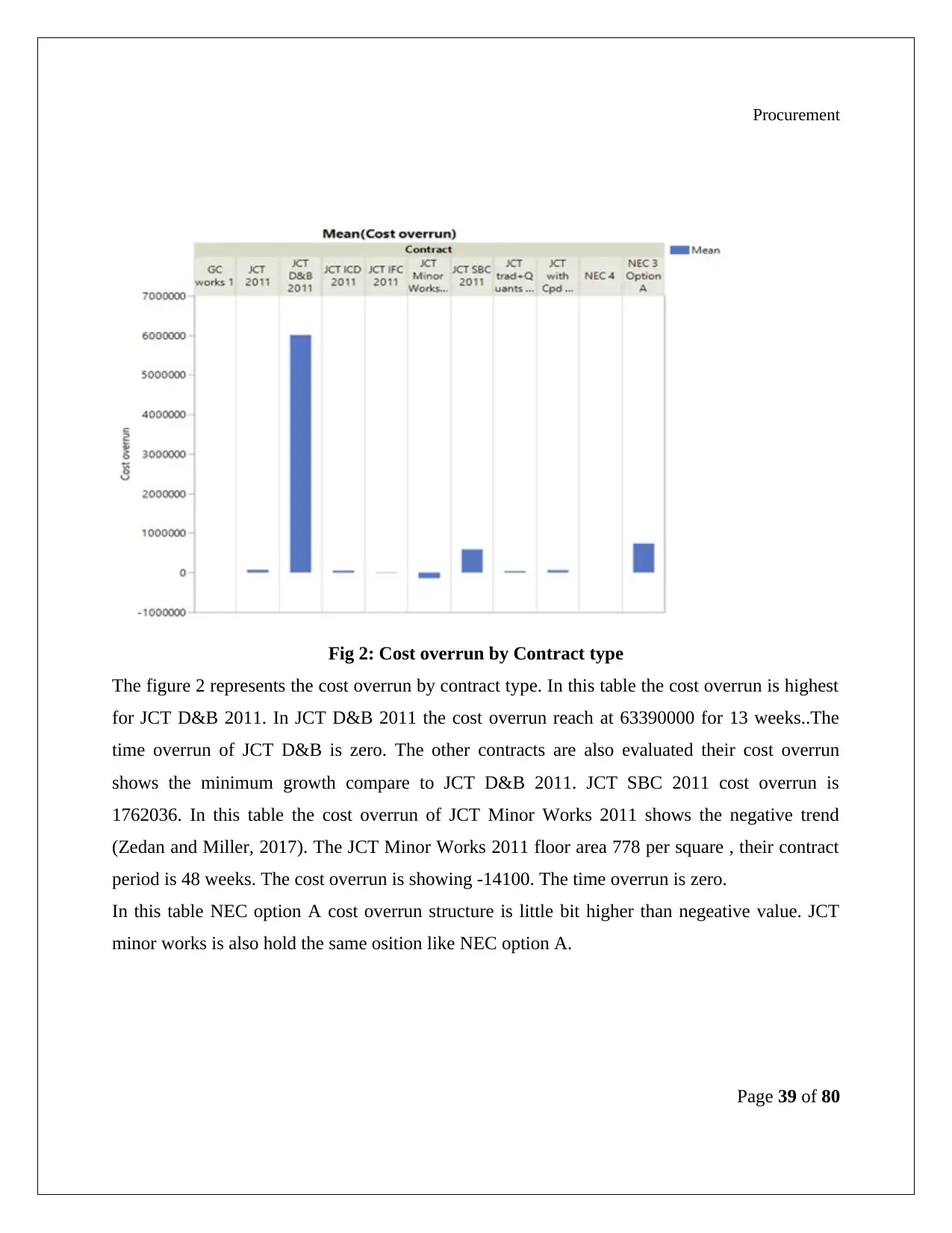
Procurement
Fig 2: Cost overrun by Contract type
The figure 2 represents the cost overrun by contract type. In this table the cost overrun is highest
for JCT D&B 2011. In JCT D&B 2011 the cost overrun reach at 63390000 for 13 weeks..The
time overrun of JCT D&B is zero. The other contracts are also evaluated their cost overrun
shows the minimum growth compare to JCT D&B 2011. JCT SBC 2011 cost overrun is
1762036. In this table the cost overrun of JCT Minor Works 2011 shows the negative trend
(Zedan and Miller, 2017). The JCT Minor Works 2011 floor area 778 per square , their contract
period is 48 weeks. The cost overrun is showing -14100. The time overrun is zero.
In this table NEC option A cost overrun structure is little bit higher than negeative value. JCT
minor works is also hold the same osition like NEC option A.
Page 39 of 80
Fig 2: Cost overrun by Contract type
The figure 2 represents the cost overrun by contract type. In this table the cost overrun is highest
for JCT D&B 2011. In JCT D&B 2011 the cost overrun reach at 63390000 for 13 weeks..The
time overrun of JCT D&B is zero. The other contracts are also evaluated their cost overrun
shows the minimum growth compare to JCT D&B 2011. JCT SBC 2011 cost overrun is
1762036. In this table the cost overrun of JCT Minor Works 2011 shows the negative trend
(Zedan and Miller, 2017). The JCT Minor Works 2011 floor area 778 per square , their contract
period is 48 weeks. The cost overrun is showing -14100. The time overrun is zero.
In this table NEC option A cost overrun structure is little bit higher than negeative value. JCT
minor works is also hold the same osition like NEC option A.
Page 39 of 80

Procurement
Fig 3: Cost overrun by floor area
The table 3 shows the cost overrun by floor area. According to the table the floor area that
shows the highest cost overrun is 2795 to 3995 meter per square. The contractors name are JCT
SBC 2011, JCT D&B 2011, JCT ICD 2011, JCT trad+quants 2011, NEC3 option A, JCT IFC
2011, NEC 3 OPTION A, , JCT 2011, NEC 3 Option A, JCT SBC 2011, JCT Minor Works
2011, JCT Trad+ Quants 2011. JCT D&B 2011, JCT with Cpd 2011,JCT 2011, JCT D& B 2011.
Among all theses company the highest floor area 5036 meter per square. The name of the
contractor is NEC 3 Option A. The contract period 91 weeks, The contractor has taken 107
weeks. The cost overrun is 1515236. The speed of NEC3 Option A 55.34065934.
Page 40 of 80
Fig 3: Cost overrun by floor area
The table 3 shows the cost overrun by floor area. According to the table the floor area that
shows the highest cost overrun is 2795 to 3995 meter per square. The contractors name are JCT
SBC 2011, JCT D&B 2011, JCT ICD 2011, JCT trad+quants 2011, NEC3 option A, JCT IFC
2011, NEC 3 OPTION A, , JCT 2011, NEC 3 Option A, JCT SBC 2011, JCT Minor Works
2011, JCT Trad+ Quants 2011. JCT D&B 2011, JCT with Cpd 2011,JCT 2011, JCT D& B 2011.
Among all theses company the highest floor area 5036 meter per square. The name of the
contractor is NEC 3 Option A. The contract period 91 weeks, The contractor has taken 107
weeks. The cost overrun is 1515236. The speed of NEC3 Option A 55.34065934.
Page 40 of 80
Secure Best Marks with AI Grader
Need help grading? Try our AI Grader for instant feedback on your assignments.
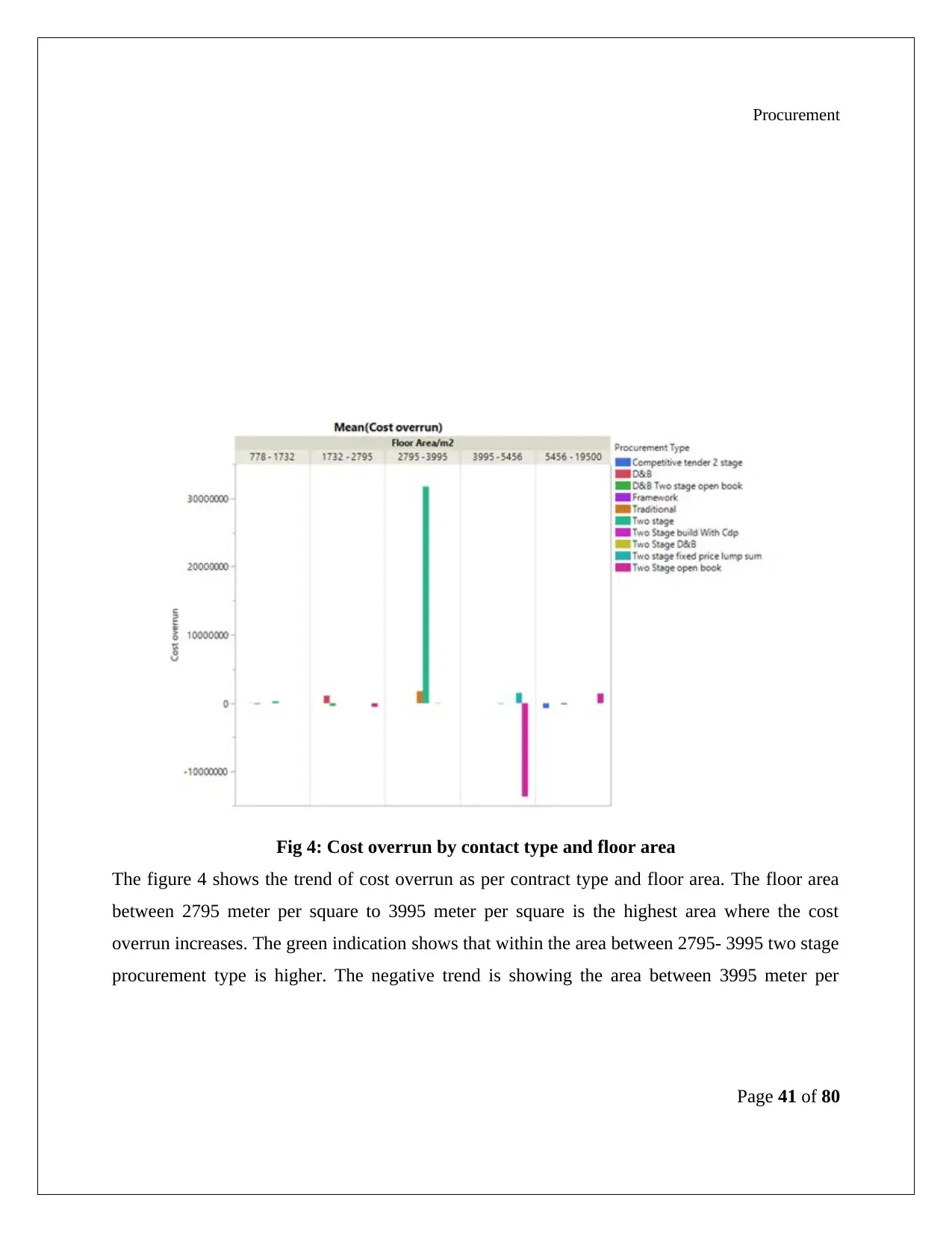
Procurement
Fig 4: Cost overrun by contact type and floor area
The figure 4 shows the trend of cost overrun as per contract type and floor area. The floor area
between 2795 meter per square to 3995 meter per square is the highest area where the cost
overrun increases. The green indication shows that within the area between 2795- 3995 two stage
procurement type is higher. The negative trend is showing the area between 3995 meter per
Page 41 of 80
Fig 4: Cost overrun by contact type and floor area
The figure 4 shows the trend of cost overrun as per contract type and floor area. The floor area
between 2795 meter per square to 3995 meter per square is the highest area where the cost
overrun increases. The green indication shows that within the area between 2795- 3995 two stage
procurement type is higher. The negative trend is showing the area between 3995 meter per
Page 41 of 80
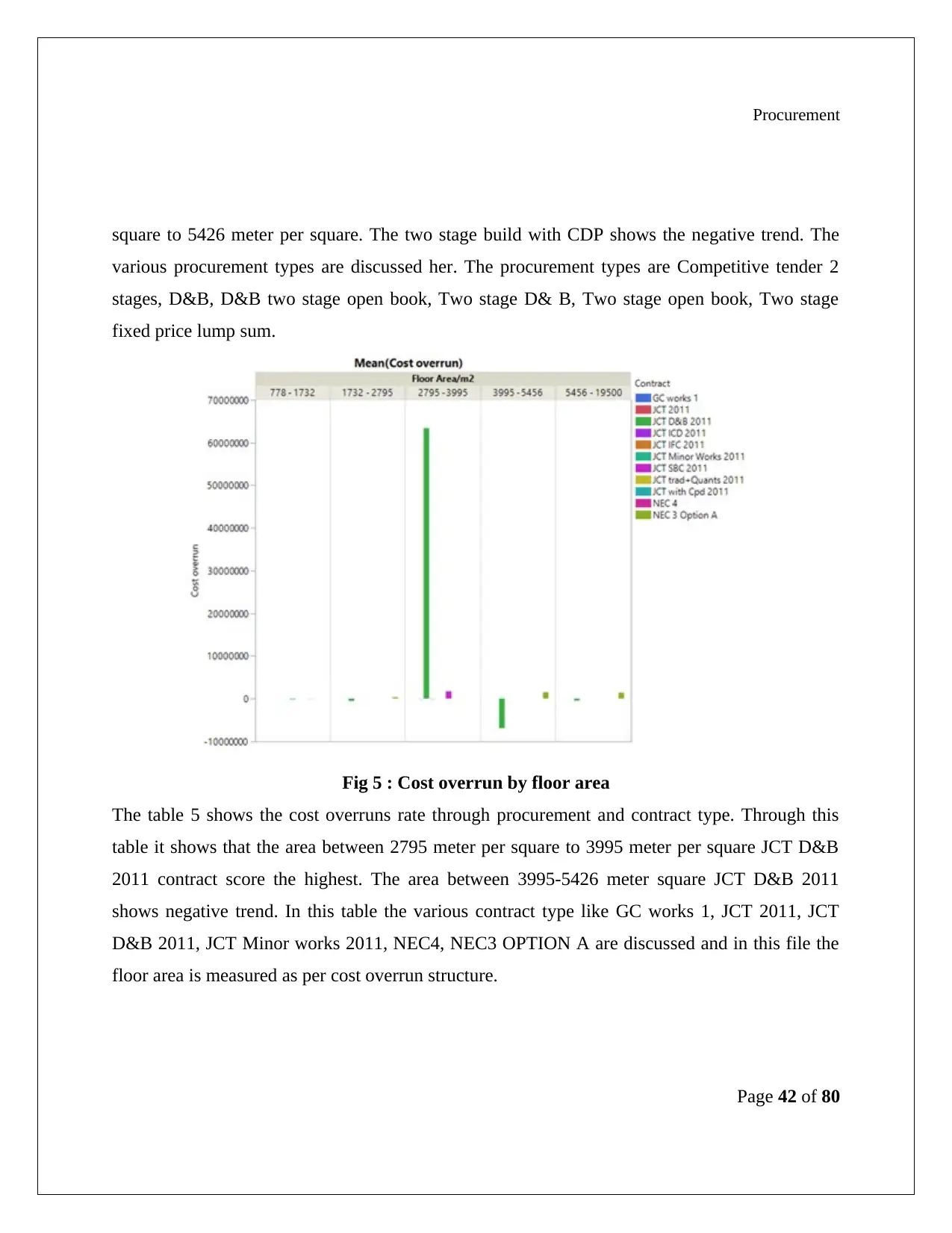
Procurement
square to 5426 meter per square. The two stage build with CDP shows the negative trend. The
various procurement types are discussed her. The procurement types are Competitive tender 2
stages, D&B, D&B two stage open book, Two stage D& B, Two stage open book, Two stage
fixed price lump sum.
Fig 5 : Cost overrun by floor area
The table 5 shows the cost overruns rate through procurement and contract type. Through this
table it shows that the area between 2795 meter per square to 3995 meter per square JCT D&B
2011 contract score the highest. The area between 3995-5426 meter square JCT D&B 2011
shows negative trend. In this table the various contract type like GC works 1, JCT 2011, JCT
D&B 2011, JCT Minor works 2011, NEC4, NEC3 OPTION A are discussed and in this file the
floor area is measured as per cost overrun structure.
Page 42 of 80
square to 5426 meter per square. The two stage build with CDP shows the negative trend. The
various procurement types are discussed her. The procurement types are Competitive tender 2
stages, D&B, D&B two stage open book, Two stage D& B, Two stage open book, Two stage
fixed price lump sum.
Fig 5 : Cost overrun by floor area
The table 5 shows the cost overruns rate through procurement and contract type. Through this
table it shows that the area between 2795 meter per square to 3995 meter per square JCT D&B
2011 contract score the highest. The area between 3995-5426 meter square JCT D&B 2011
shows negative trend. In this table the various contract type like GC works 1, JCT 2011, JCT
D&B 2011, JCT Minor works 2011, NEC4, NEC3 OPTION A are discussed and in this file the
floor area is measured as per cost overrun structure.
Page 42 of 80

Procurement
Fig 6: Cost overrun by contract type and procurement type
The table 6 shows cost overrun by procurement and contract type. In this table JCT D&B 2011
score high the procurement type that they use is two-stage model and the two stage open book
procurement type in JCT D&B 2011 shows the negative trend. In this table various procurement
types like competitive tender, D&B, D&B Two stage model, Two stage open model are varied as
per the cost overrun structure. In this table the JCT D&B 2011 Two stage open model scored the
lowest marks.
Page 43 of 80
Fig 6: Cost overrun by contract type and procurement type
The table 6 shows cost overrun by procurement and contract type. In this table JCT D&B 2011
score high the procurement type that they use is two-stage model and the two stage open book
procurement type in JCT D&B 2011 shows the negative trend. In this table various procurement
types like competitive tender, D&B, D&B Two stage model, Two stage open model are varied as
per the cost overrun structure. In this table the JCT D&B 2011 Two stage open model scored the
lowest marks.
Page 43 of 80
Paraphrase This Document
Need a fresh take? Get an instant paraphrase of this document with our AI Paraphraser
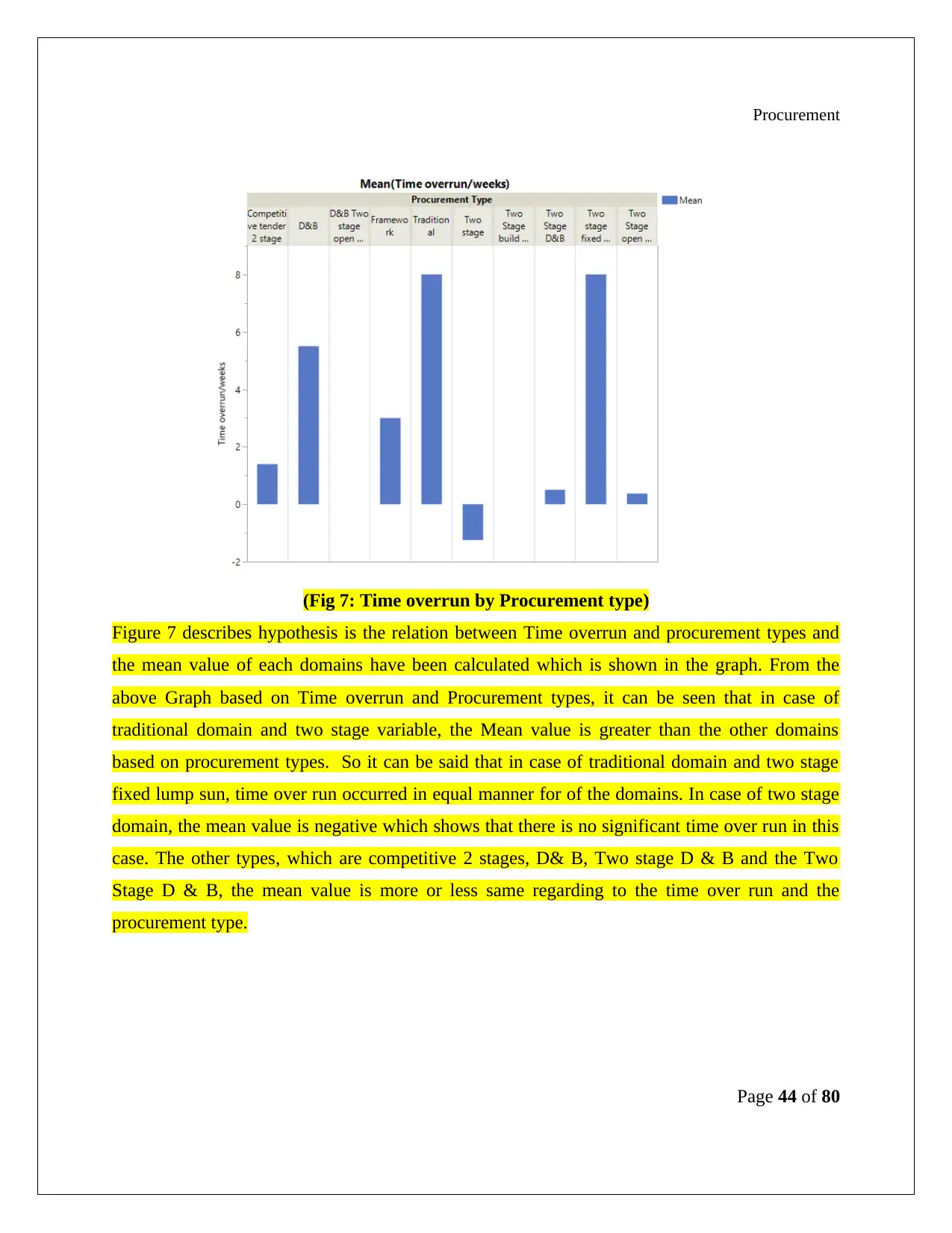
Procurement
(Fig 7: Time overrun by Procurement type)
Figure 7 describes hypothesis is the relation between Time overrun and procurement types and
the mean value of each domains have been calculated which is shown in the graph. From the
above Graph based on Time overrun and Procurement types, it can be seen that in case of
traditional domain and two stage variable, the Mean value is greater than the other domains
based on procurement types. So it can be said that in case of traditional domain and two stage
fixed lump sun, time over run occurred in equal manner for of the domains. In case of two stage
domain, the mean value is negative which shows that there is no significant time over run in this
case. The other types, which are competitive 2 stages, D& B, Two stage D & B and the Two
Stage D & B, the mean value is more or less same regarding to the time over run and the
procurement type.
Page 44 of 80
(Fig 7: Time overrun by Procurement type)
Figure 7 describes hypothesis is the relation between Time overrun and procurement types and
the mean value of each domains have been calculated which is shown in the graph. From the
above Graph based on Time overrun and Procurement types, it can be seen that in case of
traditional domain and two stage variable, the Mean value is greater than the other domains
based on procurement types. So it can be said that in case of traditional domain and two stage
fixed lump sun, time over run occurred in equal manner for of the domains. In case of two stage
domain, the mean value is negative which shows that there is no significant time over run in this
case. The other types, which are competitive 2 stages, D& B, Two stage D & B and the Two
Stage D & B, the mean value is more or less same regarding to the time over run and the
procurement type.
Page 44 of 80

Procurement
(Fig 8 : Time overrun by Contract Type)
The graph is developed based on the relationship between contact type and the time overrun.
From the above graph, it can be said that the mean value of the contact type,”JCTtrad+quants” is
greater than the other contact types. For this particular contact time,, the estimated time period
was 27weeks which has been extended to 41 weeks and time over run occurred. But in case of
the contact type “JCT D&B, 2011”, it can be seen that the mean value is negative. From the data
sheet it is found that for this particular contract the, time period was given 20.6 weeks, but the
contract is completed within 17.2 weeks which can be counted as early termination of the
contract. In case of other contracts which are “NEC Option A” ,”JCT SBC 2011” and “JCT
2011” ,time overrun took place but not extended too much from the contract type where in case
of JCT D&B contact, there is no time overrun.
Page 45 of 80
(Fig 8 : Time overrun by Contract Type)
The graph is developed based on the relationship between contact type and the time overrun.
From the above graph, it can be said that the mean value of the contact type,”JCTtrad+quants” is
greater than the other contact types. For this particular contact time,, the estimated time period
was 27weeks which has been extended to 41 weeks and time over run occurred. But in case of
the contact type “JCT D&B, 2011”, it can be seen that the mean value is negative. From the data
sheet it is found that for this particular contract the, time period was given 20.6 weeks, but the
contract is completed within 17.2 weeks which can be counted as early termination of the
contract. In case of other contracts which are “NEC Option A” ,”JCT SBC 2011” and “JCT
2011” ,time overrun took place but not extended too much from the contract type where in case
of JCT D&B contact, there is no time overrun.
Page 45 of 80
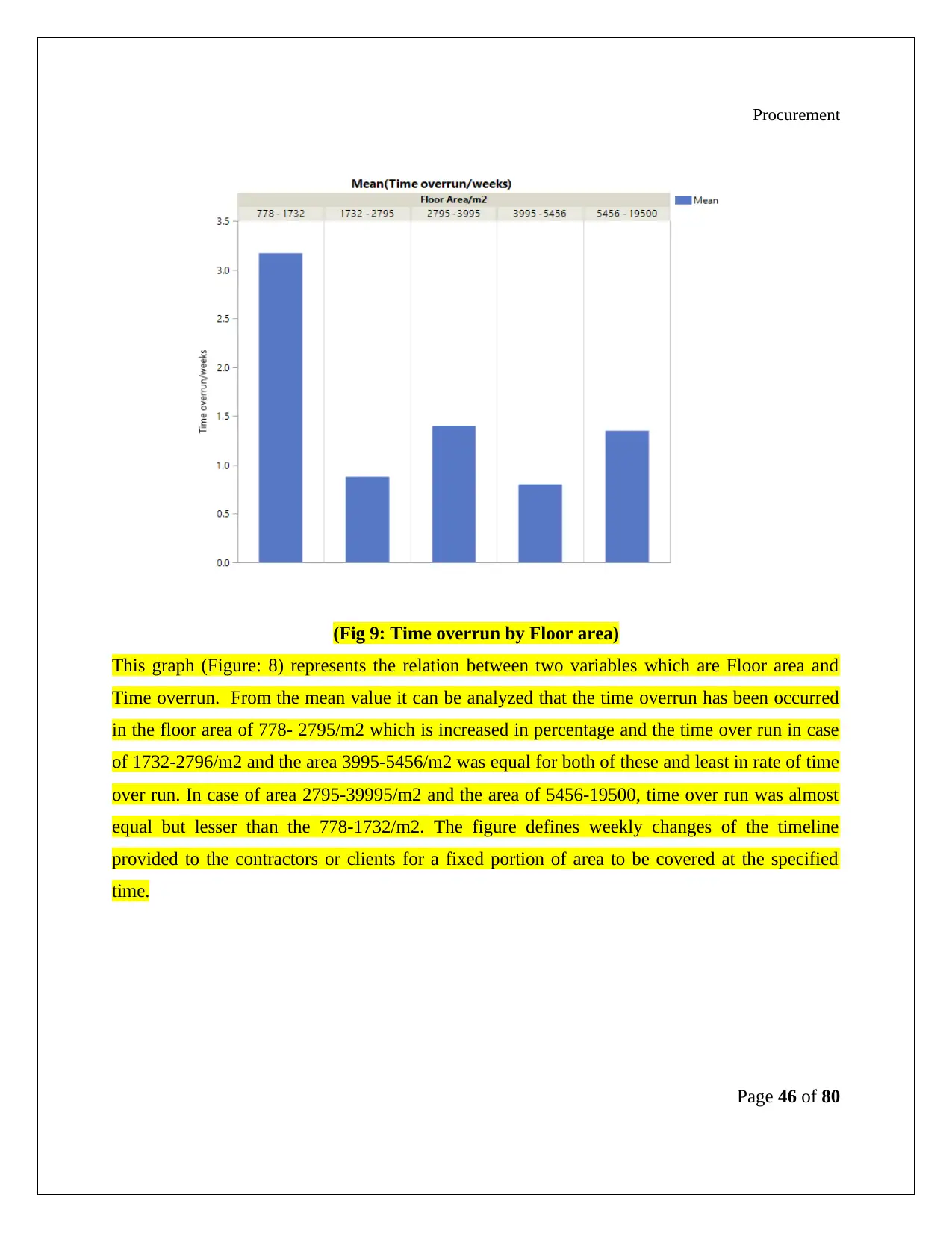
Procurement
(Fig 9: Time overrun by Floor area)
This graph (Figure: 8) represents the relation between two variables which are Floor area and
Time overrun. From the mean value it can be analyzed that the time overrun has been occurred
in the floor area of 778- 2795/m2 which is increased in percentage and the time over run in case
of 1732-2796/m2 and the area 3995-5456/m2 was equal for both of these and least in rate of time
over run. In case of area 2795-39995/m2 and the area of 5456-19500, time over run was almost
equal but lesser than the 778-1732/m2. The figure defines weekly changes of the timeline
provided to the contractors or clients for a fixed portion of area to be covered at the specified
time.
Page 46 of 80
(Fig 9: Time overrun by Floor area)
This graph (Figure: 8) represents the relation between two variables which are Floor area and
Time overrun. From the mean value it can be analyzed that the time overrun has been occurred
in the floor area of 778- 2795/m2 which is increased in percentage and the time over run in case
of 1732-2796/m2 and the area 3995-5456/m2 was equal for both of these and least in rate of time
over run. In case of area 2795-39995/m2 and the area of 5456-19500, time over run was almost
equal but lesser than the 778-1732/m2. The figure defines weekly changes of the timeline
provided to the contractors or clients for a fixed portion of area to be covered at the specified
time.
Page 46 of 80
Secure Best Marks with AI Grader
Need help grading? Try our AI Grader for instant feedback on your assignments.
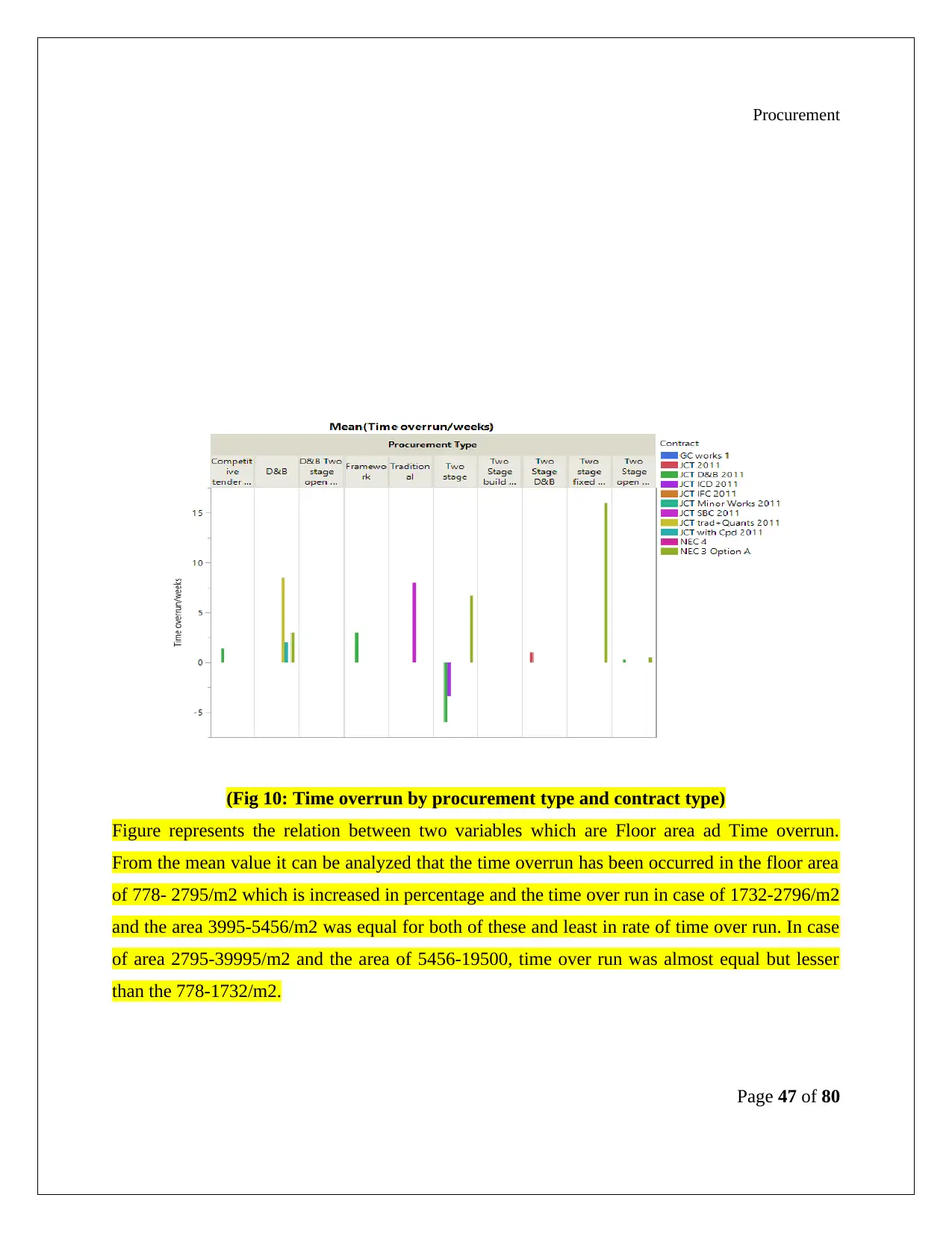
Procurement
(Fig 10: Time overrun by procurement type and contract type)
Figure represents the relation between two variables which are Floor area ad Time overrun.
From the mean value it can be analyzed that the time overrun has been occurred in the floor area
of 778- 2795/m2 which is increased in percentage and the time over run in case of 1732-2796/m2
and the area 3995-5456/m2 was equal for both of these and least in rate of time over run. In case
of area 2795-39995/m2 and the area of 5456-19500, time over run was almost equal but lesser
than the 778-1732/m2.
Page 47 of 80
(Fig 10: Time overrun by procurement type and contract type)
Figure represents the relation between two variables which are Floor area ad Time overrun.
From the mean value it can be analyzed that the time overrun has been occurred in the floor area
of 778- 2795/m2 which is increased in percentage and the time over run in case of 1732-2796/m2
and the area 3995-5456/m2 was equal for both of these and least in rate of time over run. In case
of area 2795-39995/m2 and the area of 5456-19500, time over run was almost equal but lesser
than the 778-1732/m2.
Page 47 of 80
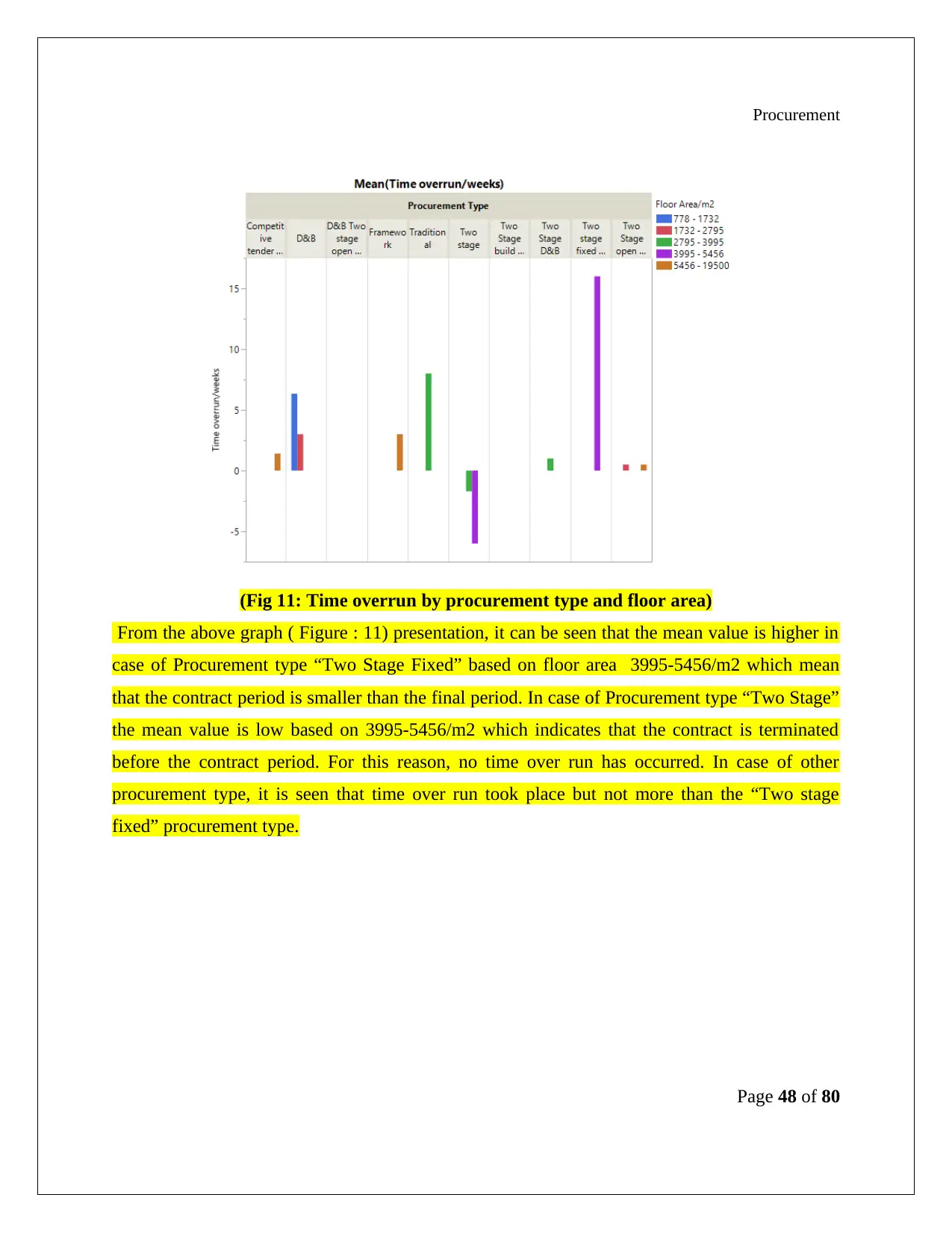
Procurement
(Fig 11: Time overrun by procurement type and floor area)
From the above graph ( Figure : 11) presentation, it can be seen that the mean value is higher in
case of Procurement type “Two Stage Fixed” based on floor area 3995-5456/m2 which mean
that the contract period is smaller than the final period. In case of Procurement type “Two Stage”
the mean value is low based on 3995-5456/m2 which indicates that the contract is terminated
before the contract period. For this reason, no time over run has occurred. In case of other
procurement type, it is seen that time over run took place but not more than the “Two stage
fixed” procurement type.
Page 48 of 80
(Fig 11: Time overrun by procurement type and floor area)
From the above graph ( Figure : 11) presentation, it can be seen that the mean value is higher in
case of Procurement type “Two Stage Fixed” based on floor area 3995-5456/m2 which mean
that the contract period is smaller than the final period. In case of Procurement type “Two Stage”
the mean value is low based on 3995-5456/m2 which indicates that the contract is terminated
before the contract period. For this reason, no time over run has occurred. In case of other
procurement type, it is seen that time over run took place but not more than the “Two stage
fixed” procurement type.
Page 48 of 80
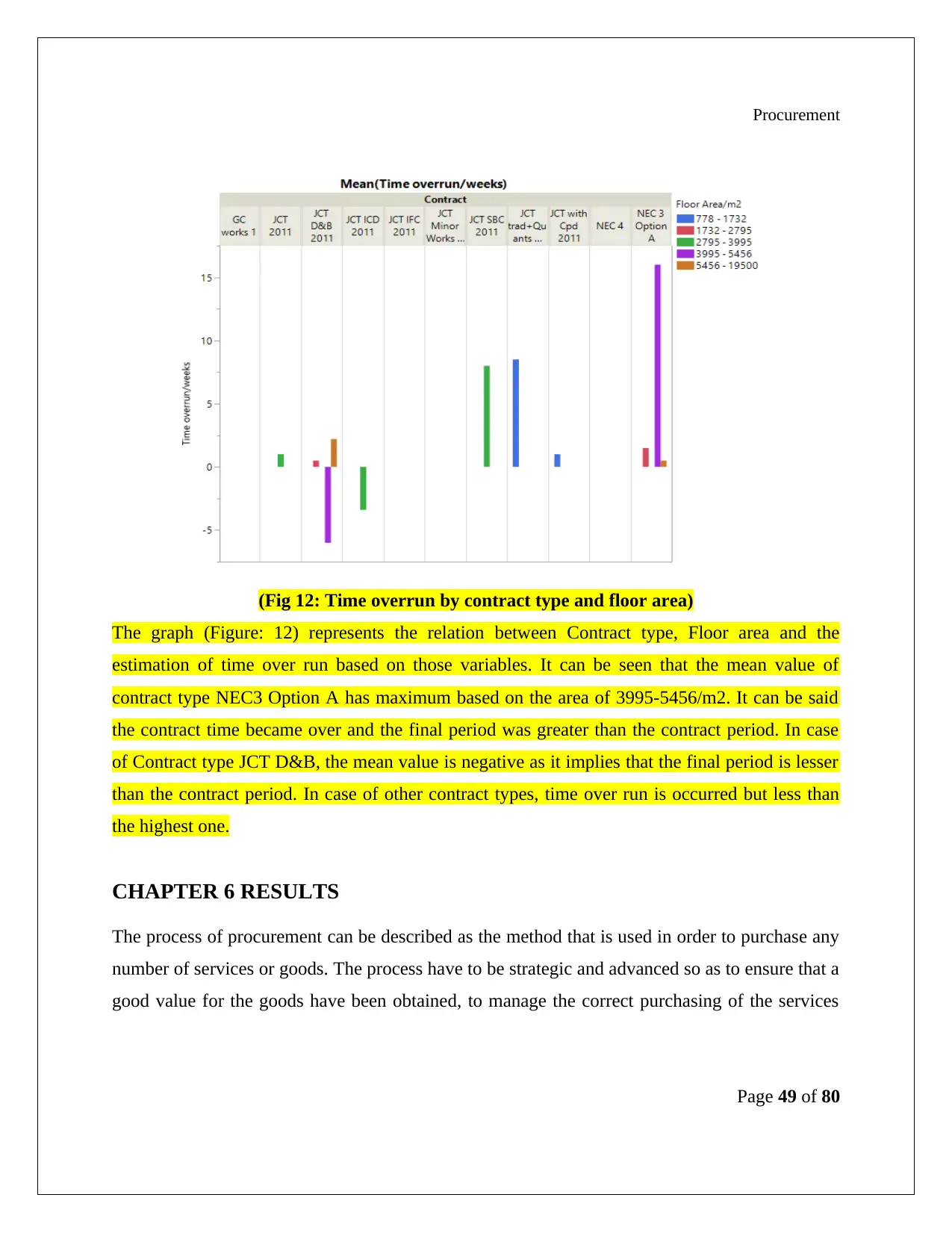
Procurement
(Fig 12: Time overrun by contract type and floor area)
The graph (Figure: 12) represents the relation between Contract type, Floor area and the
estimation of time over run based on those variables. It can be seen that the mean value of
contract type NEC3 Option A has maximum based on the area of 3995-5456/m2. It can be said
the contract time became over and the final period was greater than the contract period. In case
of Contract type JCT D&B, the mean value is negative as it implies that the final period is lesser
than the contract period. In case of other contract types, time over run is occurred but less than
the highest one.
CHAPTER 6 RESULTS
The process of procurement can be described as the method that is used in order to purchase any
number of services or goods. The process have to be strategic and advanced so as to ensure that a
good value for the goods have been obtained, to manage the correct purchasing of the services
Page 49 of 80
(Fig 12: Time overrun by contract type and floor area)
The graph (Figure: 12) represents the relation between Contract type, Floor area and the
estimation of time over run based on those variables. It can be seen that the mean value of
contract type NEC3 Option A has maximum based on the area of 3995-5456/m2. It can be said
the contract time became over and the final period was greater than the contract period. In case
of Contract type JCT D&B, the mean value is negative as it implies that the final period is lesser
than the contract period. In case of other contract types, time over run is occurred but less than
the highest one.
CHAPTER 6 RESULTS
The process of procurement can be described as the method that is used in order to purchase any
number of services or goods. The process have to be strategic and advanced so as to ensure that a
good value for the goods have been obtained, to manage the correct purchasing of the services
Page 49 of 80
Paraphrase This Document
Need a fresh take? Get an instant paraphrase of this document with our AI Paraphraser

Procurement
and the products that are of very high quality but all the timescales and the deadlines are met
while buying them out, which helps in the establishment of a good and well developed
relationship that can be maintained between the two parties, the supplier and the procurer. In the
field of construction the process relates to the selection of a main contractor to carry on with the
construction work. The procurement strategy can be stated as the key through which a successful
result can be formulated. It focuses on issues such as risk, speed, programme, cost, financing,
quality, project constraints of specific kind and asset ownership. The route of the process
generally follows a number of steps towards selecting the right contractor. These involve:
The traditional contract
The single-stage build and design
Management contract
Two-stage build and design
PFI
The research that has been carried on in this paper thrives to provide further significant aspects
of the process and it can be utilized in various situations and areas of construction. The process
also involves the people who are part of the construction project. The people who would live
within the houses, their health, lifestyles, family size, security, etc., matters when a project is
under construction. Therefore, the value of the property lies within the understanding of these
aspects too. The researcher has conducted a detailed interview focusing on the following aspects
of the lives of the people related to the project:
The health and the well-being of the people.
The wealth of these people and their lifestyle
The family and friends
The location and security aspect
The design as well as the accessibility
It has been observed that 41.8% people disagreed to restoring to the downsizing of property
because of the deterioration in their health and 38.1% people agreed to the aspect of downsizing
Page 50 of 80
and the products that are of very high quality but all the timescales and the deadlines are met
while buying them out, which helps in the establishment of a good and well developed
relationship that can be maintained between the two parties, the supplier and the procurer. In the
field of construction the process relates to the selection of a main contractor to carry on with the
construction work. The procurement strategy can be stated as the key through which a successful
result can be formulated. It focuses on issues such as risk, speed, programme, cost, financing,
quality, project constraints of specific kind and asset ownership. The route of the process
generally follows a number of steps towards selecting the right contractor. These involve:
The traditional contract
The single-stage build and design
Management contract
Two-stage build and design
PFI
The research that has been carried on in this paper thrives to provide further significant aspects
of the process and it can be utilized in various situations and areas of construction. The process
also involves the people who are part of the construction project. The people who would live
within the houses, their health, lifestyles, family size, security, etc., matters when a project is
under construction. Therefore, the value of the property lies within the understanding of these
aspects too. The researcher has conducted a detailed interview focusing on the following aspects
of the lives of the people related to the project:
The health and the well-being of the people.
The wealth of these people and their lifestyle
The family and friends
The location and security aspect
The design as well as the accessibility
It has been observed that 41.8% people disagreed to restoring to the downsizing of property
because of the deterioration in their health and 38.1% people agreed to the aspect of downsizing
Page 50 of 80
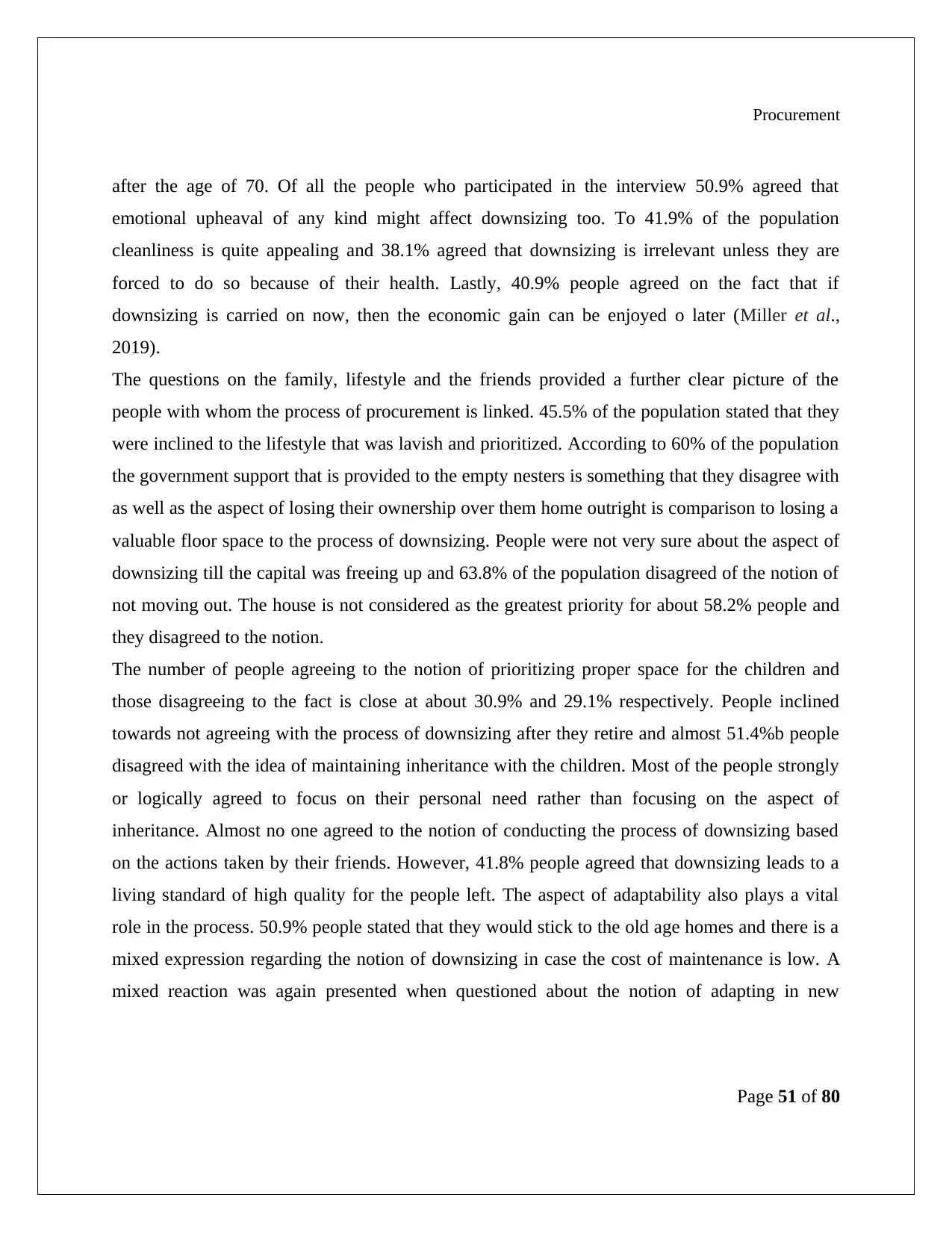
Procurement
after the age of 70. Of all the people who participated in the interview 50.9% agreed that
emotional upheaval of any kind might affect downsizing too. To 41.9% of the population
cleanliness is quite appealing and 38.1% agreed that downsizing is irrelevant unless they are
forced to do so because of their health. Lastly, 40.9% people agreed on the fact that if
downsizing is carried on now, then the economic gain can be enjoyed o later (Miller et al.,
2019).
The questions on the family, lifestyle and the friends provided a further clear picture of the
people with whom the process of procurement is linked. 45.5% of the population stated that they
were inclined to the lifestyle that was lavish and prioritized. According to 60% of the population
the government support that is provided to the empty nesters is something that they disagree with
as well as the aspect of losing their ownership over them home outright is comparison to losing a
valuable floor space to the process of downsizing. People were not very sure about the aspect of
downsizing till the capital was freeing up and 63.8% of the population disagreed of the notion of
not moving out. The house is not considered as the greatest priority for about 58.2% people and
they disagreed to the notion.
The number of people agreeing to the notion of prioritizing proper space for the children and
those disagreeing to the fact is close at about 30.9% and 29.1% respectively. People inclined
towards not agreeing with the process of downsizing after they retire and almost 51.4%b people
disagreed with the idea of maintaining inheritance with the children. Most of the people strongly
or logically agreed to focus on their personal need rather than focusing on the aspect of
inheritance. Almost no one agreed to the notion of conducting the process of downsizing based
on the actions taken by their friends. However, 41.8% people agreed that downsizing leads to a
living standard of high quality for the people left. The aspect of adaptability also plays a vital
role in the process. 50.9% people stated that they would stick to the old age homes and there is a
mixed expression regarding the notion of downsizing in case the cost of maintenance is low. A
mixed reaction was again presented when questioned about the notion of adapting in new
Page 51 of 80
after the age of 70. Of all the people who participated in the interview 50.9% agreed that
emotional upheaval of any kind might affect downsizing too. To 41.9% of the population
cleanliness is quite appealing and 38.1% agreed that downsizing is irrelevant unless they are
forced to do so because of their health. Lastly, 40.9% people agreed on the fact that if
downsizing is carried on now, then the economic gain can be enjoyed o later (Miller et al.,
2019).
The questions on the family, lifestyle and the friends provided a further clear picture of the
people with whom the process of procurement is linked. 45.5% of the population stated that they
were inclined to the lifestyle that was lavish and prioritized. According to 60% of the population
the government support that is provided to the empty nesters is something that they disagree with
as well as the aspect of losing their ownership over them home outright is comparison to losing a
valuable floor space to the process of downsizing. People were not very sure about the aspect of
downsizing till the capital was freeing up and 63.8% of the population disagreed of the notion of
not moving out. The house is not considered as the greatest priority for about 58.2% people and
they disagreed to the notion.
The number of people agreeing to the notion of prioritizing proper space for the children and
those disagreeing to the fact is close at about 30.9% and 29.1% respectively. People inclined
towards not agreeing with the process of downsizing after they retire and almost 51.4%b people
disagreed with the idea of maintaining inheritance with the children. Most of the people strongly
or logically agreed to focus on their personal need rather than focusing on the aspect of
inheritance. Almost no one agreed to the notion of conducting the process of downsizing based
on the actions taken by their friends. However, 41.8% people agreed that downsizing leads to a
living standard of high quality for the people left. The aspect of adaptability also plays a vital
role in the process. 50.9% people stated that they would stick to the old age homes and there is a
mixed expression regarding the notion of downsizing in case the cost of maintenance is low. A
mixed reaction was again presented when questioned about the notion of adapting in new
Page 51 of 80

Procurement
conditions and about 41.8% of the population was neutral on the aspect of depending on the
better provisions that were being provided by the new facility.
When questioned about the concept of safety related to the process of downsizing 50.9% people
agreed on the fact that safety has to be considered as a priority over downsizing. 39.9% people
agreed upon finding a safer and a better facility and 36.6% of the population could not decide
upon whether the aspect of downsizing has to be unavailable to the older people in the poorer
facilities. Again, 43.6% of the population had no specific idea whether they would like to have a
view on the living opportunities that are better. The key benefits like Competitive Advantages,
Efficiency, Effectiveness, Morale, and Retention required thriving in the workplace.
Furthermore, a greater number of people agreed on the proposition to build bungalows in greater
numbers. The notion of building greater number of retirement villages was an aspect that had a
mixed reaction of people agreeing or disagreeing to it. People presented that they preferred
detached houses over flats, bungalows or semidetached houses. The year of purchase for 43.9%
of the population was from 1981 to the year 1991. The population agreed mostly to the aspect of
providing facilities for the older generations. All the aspects and facts presented in the paper
gives a clearer version of how the aspect of procurement and of downsizing is perceived amongst
the population selected for the appropriate development of the study. These are the feedback that
have been gathered and which further academics can work on in order to generate necessary
results regarding this topic.
Chapter 7- Discussion
Weston College gave the floor work of area 5456 sqm to the contractor JCT D&B 2011. The
sum which was finalized for this work was 8722853 and the time period which was allocated to
complete the project was 52.6 week. The contractor has used Competitive tender 2 stage
procurement type. Millbank House provided the floor work of area 4737 sqm to the contractor
GC works 1. The amount which was finalized for this floor work was 23100000 and the time
Page 52 of 80
conditions and about 41.8% of the population was neutral on the aspect of depending on the
better provisions that were being provided by the new facility.
When questioned about the concept of safety related to the process of downsizing 50.9% people
agreed on the fact that safety has to be considered as a priority over downsizing. 39.9% people
agreed upon finding a safer and a better facility and 36.6% of the population could not decide
upon whether the aspect of downsizing has to be unavailable to the older people in the poorer
facilities. Again, 43.6% of the population had no specific idea whether they would like to have a
view on the living opportunities that are better. The key benefits like Competitive Advantages,
Efficiency, Effectiveness, Morale, and Retention required thriving in the workplace.
Furthermore, a greater number of people agreed on the proposition to build bungalows in greater
numbers. The notion of building greater number of retirement villages was an aspect that had a
mixed reaction of people agreeing or disagreeing to it. People presented that they preferred
detached houses over flats, bungalows or semidetached houses. The year of purchase for 43.9%
of the population was from 1981 to the year 1991. The population agreed mostly to the aspect of
providing facilities for the older generations. All the aspects and facts presented in the paper
gives a clearer version of how the aspect of procurement and of downsizing is perceived amongst
the population selected for the appropriate development of the study. These are the feedback that
have been gathered and which further academics can work on in order to generate necessary
results regarding this topic.
Chapter 7- Discussion
Weston College gave the floor work of area 5456 sqm to the contractor JCT D&B 2011. The
sum which was finalized for this work was 8722853 and the time period which was allocated to
complete the project was 52.6 week. The contractor has used Competitive tender 2 stage
procurement type. Millbank House provided the floor work of area 4737 sqm to the contractor
GC works 1. The amount which was finalized for this floor work was 23100000 and the time
Page 52 of 80
Secure Best Marks with AI Grader
Need help grading? Try our AI Grader for instant feedback on your assignments.
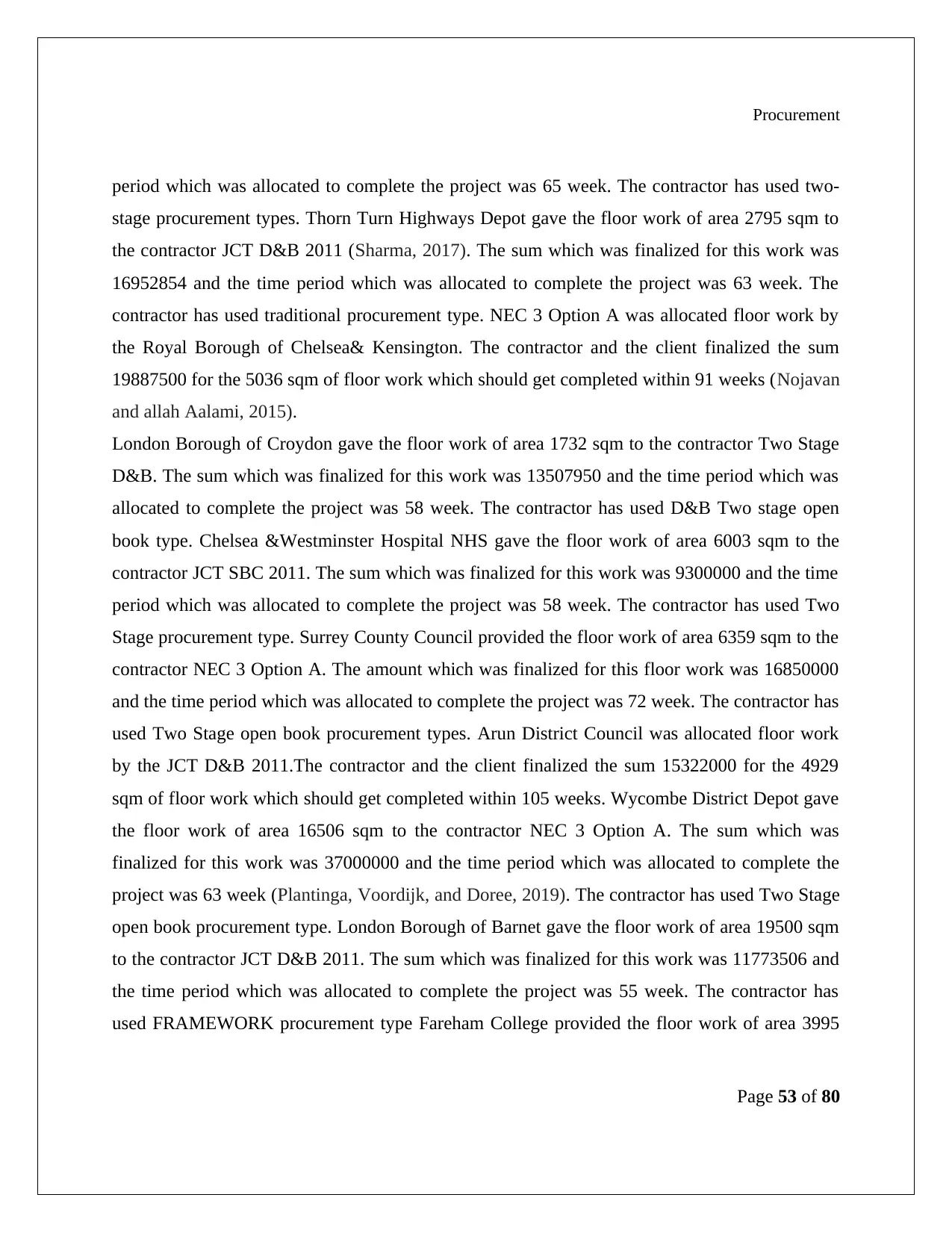
Procurement
period which was allocated to complete the project was 65 week. The contractor has used two-
stage procurement types. Thorn Turn Highways Depot gave the floor work of area 2795 sqm to
the contractor JCT D&B 2011 (Sharma, 2017). The sum which was finalized for this work was
16952854 and the time period which was allocated to complete the project was 63 week. The
contractor has used traditional procurement type. NEC 3 Option A was allocated floor work by
the Royal Borough of Chelsea& Kensington. The contractor and the client finalized the sum
19887500 for the 5036 sqm of floor work which should get completed within 91 weeks (Nojavan
and allah Aalami, 2015).
London Borough of Croydon gave the floor work of area 1732 sqm to the contractor Two Stage
D&B. The sum which was finalized for this work was 13507950 and the time period which was
allocated to complete the project was 58 week. The contractor has used D&B Two stage open
book type. Chelsea &Westminster Hospital NHS gave the floor work of area 6003 sqm to the
contractor JCT SBC 2011. The sum which was finalized for this work was 9300000 and the time
period which was allocated to complete the project was 58 week. The contractor has used Two
Stage procurement type. Surrey County Council provided the floor work of area 6359 sqm to the
contractor NEC 3 Option A. The amount which was finalized for this floor work was 16850000
and the time period which was allocated to complete the project was 72 week. The contractor has
used Two Stage open book procurement types. Arun District Council was allocated floor work
by the JCT D&B 2011.The contractor and the client finalized the sum 15322000 for the 4929
sqm of floor work which should get completed within 105 weeks. Wycombe District Depot gave
the floor work of area 16506 sqm to the contractor NEC 3 Option A. The sum which was
finalized for this work was 37000000 and the time period which was allocated to complete the
project was 63 week (Plantinga, Voordijk, and Doree, 2019). The contractor has used Two Stage
open book procurement type. London Borough of Barnet gave the floor work of area 19500 sqm
to the contractor JCT D&B 2011. The sum which was finalized for this work was 11773506 and
the time period which was allocated to complete the project was 55 week. The contractor has
used FRAMEWORK procurement type Fareham College provided the floor work of area 3995
Page 53 of 80
period which was allocated to complete the project was 65 week. The contractor has used two-
stage procurement types. Thorn Turn Highways Depot gave the floor work of area 2795 sqm to
the contractor JCT D&B 2011 (Sharma, 2017). The sum which was finalized for this work was
16952854 and the time period which was allocated to complete the project was 63 week. The
contractor has used traditional procurement type. NEC 3 Option A was allocated floor work by
the Royal Borough of Chelsea& Kensington. The contractor and the client finalized the sum
19887500 for the 5036 sqm of floor work which should get completed within 91 weeks (Nojavan
and allah Aalami, 2015).
London Borough of Croydon gave the floor work of area 1732 sqm to the contractor Two Stage
D&B. The sum which was finalized for this work was 13507950 and the time period which was
allocated to complete the project was 58 week. The contractor has used D&B Two stage open
book type. Chelsea &Westminster Hospital NHS gave the floor work of area 6003 sqm to the
contractor JCT SBC 2011. The sum which was finalized for this work was 9300000 and the time
period which was allocated to complete the project was 58 week. The contractor has used Two
Stage procurement type. Surrey County Council provided the floor work of area 6359 sqm to the
contractor NEC 3 Option A. The amount which was finalized for this floor work was 16850000
and the time period which was allocated to complete the project was 72 week. The contractor has
used Two Stage open book procurement types. Arun District Council was allocated floor work
by the JCT D&B 2011.The contractor and the client finalized the sum 15322000 for the 4929
sqm of floor work which should get completed within 105 weeks. Wycombe District Depot gave
the floor work of area 16506 sqm to the contractor NEC 3 Option A. The sum which was
finalized for this work was 37000000 and the time period which was allocated to complete the
project was 63 week (Plantinga, Voordijk, and Doree, 2019). The contractor has used Two Stage
open book procurement type. London Borough of Barnet gave the floor work of area 19500 sqm
to the contractor JCT D&B 2011. The sum which was finalized for this work was 11773506 and
the time period which was allocated to complete the project was 55 week. The contractor has
used FRAMEWORK procurement type Fareham College provided the floor work of area 3995
Page 53 of 80
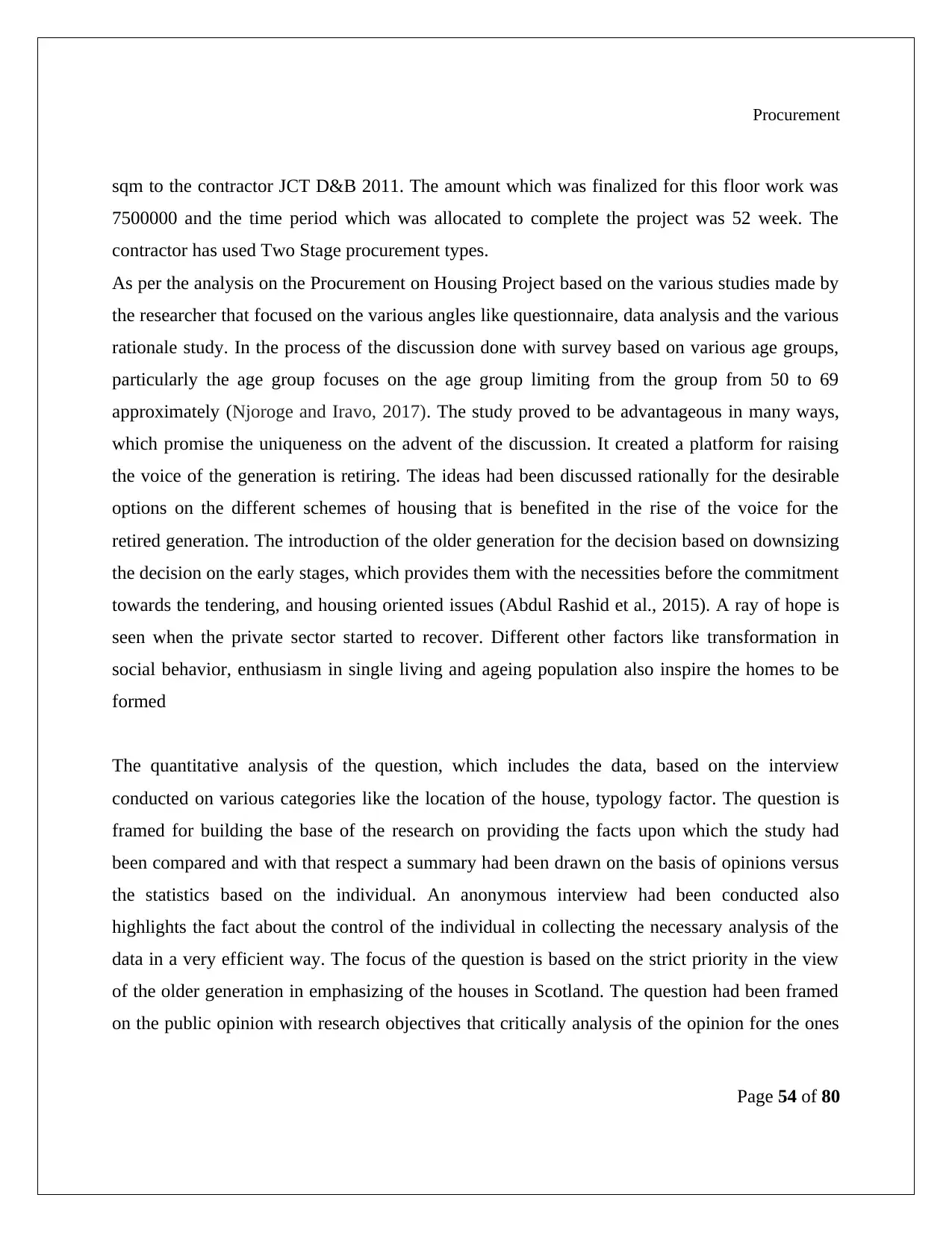
Procurement
sqm to the contractor JCT D&B 2011. The amount which was finalized for this floor work was
7500000 and the time period which was allocated to complete the project was 52 week. The
contractor has used Two Stage procurement types.
As per the analysis on the Procurement on Housing Project based on the various studies made by
the researcher that focused on the various angles like questionnaire, data analysis and the various
rationale study. In the process of the discussion done with survey based on various age groups,
particularly the age group focuses on the age group limiting from the group from 50 to 69
approximately (Njoroge and Iravo, 2017). The study proved to be advantageous in many ways,
which promise the uniqueness on the advent of the discussion. It created a platform for raising
the voice of the generation is retiring. The ideas had been discussed rationally for the desirable
options on the different schemes of housing that is benefited in the rise of the voice for the
retired generation. The introduction of the older generation for the decision based on downsizing
the decision on the early stages, which provides them with the necessities before the commitment
towards the tendering, and housing oriented issues (Abdul Rashid et al., 2015). A ray of hope is
seen when the private sector started to recover. Different other factors like transformation in
social behavior, enthusiasm in single living and ageing population also inspire the homes to be
formed
The quantitative analysis of the question, which includes the data, based on the interview
conducted on various categories like the location of the house, typology factor. The question is
framed for building the base of the research on providing the facts upon which the study had
been compared and with that respect a summary had been drawn on the basis of opinions versus
the statistics based on the individual. An anonymous interview had been conducted also
highlights the fact about the control of the individual in collecting the necessary analysis of the
data in a very efficient way. The focus of the question is based on the strict priority in the view
of the older generation in emphasizing of the houses in Scotland. The question had been framed
on the public opinion with research objectives that critically analysis of the opinion for the ones
Page 54 of 80
sqm to the contractor JCT D&B 2011. The amount which was finalized for this floor work was
7500000 and the time period which was allocated to complete the project was 52 week. The
contractor has used Two Stage procurement types.
As per the analysis on the Procurement on Housing Project based on the various studies made by
the researcher that focused on the various angles like questionnaire, data analysis and the various
rationale study. In the process of the discussion done with survey based on various age groups,
particularly the age group focuses on the age group limiting from the group from 50 to 69
approximately (Njoroge and Iravo, 2017). The study proved to be advantageous in many ways,
which promise the uniqueness on the advent of the discussion. It created a platform for raising
the voice of the generation is retiring. The ideas had been discussed rationally for the desirable
options on the different schemes of housing that is benefited in the rise of the voice for the
retired generation. The introduction of the older generation for the decision based on downsizing
the decision on the early stages, which provides them with the necessities before the commitment
towards the tendering, and housing oriented issues (Abdul Rashid et al., 2015). A ray of hope is
seen when the private sector started to recover. Different other factors like transformation in
social behavior, enthusiasm in single living and ageing population also inspire the homes to be
formed
The quantitative analysis of the question, which includes the data, based on the interview
conducted on various categories like the location of the house, typology factor. The question is
framed for building the base of the research on providing the facts upon which the study had
been compared and with that respect a summary had been drawn on the basis of opinions versus
the statistics based on the individual. An anonymous interview had been conducted also
highlights the fact about the control of the individual in collecting the necessary analysis of the
data in a very efficient way. The focus of the question is based on the strict priority in the view
of the older generation in emphasizing of the houses in Scotland. The question had been framed
on the public opinion with research objectives that critically analysis of the opinion for the ones
Page 54 of 80
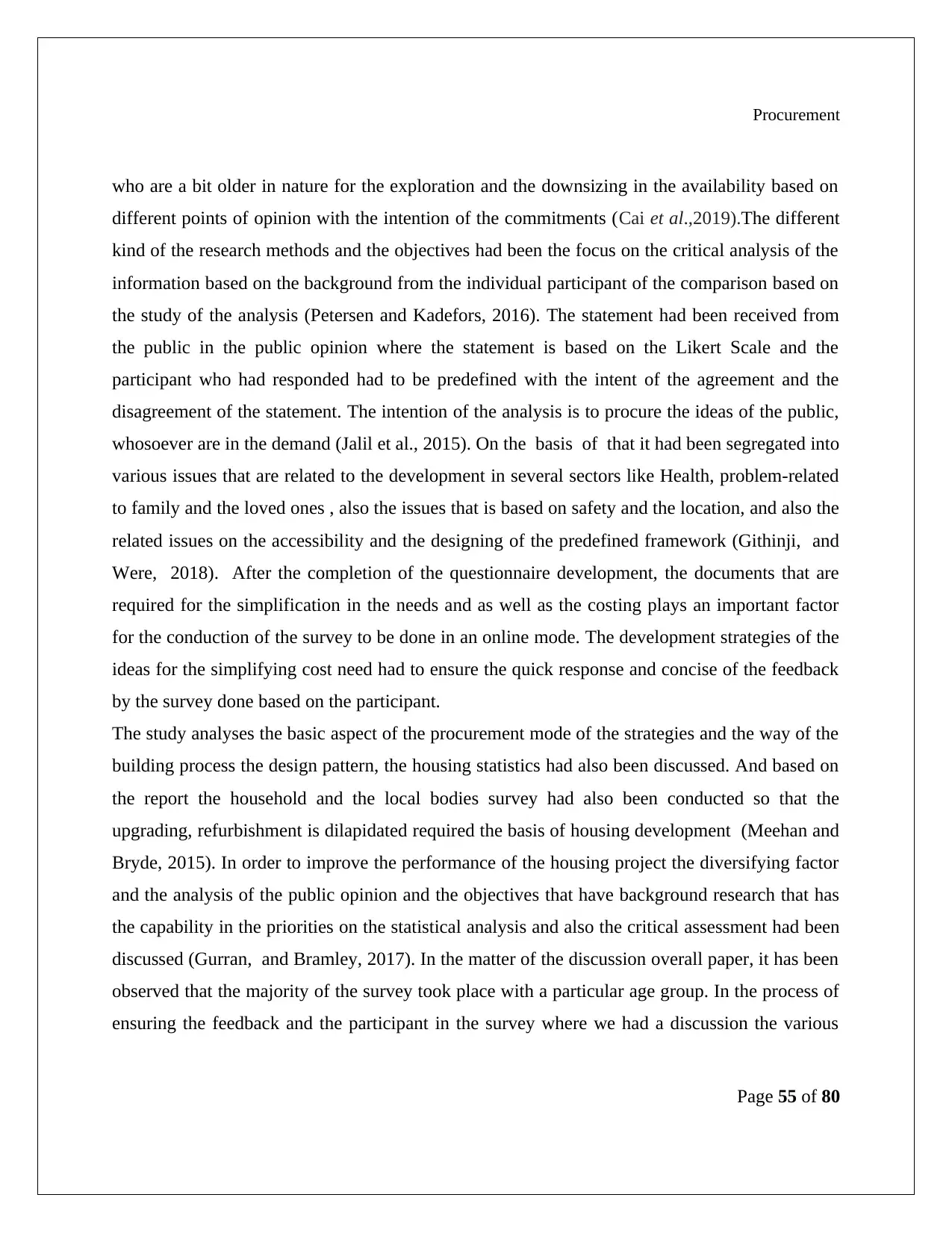
Procurement
who are a bit older in nature for the exploration and the downsizing in the availability based on
different points of opinion with the intention of the commitments (Cai et al.,2019).The different
kind of the research methods and the objectives had been the focus on the critical analysis of the
information based on the background from the individual participant of the comparison based on
the study of the analysis (Petersen and Kadefors, 2016). The statement had been received from
the public in the public opinion where the statement is based on the Likert Scale and the
participant who had responded had to be predefined with the intent of the agreement and the
disagreement of the statement. The intention of the analysis is to procure the ideas of the public,
whosoever are in the demand (Jalil et al., 2015). On the basis of that it had been segregated into
various issues that are related to the development in several sectors like Health, problem-related
to family and the loved ones , also the issues that is based on safety and the location, and also the
related issues on the accessibility and the designing of the predefined framework (Githinji, and
Were, 2018). After the completion of the questionnaire development, the documents that are
required for the simplification in the needs and as well as the costing plays an important factor
for the conduction of the survey to be done in an online mode. The development strategies of the
ideas for the simplifying cost need had to ensure the quick response and concise of the feedback
by the survey done based on the participant.
The study analyses the basic aspect of the procurement mode of the strategies and the way of the
building process the design pattern, the housing statistics had also been discussed. And based on
the report the household and the local bodies survey had also been conducted so that the
upgrading, refurbishment is dilapidated required the basis of housing development (Meehan and
Bryde, 2015). In order to improve the performance of the housing project the diversifying factor
and the analysis of the public opinion and the objectives that have background research that has
the capability in the priorities on the statistical analysis and also the critical assessment had been
discussed (Gurran, and Bramley, 2017). In the matter of the discussion overall paper, it has been
observed that the majority of the survey took place with a particular age group. In the process of
ensuring the feedback and the participant in the survey where we had a discussion the various
Page 55 of 80
who are a bit older in nature for the exploration and the downsizing in the availability based on
different points of opinion with the intention of the commitments (Cai et al.,2019).The different
kind of the research methods and the objectives had been the focus on the critical analysis of the
information based on the background from the individual participant of the comparison based on
the study of the analysis (Petersen and Kadefors, 2016). The statement had been received from
the public in the public opinion where the statement is based on the Likert Scale and the
participant who had responded had to be predefined with the intent of the agreement and the
disagreement of the statement. The intention of the analysis is to procure the ideas of the public,
whosoever are in the demand (Jalil et al., 2015). On the basis of that it had been segregated into
various issues that are related to the development in several sectors like Health, problem-related
to family and the loved ones , also the issues that is based on safety and the location, and also the
related issues on the accessibility and the designing of the predefined framework (Githinji, and
Were, 2018). After the completion of the questionnaire development, the documents that are
required for the simplification in the needs and as well as the costing plays an important factor
for the conduction of the survey to be done in an online mode. The development strategies of the
ideas for the simplifying cost need had to ensure the quick response and concise of the feedback
by the survey done based on the participant.
The study analyses the basic aspect of the procurement mode of the strategies and the way of the
building process the design pattern, the housing statistics had also been discussed. And based on
the report the household and the local bodies survey had also been conducted so that the
upgrading, refurbishment is dilapidated required the basis of housing development (Meehan and
Bryde, 2015). In order to improve the performance of the housing project the diversifying factor
and the analysis of the public opinion and the objectives that have background research that has
the capability in the priorities on the statistical analysis and also the critical assessment had been
discussed (Gurran, and Bramley, 2017). In the matter of the discussion overall paper, it has been
observed that the majority of the survey took place with a particular age group. In the process of
ensuring the feedback and the participant in the survey where we had a discussion the various
Page 55 of 80
Paraphrase This Document
Need a fresh take? Get an instant paraphrase of this document with our AI Paraphraser
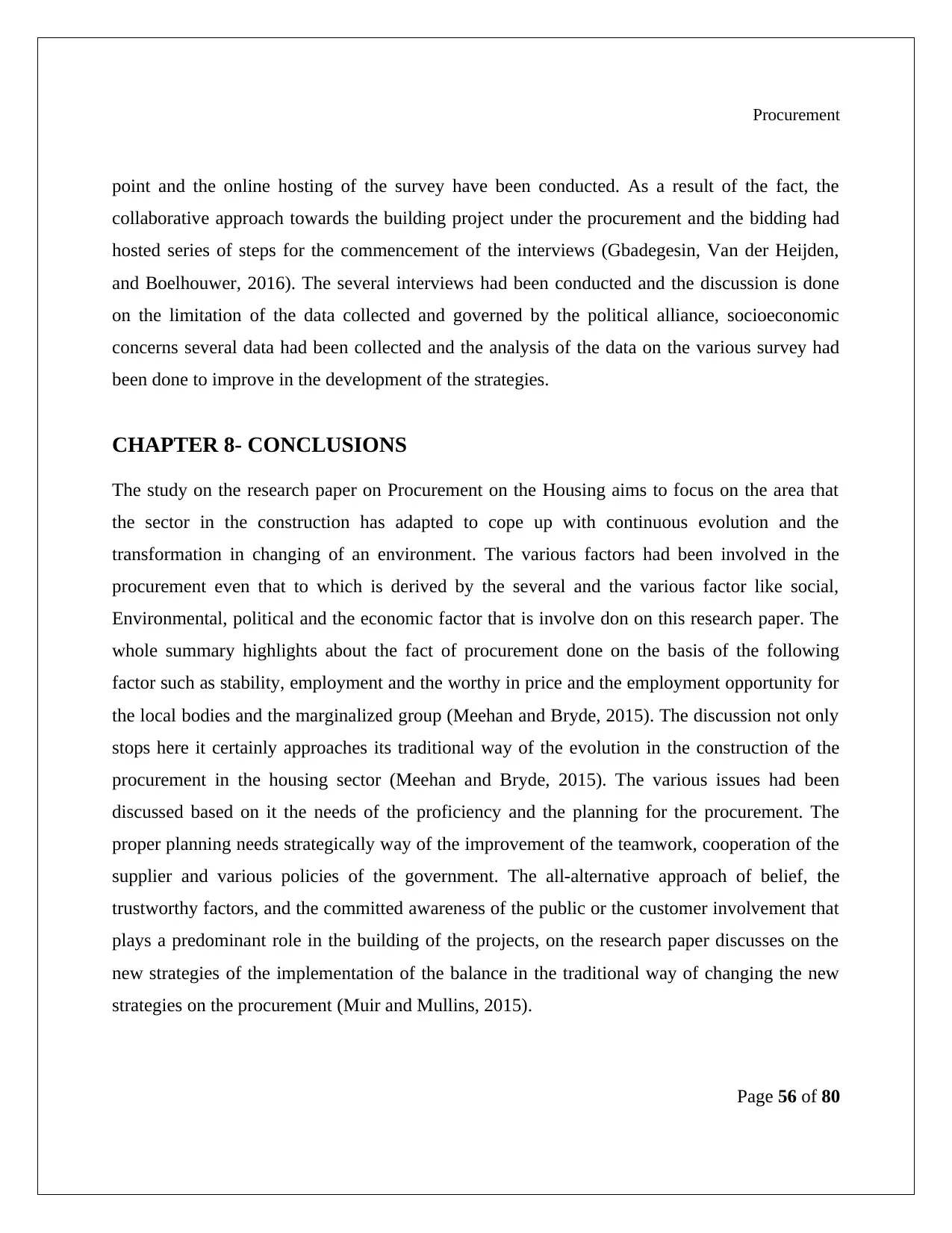
Procurement
point and the online hosting of the survey have been conducted. As a result of the fact, the
collaborative approach towards the building project under the procurement and the bidding had
hosted series of steps for the commencement of the interviews (Gbadegesin, Van der Heijden,
and Boelhouwer, 2016). The several interviews had been conducted and the discussion is done
on the limitation of the data collected and governed by the political alliance, socioeconomic
concerns several data had been collected and the analysis of the data on the various survey had
been done to improve in the development of the strategies.
CHAPTER 8- CONCLUSIONS
The study on the research paper on Procurement on the Housing aims to focus on the area that
the sector in the construction has adapted to cope up with continuous evolution and the
transformation in changing of an environment. The various factors had been involved in the
procurement even that to which is derived by the several and the various factor like social,
Environmental, political and the economic factor that is involve don on this research paper. The
whole summary highlights about the fact of procurement done on the basis of the following
factor such as stability, employment and the worthy in price and the employment opportunity for
the local bodies and the marginalized group (Meehan and Bryde, 2015). The discussion not only
stops here it certainly approaches its traditional way of the evolution in the construction of the
procurement in the housing sector (Meehan and Bryde, 2015). The various issues had been
discussed based on it the needs of the proficiency and the planning for the procurement. The
proper planning needs strategically way of the improvement of the teamwork, cooperation of the
supplier and various policies of the government. The all-alternative approach of belief, the
trustworthy factors, and the committed awareness of the public or the customer involvement that
plays a predominant role in the building of the projects, on the research paper discusses on the
new strategies of the implementation of the balance in the traditional way of changing the new
strategies on the procurement (Muir and Mullins, 2015).
Page 56 of 80
point and the online hosting of the survey have been conducted. As a result of the fact, the
collaborative approach towards the building project under the procurement and the bidding had
hosted series of steps for the commencement of the interviews (Gbadegesin, Van der Heijden,
and Boelhouwer, 2016). The several interviews had been conducted and the discussion is done
on the limitation of the data collected and governed by the political alliance, socioeconomic
concerns several data had been collected and the analysis of the data on the various survey had
been done to improve in the development of the strategies.
CHAPTER 8- CONCLUSIONS
The study on the research paper on Procurement on the Housing aims to focus on the area that
the sector in the construction has adapted to cope up with continuous evolution and the
transformation in changing of an environment. The various factors had been involved in the
procurement even that to which is derived by the several and the various factor like social,
Environmental, political and the economic factor that is involve don on this research paper. The
whole summary highlights about the fact of procurement done on the basis of the following
factor such as stability, employment and the worthy in price and the employment opportunity for
the local bodies and the marginalized group (Meehan and Bryde, 2015). The discussion not only
stops here it certainly approaches its traditional way of the evolution in the construction of the
procurement in the housing sector (Meehan and Bryde, 2015). The various issues had been
discussed based on it the needs of the proficiency and the planning for the procurement. The
proper planning needs strategically way of the improvement of the teamwork, cooperation of the
supplier and various policies of the government. The all-alternative approach of belief, the
trustworthy factors, and the committed awareness of the public or the customer involvement that
plays a predominant role in the building of the projects, on the research paper discusses on the
new strategies of the implementation of the balance in the traditional way of changing the new
strategies on the procurement (Muir and Mullins, 2015).
Page 56 of 80
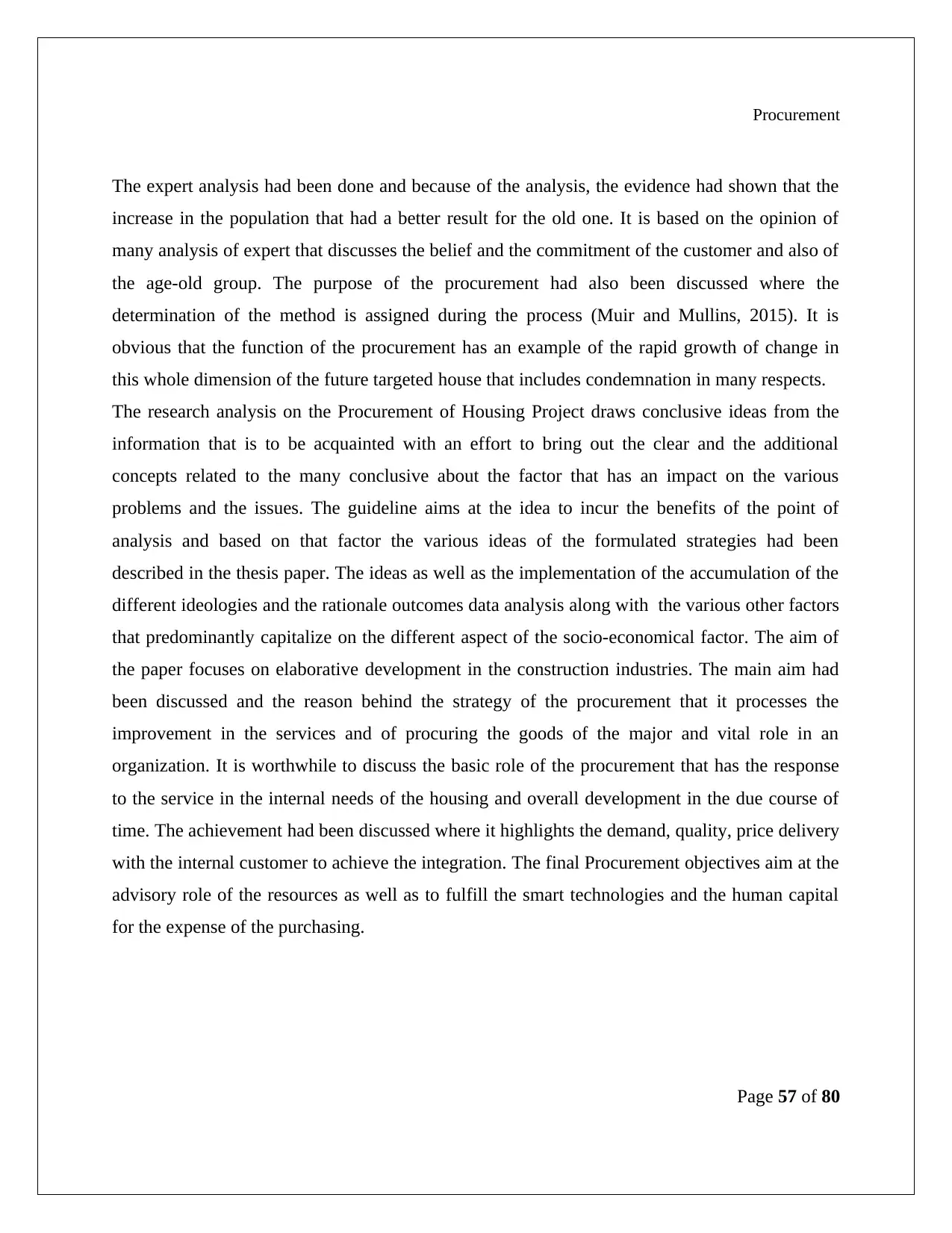
Procurement
The expert analysis had been done and because of the analysis, the evidence had shown that the
increase in the population that had a better result for the old one. It is based on the opinion of
many analysis of expert that discusses the belief and the commitment of the customer and also of
the age-old group. The purpose of the procurement had also been discussed where the
determination of the method is assigned during the process (Muir and Mullins, 2015). It is
obvious that the function of the procurement has an example of the rapid growth of change in
this whole dimension of the future targeted house that includes condemnation in many respects.
The research analysis on the Procurement of Housing Project draws conclusive ideas from the
information that is to be acquainted with an effort to bring out the clear and the additional
concepts related to the many conclusive about the factor that has an impact on the various
problems and the issues. The guideline aims at the idea to incur the benefits of the point of
analysis and based on that factor the various ideas of the formulated strategies had been
described in the thesis paper. The ideas as well as the implementation of the accumulation of the
different ideologies and the rationale outcomes data analysis along with the various other factors
that predominantly capitalize on the different aspect of the socio-economical factor. The aim of
the paper focuses on elaborative development in the construction industries. The main aim had
been discussed and the reason behind the strategy of the procurement that it processes the
improvement in the services and of procuring the goods of the major and vital role in an
organization. It is worthwhile to discuss the basic role of the procurement that has the response
to the service in the internal needs of the housing and overall development in the due course of
time. The achievement had been discussed where it highlights the demand, quality, price delivery
with the internal customer to achieve the integration. The final Procurement objectives aim at the
advisory role of the resources as well as to fulfill the smart technologies and the human capital
for the expense of the purchasing.
Page 57 of 80
The expert analysis had been done and because of the analysis, the evidence had shown that the
increase in the population that had a better result for the old one. It is based on the opinion of
many analysis of expert that discusses the belief and the commitment of the customer and also of
the age-old group. The purpose of the procurement had also been discussed where the
determination of the method is assigned during the process (Muir and Mullins, 2015). It is
obvious that the function of the procurement has an example of the rapid growth of change in
this whole dimension of the future targeted house that includes condemnation in many respects.
The research analysis on the Procurement of Housing Project draws conclusive ideas from the
information that is to be acquainted with an effort to bring out the clear and the additional
concepts related to the many conclusive about the factor that has an impact on the various
problems and the issues. The guideline aims at the idea to incur the benefits of the point of
analysis and based on that factor the various ideas of the formulated strategies had been
described in the thesis paper. The ideas as well as the implementation of the accumulation of the
different ideologies and the rationale outcomes data analysis along with the various other factors
that predominantly capitalize on the different aspect of the socio-economical factor. The aim of
the paper focuses on elaborative development in the construction industries. The main aim had
been discussed and the reason behind the strategy of the procurement that it processes the
improvement in the services and of procuring the goods of the major and vital role in an
organization. It is worthwhile to discuss the basic role of the procurement that has the response
to the service in the internal needs of the housing and overall development in the due course of
time. The achievement had been discussed where it highlights the demand, quality, price delivery
with the internal customer to achieve the integration. The final Procurement objectives aim at the
advisory role of the resources as well as to fulfill the smart technologies and the human capital
for the expense of the purchasing.
Page 57 of 80
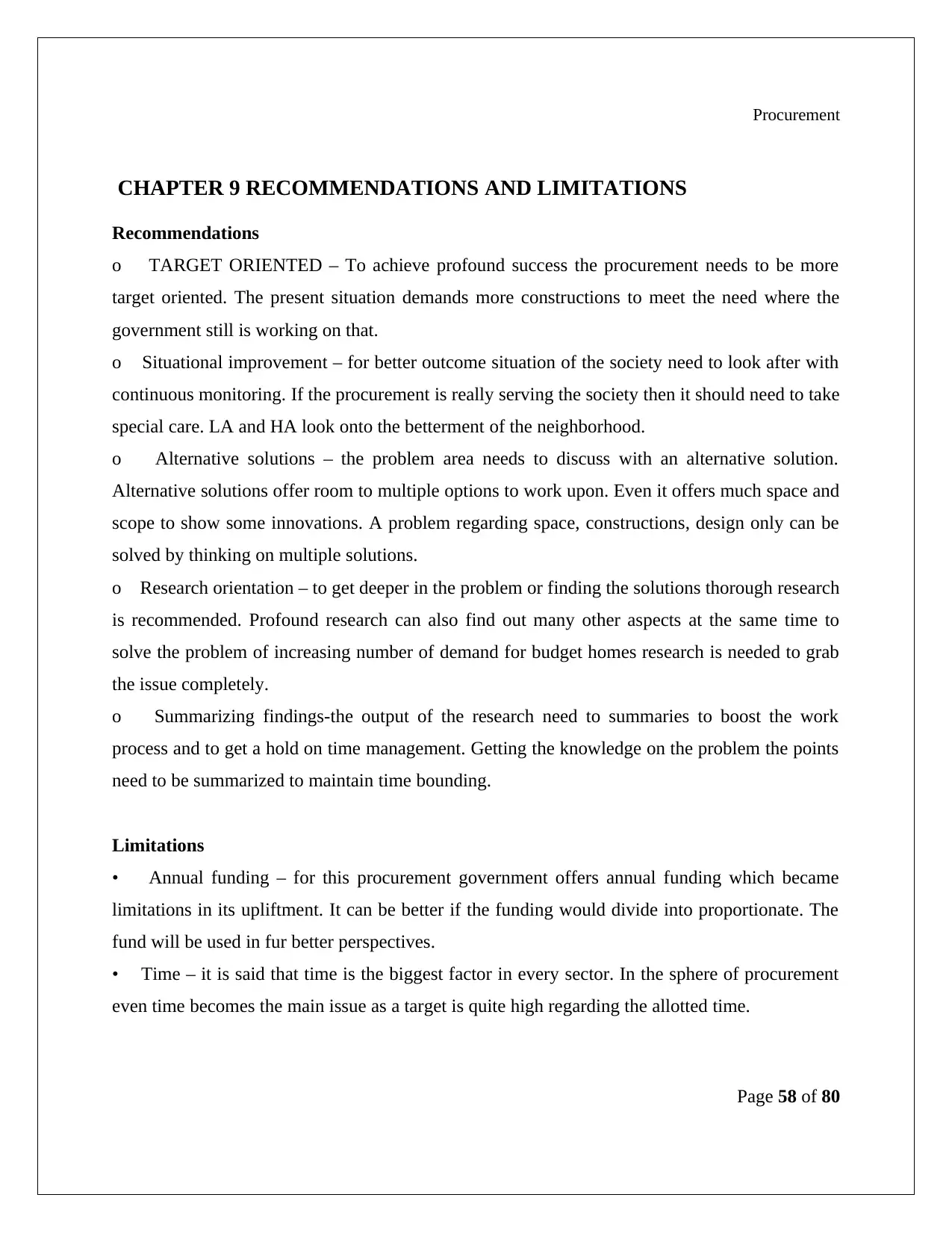
Procurement
CHAPTER 9 RECOMMENDATIONS AND LIMITATIONS
Recommendations
o TARGET ORIENTED – To achieve profound success the procurement needs to be more
target oriented. The present situation demands more constructions to meet the need where the
government still is working on that.
o Situational improvement – for better outcome situation of the society need to look after with
continuous monitoring. If the procurement is really serving the society then it should need to take
special care. LA and HA look onto the betterment of the neighborhood.
o Alternative solutions – the problem area needs to discuss with an alternative solution.
Alternative solutions offer room to multiple options to work upon. Even it offers much space and
scope to show some innovations. A problem regarding space, constructions, design only can be
solved by thinking on multiple solutions.
o Research orientation – to get deeper in the problem or finding the solutions thorough research
is recommended. Profound research can also find out many other aspects at the same time to
solve the problem of increasing number of demand for budget homes research is needed to grab
the issue completely.
o Summarizing findings-the output of the research need to summaries to boost the work
process and to get a hold on time management. Getting the knowledge on the problem the points
need to be summarized to maintain time bounding.
Limitations
• Annual funding – for this procurement government offers annual funding which became
limitations in its upliftment. It can be better if the funding would divide into proportionate. The
fund will be used in fur better perspectives.
• Time – it is said that time is the biggest factor in every sector. In the sphere of procurement
even time becomes the main issue as a target is quite high regarding the allotted time.
Page 58 of 80
CHAPTER 9 RECOMMENDATIONS AND LIMITATIONS
Recommendations
o TARGET ORIENTED – To achieve profound success the procurement needs to be more
target oriented. The present situation demands more constructions to meet the need where the
government still is working on that.
o Situational improvement – for better outcome situation of the society need to look after with
continuous monitoring. If the procurement is really serving the society then it should need to take
special care. LA and HA look onto the betterment of the neighborhood.
o Alternative solutions – the problem area needs to discuss with an alternative solution.
Alternative solutions offer room to multiple options to work upon. Even it offers much space and
scope to show some innovations. A problem regarding space, constructions, design only can be
solved by thinking on multiple solutions.
o Research orientation – to get deeper in the problem or finding the solutions thorough research
is recommended. Profound research can also find out many other aspects at the same time to
solve the problem of increasing number of demand for budget homes research is needed to grab
the issue completely.
o Summarizing findings-the output of the research need to summaries to boost the work
process and to get a hold on time management. Getting the knowledge on the problem the points
need to be summarized to maintain time bounding.
Limitations
• Annual funding – for this procurement government offers annual funding which became
limitations in its upliftment. It can be better if the funding would divide into proportionate. The
fund will be used in fur better perspectives.
• Time – it is said that time is the biggest factor in every sector. In the sphere of procurement
even time becomes the main issue as a target is quite high regarding the allotted time.
Page 58 of 80
Secure Best Marks with AI Grader
Need help grading? Try our AI Grader for instant feedback on your assignments.
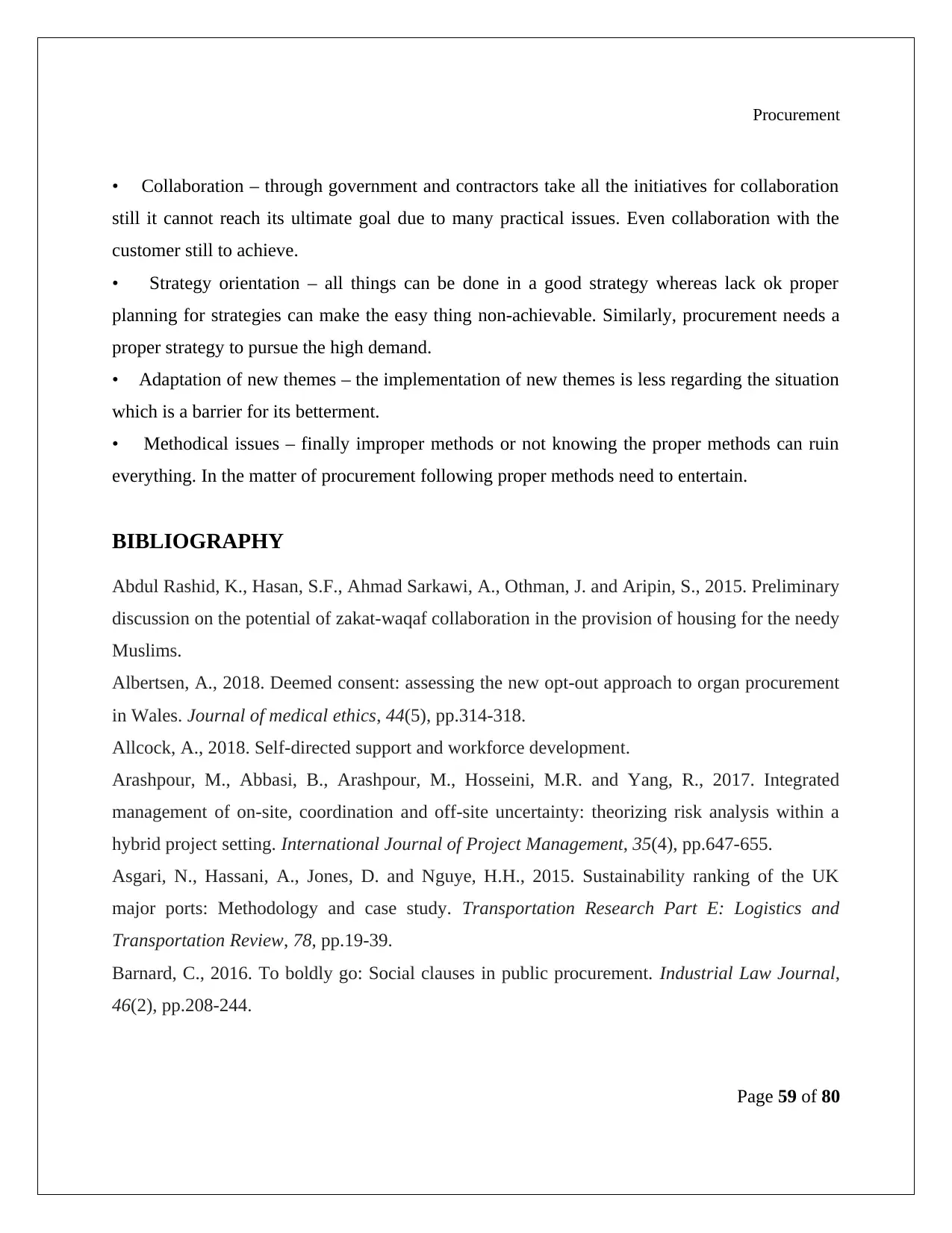
Procurement
• Collaboration – through government and contractors take all the initiatives for collaboration
still it cannot reach its ultimate goal due to many practical issues. Even collaboration with the
customer still to achieve.
• Strategy orientation – all things can be done in a good strategy whereas lack ok proper
planning for strategies can make the easy thing non-achievable. Similarly, procurement needs a
proper strategy to pursue the high demand.
• Adaptation of new themes – the implementation of new themes is less regarding the situation
which is a barrier for its betterment.
• Methodical issues – finally improper methods or not knowing the proper methods can ruin
everything. In the matter of procurement following proper methods need to entertain.
BIBLIOGRAPHY
Abdul Rashid, K., Hasan, S.F., Ahmad Sarkawi, A., Othman, J. and Aripin, S., 2015. Preliminary
discussion on the potential of zakat-waqaf collaboration in the provision of housing for the needy
Muslims.
Albertsen, A., 2018. Deemed consent: assessing the new opt-out approach to organ procurement
in Wales. Journal of medical ethics, 44(5), pp.314-318.
Allcock, A., 2018. Self-directed support and workforce development.
Arashpour, M., Abbasi, B., Arashpour, M., Hosseini, M.R. and Yang, R., 2017. Integrated
management of on-site, coordination and off-site uncertainty: theorizing risk analysis within a
hybrid project setting. International Journal of Project Management, 35(4), pp.647-655.
Asgari, N., Hassani, A., Jones, D. and Nguye, H.H., 2015. Sustainability ranking of the UK
major ports: Methodology and case study. Transportation Research Part E: Logistics and
Transportation Review, 78, pp.19-39.
Barnard, C., 2016. To boldly go: Social clauses in public procurement. Industrial Law Journal,
46(2), pp.208-244.
Page 59 of 80
• Collaboration – through government and contractors take all the initiatives for collaboration
still it cannot reach its ultimate goal due to many practical issues. Even collaboration with the
customer still to achieve.
• Strategy orientation – all things can be done in a good strategy whereas lack ok proper
planning for strategies can make the easy thing non-achievable. Similarly, procurement needs a
proper strategy to pursue the high demand.
• Adaptation of new themes – the implementation of new themes is less regarding the situation
which is a barrier for its betterment.
• Methodical issues – finally improper methods or not knowing the proper methods can ruin
everything. In the matter of procurement following proper methods need to entertain.
BIBLIOGRAPHY
Abdul Rashid, K., Hasan, S.F., Ahmad Sarkawi, A., Othman, J. and Aripin, S., 2015. Preliminary
discussion on the potential of zakat-waqaf collaboration in the provision of housing for the needy
Muslims.
Albertsen, A., 2018. Deemed consent: assessing the new opt-out approach to organ procurement
in Wales. Journal of medical ethics, 44(5), pp.314-318.
Allcock, A., 2018. Self-directed support and workforce development.
Arashpour, M., Abbasi, B., Arashpour, M., Hosseini, M.R. and Yang, R., 2017. Integrated
management of on-site, coordination and off-site uncertainty: theorizing risk analysis within a
hybrid project setting. International Journal of Project Management, 35(4), pp.647-655.
Asgari, N., Hassani, A., Jones, D. and Nguye, H.H., 2015. Sustainability ranking of the UK
major ports: Methodology and case study. Transportation Research Part E: Logistics and
Transportation Review, 78, pp.19-39.
Barnard, C., 2016. To boldly go: Social clauses in public procurement. Industrial Law Journal,
46(2), pp.208-244.
Page 59 of 80
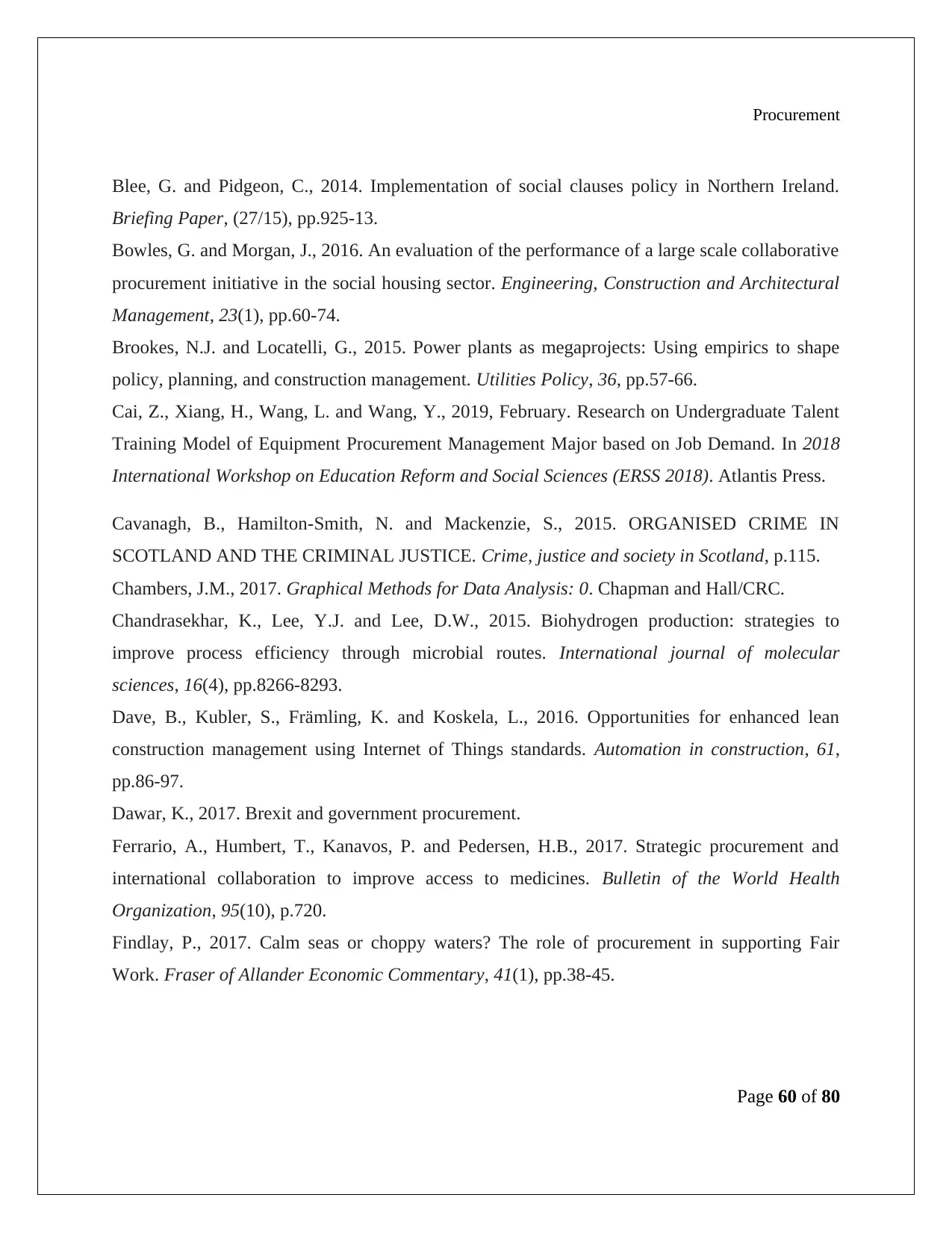
Procurement
Blee, G. and Pidgeon, C., 2014. Implementation of social clauses policy in Northern Ireland.
Briefing Paper, (27/15), pp.925-13.
Bowles, G. and Morgan, J., 2016. An evaluation of the performance of a large scale collaborative
procurement initiative in the social housing sector. Engineering, Construction and Architectural
Management, 23(1), pp.60-74.
Brookes, N.J. and Locatelli, G., 2015. Power plants as megaprojects: Using empirics to shape
policy, planning, and construction management. Utilities Policy, 36, pp.57-66.
Cai, Z., Xiang, H., Wang, L. and Wang, Y., 2019, February. Research on Undergraduate Talent
Training Model of Equipment Procurement Management Major based on Job Demand. In 2018
International Workshop on Education Reform and Social Sciences (ERSS 2018). Atlantis Press.
Cavanagh, B., Hamilton-Smith, N. and Mackenzie, S., 2015. ORGANISED CRIME IN
SCOTLAND AND THE CRIMINAL JUSTICE. Crime, justice and society in Scotland, p.115.
Chambers, J.M., 2017. Graphical Methods for Data Analysis: 0. Chapman and Hall/CRC.
Chandrasekhar, K., Lee, Y.J. and Lee, D.W., 2015. Biohydrogen production: strategies to
improve process efficiency through microbial routes. International journal of molecular
sciences, 16(4), pp.8266-8293.
Dave, B., Kubler, S., Främling, K. and Koskela, L., 2016. Opportunities for enhanced lean
construction management using Internet of Things standards. Automation in construction, 61,
pp.86-97.
Dawar, K., 2017. Brexit and government procurement.
Ferrario, A., Humbert, T., Kanavos, P. and Pedersen, H.B., 2017. Strategic procurement and
international collaboration to improve access to medicines. Bulletin of the World Health
Organization, 95(10), p.720.
Findlay, P., 2017. Calm seas or choppy waters? The role of procurement in supporting Fair
Work. Fraser of Allander Economic Commentary, 41(1), pp.38-45.
Page 60 of 80
Blee, G. and Pidgeon, C., 2014. Implementation of social clauses policy in Northern Ireland.
Briefing Paper, (27/15), pp.925-13.
Bowles, G. and Morgan, J., 2016. An evaluation of the performance of a large scale collaborative
procurement initiative in the social housing sector. Engineering, Construction and Architectural
Management, 23(1), pp.60-74.
Brookes, N.J. and Locatelli, G., 2015. Power plants as megaprojects: Using empirics to shape
policy, planning, and construction management. Utilities Policy, 36, pp.57-66.
Cai, Z., Xiang, H., Wang, L. and Wang, Y., 2019, February. Research on Undergraduate Talent
Training Model of Equipment Procurement Management Major based on Job Demand. In 2018
International Workshop on Education Reform and Social Sciences (ERSS 2018). Atlantis Press.
Cavanagh, B., Hamilton-Smith, N. and Mackenzie, S., 2015. ORGANISED CRIME IN
SCOTLAND AND THE CRIMINAL JUSTICE. Crime, justice and society in Scotland, p.115.
Chambers, J.M., 2017. Graphical Methods for Data Analysis: 0. Chapman and Hall/CRC.
Chandrasekhar, K., Lee, Y.J. and Lee, D.W., 2015. Biohydrogen production: strategies to
improve process efficiency through microbial routes. International journal of molecular
sciences, 16(4), pp.8266-8293.
Dave, B., Kubler, S., Främling, K. and Koskela, L., 2016. Opportunities for enhanced lean
construction management using Internet of Things standards. Automation in construction, 61,
pp.86-97.
Dawar, K., 2017. Brexit and government procurement.
Ferrario, A., Humbert, T., Kanavos, P. and Pedersen, H.B., 2017. Strategic procurement and
international collaboration to improve access to medicines. Bulletin of the World Health
Organization, 95(10), p.720.
Findlay, P., 2017. Calm seas or choppy waters? The role of procurement in supporting Fair
Work. Fraser of Allander Economic Commentary, 41(1), pp.38-45.
Page 60 of 80

Procurement
Ganah, A. and John, G.A., 2015. Integrating building information modeling and health and
safety for onsite construction. Safety and health at work, 6(1), pp.39-45.
Gbadegesin, J.T., Van der Heijden, H. and Boelhouwer, P., 2016. Land Accessibility Factors in
Urban Housing Provision in Nigeria Cities: Case of Lagos. Land Market and Housing Policy, 1.
Githinji, R.M. and Were, S., 2018. Challenges of Implementing E-Procurement in the Ministry
of Transport, Infrastructure, Housing and Urban Development in Nairobi, Kenya. Journal of
procurement & Supply Chain, 2(1), pp.1-13.
Gurran, N. and Bramley, G., 2017. Planning, Housing Supply and Affordable Provision in
Britain. In Urban Planning and the Housing Market (pp. 123-163). Palgrave Macmillan,
London.
Heagney, J., 2016. Fundamentals of project management. Amacom.
Jalil, A.A., Nuruddin, A.R., Jaafar, M. and Mydin, M.A., 2015. O.: A New Procurement Method
for Housing Projects Implementing IBS Modular System. In Proceedings of International
Conference on Advances in Civil and Environmental Engineering (pp. 1-8).
Jalil, A.A., Nuruddin, A.R., Jaafar, M. and Mydin, M.A., 2015. O.: A New Procurement Method
for Housing Projects Implementing IBS Modular System. In Proceedings of International
Conference on Advances in Civil and Environmental Engineering (pp. 1-8).
King, F., 2015. Scotland: Delivering a Right to Housing. JL & Soc. Pol'y, 24, p.i.
Laird, Y., McAteer, J., Myers, F. and Reid, G., 2017. Tobacco control policy in Scotland: A
qualitative study of expert views on successes, challenges and future actions.
Lucian, M. and Fiori, L., 2017. Hydrothermal carbonization of waste biomass: Process design,
modeling, energy efficiency and cost analysis. Energies, 10(2), p.211.
Mahamadu, A.M., Manu, P., Booth, C., Olomolaiye, P., Coker, A., Ibrahim, A. and Lamond, J.,
2018. Infrastructure procurement skills gap amongst procurement personnel in Nigeria’s public
sector. Journal of Engineering, Design and Technology, 16(1), pp.2-24.
Page 61 of 80
Ganah, A. and John, G.A., 2015. Integrating building information modeling and health and
safety for onsite construction. Safety and health at work, 6(1), pp.39-45.
Gbadegesin, J.T., Van der Heijden, H. and Boelhouwer, P., 2016. Land Accessibility Factors in
Urban Housing Provision in Nigeria Cities: Case of Lagos. Land Market and Housing Policy, 1.
Githinji, R.M. and Were, S., 2018. Challenges of Implementing E-Procurement in the Ministry
of Transport, Infrastructure, Housing and Urban Development in Nairobi, Kenya. Journal of
procurement & Supply Chain, 2(1), pp.1-13.
Gurran, N. and Bramley, G., 2017. Planning, Housing Supply and Affordable Provision in
Britain. In Urban Planning and the Housing Market (pp. 123-163). Palgrave Macmillan,
London.
Heagney, J., 2016. Fundamentals of project management. Amacom.
Jalil, A.A., Nuruddin, A.R., Jaafar, M. and Mydin, M.A., 2015. O.: A New Procurement Method
for Housing Projects Implementing IBS Modular System. In Proceedings of International
Conference on Advances in Civil and Environmental Engineering (pp. 1-8).
Jalil, A.A., Nuruddin, A.R., Jaafar, M. and Mydin, M.A., 2015. O.: A New Procurement Method
for Housing Projects Implementing IBS Modular System. In Proceedings of International
Conference on Advances in Civil and Environmental Engineering (pp. 1-8).
King, F., 2015. Scotland: Delivering a Right to Housing. JL & Soc. Pol'y, 24, p.i.
Laird, Y., McAteer, J., Myers, F. and Reid, G., 2017. Tobacco control policy in Scotland: A
qualitative study of expert views on successes, challenges and future actions.
Lucian, M. and Fiori, L., 2017. Hydrothermal carbonization of waste biomass: Process design,
modeling, energy efficiency and cost analysis. Energies, 10(2), p.211.
Mahamadu, A.M., Manu, P., Booth, C., Olomolaiye, P., Coker, A., Ibrahim, A. and Lamond, J.,
2018. Infrastructure procurement skills gap amongst procurement personnel in Nigeria’s public
sector. Journal of Engineering, Design and Technology, 16(1), pp.2-24.
Page 61 of 80
Paraphrase This Document
Need a fresh take? Get an instant paraphrase of this document with our AI Paraphraser
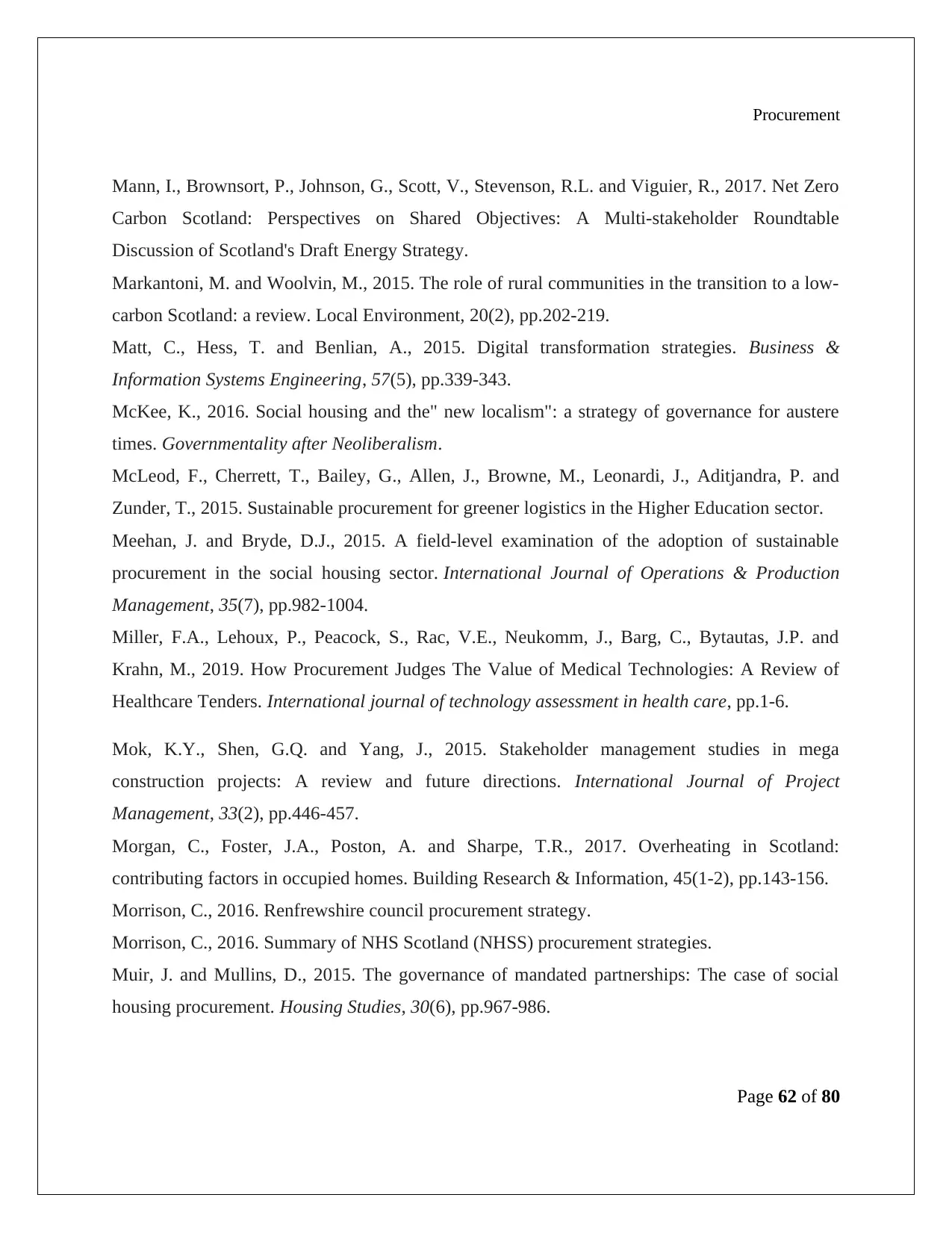
Procurement
Mann, I., Brownsort, P., Johnson, G., Scott, V., Stevenson, R.L. and Viguier, R., 2017. Net Zero
Carbon Scotland: Perspectives on Shared Objectives: A Multi-stakeholder Roundtable
Discussion of Scotland's Draft Energy Strategy.
Markantoni, M. and Woolvin, M., 2015. The role of rural communities in the transition to a low-
carbon Scotland: a review. Local Environment, 20(2), pp.202-219.
Matt, C., Hess, T. and Benlian, A., 2015. Digital transformation strategies. Business &
Information Systems Engineering, 57(5), pp.339-343.
McKee, K., 2016. Social housing and the" new localism": a strategy of governance for austere
times. Governmentality after Neoliberalism.
McLeod, F., Cherrett, T., Bailey, G., Allen, J., Browne, M., Leonardi, J., Aditjandra, P. and
Zunder, T., 2015. Sustainable procurement for greener logistics in the Higher Education sector.
Meehan, J. and Bryde, D.J., 2015. A field-level examination of the adoption of sustainable
procurement in the social housing sector. International Journal of Operations & Production
Management, 35(7), pp.982-1004.
Miller, F.A., Lehoux, P., Peacock, S., Rac, V.E., Neukomm, J., Barg, C., Bytautas, J.P. and
Krahn, M., 2019. How Procurement Judges The Value of Medical Technologies: A Review of
Healthcare Tenders. International journal of technology assessment in health care, pp.1-6.
Mok, K.Y., Shen, G.Q. and Yang, J., 2015. Stakeholder management studies in mega
construction projects: A review and future directions. International Journal of Project
Management, 33(2), pp.446-457.
Morgan, C., Foster, J.A., Poston, A. and Sharpe, T.R., 2017. Overheating in Scotland:
contributing factors in occupied homes. Building Research & Information, 45(1-2), pp.143-156.
Morrison, C., 2016. Renfrewshire council procurement strategy.
Morrison, C., 2016. Summary of NHS Scotland (NHSS) procurement strategies.
Muir, J. and Mullins, D., 2015. The governance of mandated partnerships: The case of social
housing procurement. Housing Studies, 30(6), pp.967-986.
Page 62 of 80
Mann, I., Brownsort, P., Johnson, G., Scott, V., Stevenson, R.L. and Viguier, R., 2017. Net Zero
Carbon Scotland: Perspectives on Shared Objectives: A Multi-stakeholder Roundtable
Discussion of Scotland's Draft Energy Strategy.
Markantoni, M. and Woolvin, M., 2015. The role of rural communities in the transition to a low-
carbon Scotland: a review. Local Environment, 20(2), pp.202-219.
Matt, C., Hess, T. and Benlian, A., 2015. Digital transformation strategies. Business &
Information Systems Engineering, 57(5), pp.339-343.
McKee, K., 2016. Social housing and the" new localism": a strategy of governance for austere
times. Governmentality after Neoliberalism.
McLeod, F., Cherrett, T., Bailey, G., Allen, J., Browne, M., Leonardi, J., Aditjandra, P. and
Zunder, T., 2015. Sustainable procurement for greener logistics in the Higher Education sector.
Meehan, J. and Bryde, D.J., 2015. A field-level examination of the adoption of sustainable
procurement in the social housing sector. International Journal of Operations & Production
Management, 35(7), pp.982-1004.
Miller, F.A., Lehoux, P., Peacock, S., Rac, V.E., Neukomm, J., Barg, C., Bytautas, J.P. and
Krahn, M., 2019. How Procurement Judges The Value of Medical Technologies: A Review of
Healthcare Tenders. International journal of technology assessment in health care, pp.1-6.
Mok, K.Y., Shen, G.Q. and Yang, J., 2015. Stakeholder management studies in mega
construction projects: A review and future directions. International Journal of Project
Management, 33(2), pp.446-457.
Morgan, C., Foster, J.A., Poston, A. and Sharpe, T.R., 2017. Overheating in Scotland:
contributing factors in occupied homes. Building Research & Information, 45(1-2), pp.143-156.
Morrison, C., 2016. Renfrewshire council procurement strategy.
Morrison, C., 2016. Summary of NHS Scotland (NHSS) procurement strategies.
Muir, J. and Mullins, D., 2015. The governance of mandated partnerships: The case of social
housing procurement. Housing Studies, 30(6), pp.967-986.
Page 62 of 80
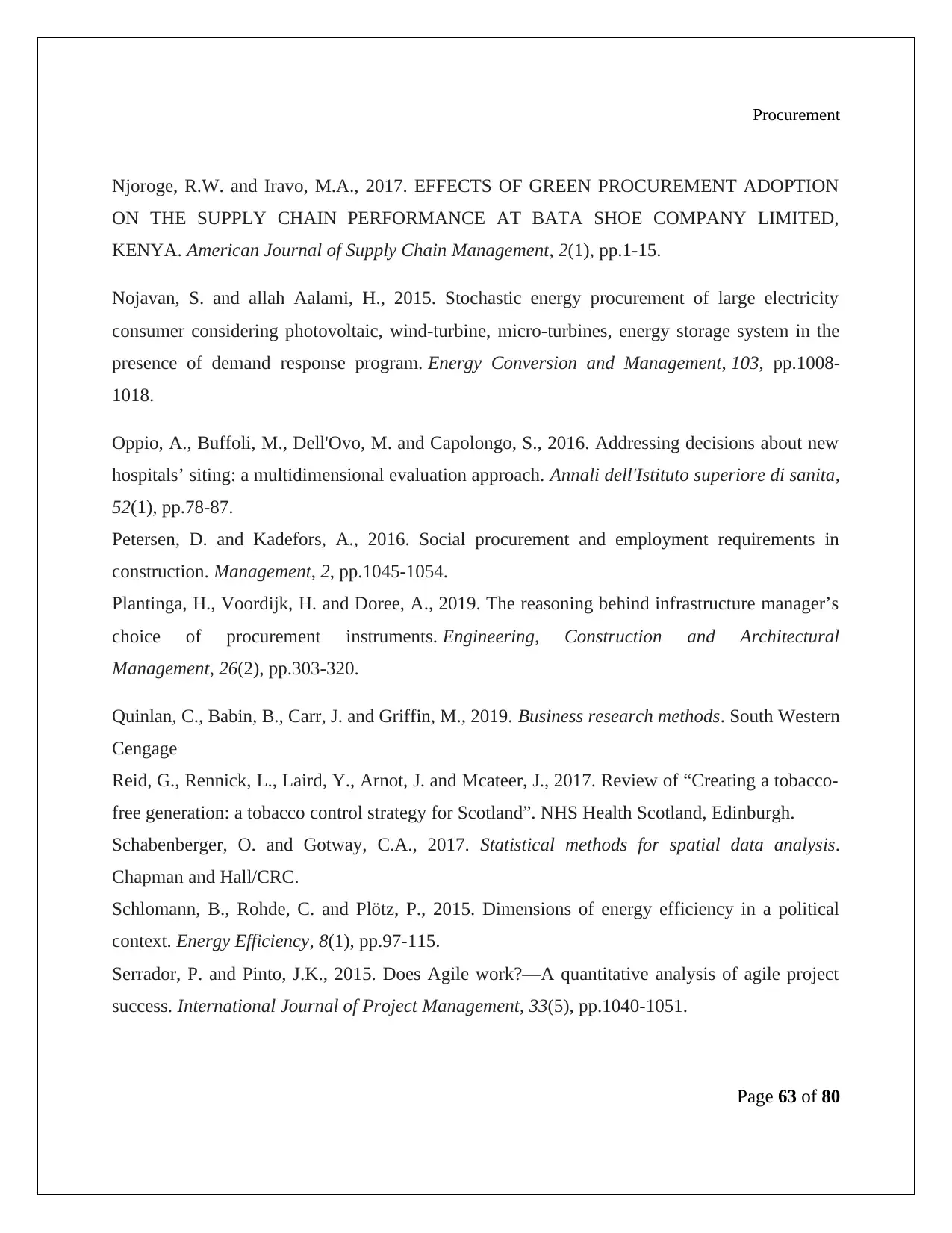
Procurement
Njoroge, R.W. and Iravo, M.A., 2017. EFFECTS OF GREEN PROCUREMENT ADOPTION
ON THE SUPPLY CHAIN PERFORMANCE AT BATA SHOE COMPANY LIMITED,
KENYA. American Journal of Supply Chain Management, 2(1), pp.1-15.
Nojavan, S. and allah Aalami, H., 2015. Stochastic energy procurement of large electricity
consumer considering photovoltaic, wind-turbine, micro-turbines, energy storage system in the
presence of demand response program. Energy Conversion and Management, 103, pp.1008-
1018.
Oppio, A., Buffoli, M., Dell'Ovo, M. and Capolongo, S., 2016. Addressing decisions about new
hospitals’ siting: a multidimensional evaluation approach. Annali dell'Istituto superiore di sanita,
52(1), pp.78-87.
Petersen, D. and Kadefors, A., 2016. Social procurement and employment requirements in
construction. Management, 2, pp.1045-1054.
Plantinga, H., Voordijk, H. and Doree, A., 2019. The reasoning behind infrastructure manager’s
choice of procurement instruments. Engineering, Construction and Architectural
Management, 26(2), pp.303-320.
Quinlan, C., Babin, B., Carr, J. and Griffin, M., 2019. Business research methods. South Western
Cengage
Reid, G., Rennick, L., Laird, Y., Arnot, J. and Mcateer, J., 2017. Review of “Creating a tobacco-
free generation: a tobacco control strategy for Scotland”. NHS Health Scotland, Edinburgh.
Schabenberger, O. and Gotway, C.A., 2017. Statistical methods for spatial data analysis.
Chapman and Hall/CRC.
Schlomann, B., Rohde, C. and Plötz, P., 2015. Dimensions of energy efficiency in a political
context. Energy Efficiency, 8(1), pp.97-115.
Serrador, P. and Pinto, J.K., 2015. Does Agile work?—A quantitative analysis of agile project
success. International Journal of Project Management, 33(5), pp.1040-1051.
Page 63 of 80
Njoroge, R.W. and Iravo, M.A., 2017. EFFECTS OF GREEN PROCUREMENT ADOPTION
ON THE SUPPLY CHAIN PERFORMANCE AT BATA SHOE COMPANY LIMITED,
KENYA. American Journal of Supply Chain Management, 2(1), pp.1-15.
Nojavan, S. and allah Aalami, H., 2015. Stochastic energy procurement of large electricity
consumer considering photovoltaic, wind-turbine, micro-turbines, energy storage system in the
presence of demand response program. Energy Conversion and Management, 103, pp.1008-
1018.
Oppio, A., Buffoli, M., Dell'Ovo, M. and Capolongo, S., 2016. Addressing decisions about new
hospitals’ siting: a multidimensional evaluation approach. Annali dell'Istituto superiore di sanita,
52(1), pp.78-87.
Petersen, D. and Kadefors, A., 2016. Social procurement and employment requirements in
construction. Management, 2, pp.1045-1054.
Plantinga, H., Voordijk, H. and Doree, A., 2019. The reasoning behind infrastructure manager’s
choice of procurement instruments. Engineering, Construction and Architectural
Management, 26(2), pp.303-320.
Quinlan, C., Babin, B., Carr, J. and Griffin, M., 2019. Business research methods. South Western
Cengage
Reid, G., Rennick, L., Laird, Y., Arnot, J. and Mcateer, J., 2017. Review of “Creating a tobacco-
free generation: a tobacco control strategy for Scotland”. NHS Health Scotland, Edinburgh.
Schabenberger, O. and Gotway, C.A., 2017. Statistical methods for spatial data analysis.
Chapman and Hall/CRC.
Schlomann, B., Rohde, C. and Plötz, P., 2015. Dimensions of energy efficiency in a political
context. Energy Efficiency, 8(1), pp.97-115.
Serrador, P. and Pinto, J.K., 2015. Does Agile work?—A quantitative analysis of agile project
success. International Journal of Project Management, 33(5), pp.1040-1051.
Page 63 of 80
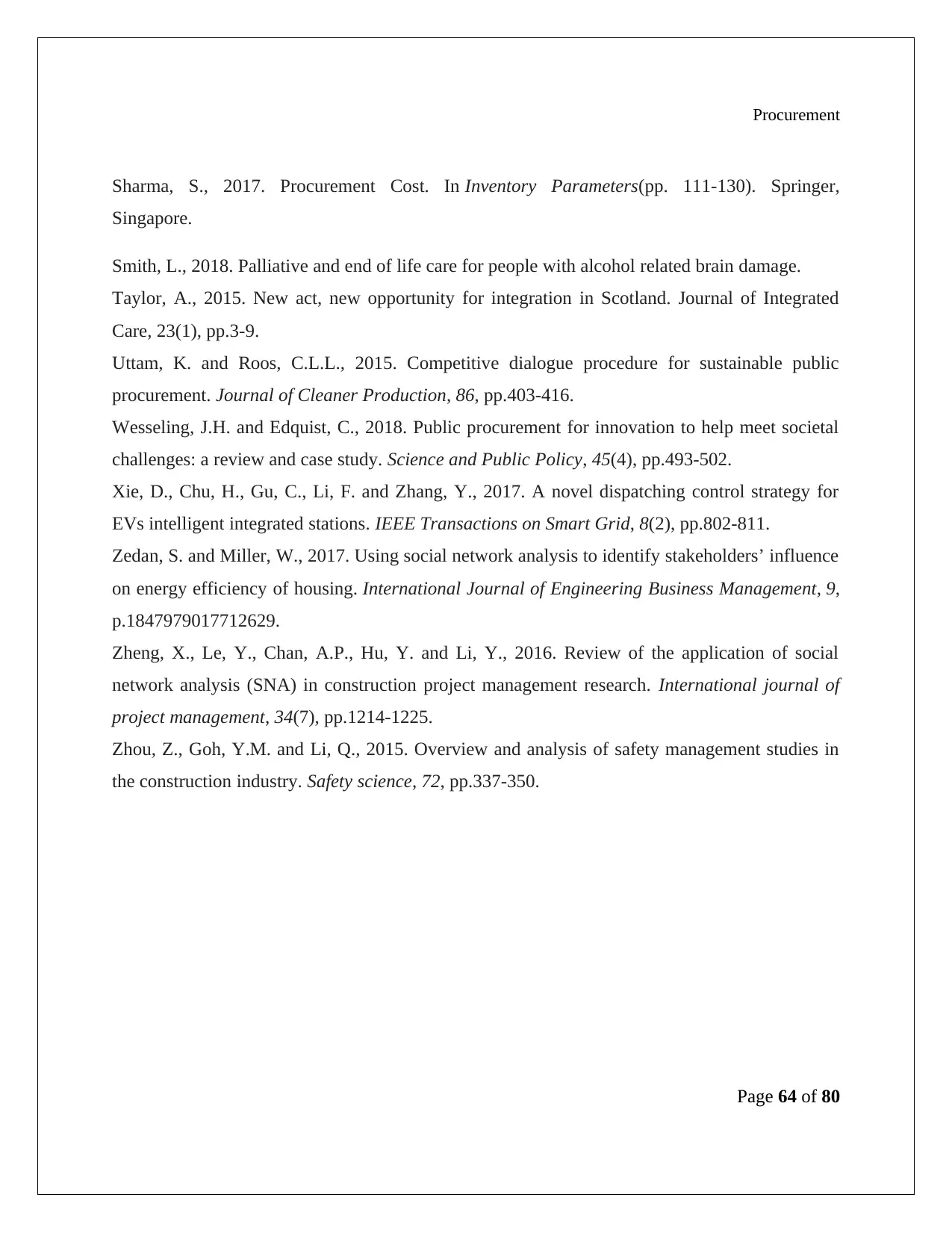
Procurement
Sharma, S., 2017. Procurement Cost. In Inventory Parameters(pp. 111-130). Springer,
Singapore.
Smith, L., 2018. Palliative and end of life care for people with alcohol related brain damage.
Taylor, A., 2015. New act, new opportunity for integration in Scotland. Journal of Integrated
Care, 23(1), pp.3-9.
Uttam, K. and Roos, C.L.L., 2015. Competitive dialogue procedure for sustainable public
procurement. Journal of Cleaner Production, 86, pp.403-416.
Wesseling, J.H. and Edquist, C., 2018. Public procurement for innovation to help meet societal
challenges: a review and case study. Science and Public Policy, 45(4), pp.493-502.
Xie, D., Chu, H., Gu, C., Li, F. and Zhang, Y., 2017. A novel dispatching control strategy for
EVs intelligent integrated stations. IEEE Transactions on Smart Grid, 8(2), pp.802-811.
Zedan, S. and Miller, W., 2017. Using social network analysis to identify stakeholders’ influence
on energy efficiency of housing. International Journal of Engineering Business Management, 9,
p.1847979017712629.
Zheng, X., Le, Y., Chan, A.P., Hu, Y. and Li, Y., 2016. Review of the application of social
network analysis (SNA) in construction project management research. International journal of
project management, 34(7), pp.1214-1225.
Zhou, Z., Goh, Y.M. and Li, Q., 2015. Overview and analysis of safety management studies in
the construction industry. Safety science, 72, pp.337-350.
Page 64 of 80
Sharma, S., 2017. Procurement Cost. In Inventory Parameters(pp. 111-130). Springer,
Singapore.
Smith, L., 2018. Palliative and end of life care for people with alcohol related brain damage.
Taylor, A., 2015. New act, new opportunity for integration in Scotland. Journal of Integrated
Care, 23(1), pp.3-9.
Uttam, K. and Roos, C.L.L., 2015. Competitive dialogue procedure for sustainable public
procurement. Journal of Cleaner Production, 86, pp.403-416.
Wesseling, J.H. and Edquist, C., 2018. Public procurement for innovation to help meet societal
challenges: a review and case study. Science and Public Policy, 45(4), pp.493-502.
Xie, D., Chu, H., Gu, C., Li, F. and Zhang, Y., 2017. A novel dispatching control strategy for
EVs intelligent integrated stations. IEEE Transactions on Smart Grid, 8(2), pp.802-811.
Zedan, S. and Miller, W., 2017. Using social network analysis to identify stakeholders’ influence
on energy efficiency of housing. International Journal of Engineering Business Management, 9,
p.1847979017712629.
Zheng, X., Le, Y., Chan, A.P., Hu, Y. and Li, Y., 2016. Review of the application of social
network analysis (SNA) in construction project management research. International journal of
project management, 34(7), pp.1214-1225.
Zhou, Z., Goh, Y.M. and Li, Q., 2015. Overview and analysis of safety management studies in
the construction industry. Safety science, 72, pp.337-350.
Page 64 of 80
Secure Best Marks with AI Grader
Need help grading? Try our AI Grader for instant feedback on your assignments.
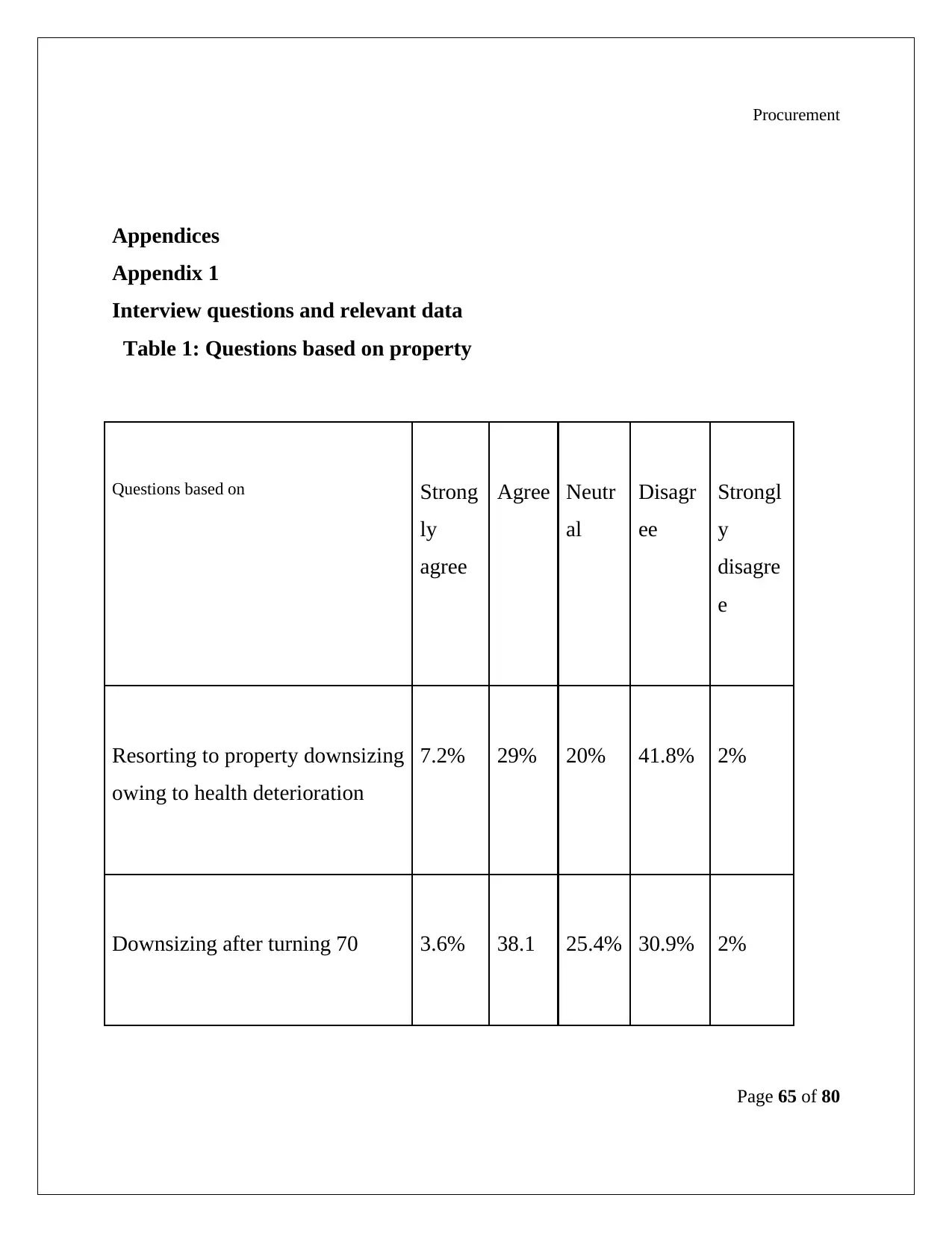
Procurement
Appendices
Appendix 1
Interview questions and relevant data
Table 1: Questions based on property
Questions based on Strong
ly
agree
Agree Neutr
al
Disagr
ee
Strongl
y
disagre
e
Resorting to property downsizing
owing to health deterioration
7.2% 29% 20% 41.8% 2%
Downsizing after turning 70 3.6% 38.1 25.4% 30.9% 2%
Page 65 of 80
Appendices
Appendix 1
Interview questions and relevant data
Table 1: Questions based on property
Questions based on Strong
ly
agree
Agree Neutr
al
Disagr
ee
Strongl
y
disagre
e
Resorting to property downsizing
owing to health deterioration
7.2% 29% 20% 41.8% 2%
Downsizing after turning 70 3.6% 38.1 25.4% 30.9% 2%
Page 65 of 80

Procurement
%
Emotional upheaval affecting
downsizing
18.1% 50.9
%
20% 10.9% 0%
Cleanliness is appealing 9% 41.9
%
16.4% 29.1% 3.6%
No downsizing unless forced due
to health issues
16.4% 38.1
%
12.7% 21.9% 10.9%
Downsize now and enjoy 16% 40.9 29.1% 14% 0%
Page 66 of 80
%
Emotional upheaval affecting
downsizing
18.1% 50.9
%
20% 10.9% 0%
Cleanliness is appealing 9% 41.9
%
16.4% 29.1% 3.6%
No downsizing unless forced due
to health issues
16.4% 38.1
%
12.7% 21.9% 10.9%
Downsize now and enjoy 16% 40.9 29.1% 14% 0%
Page 66 of 80
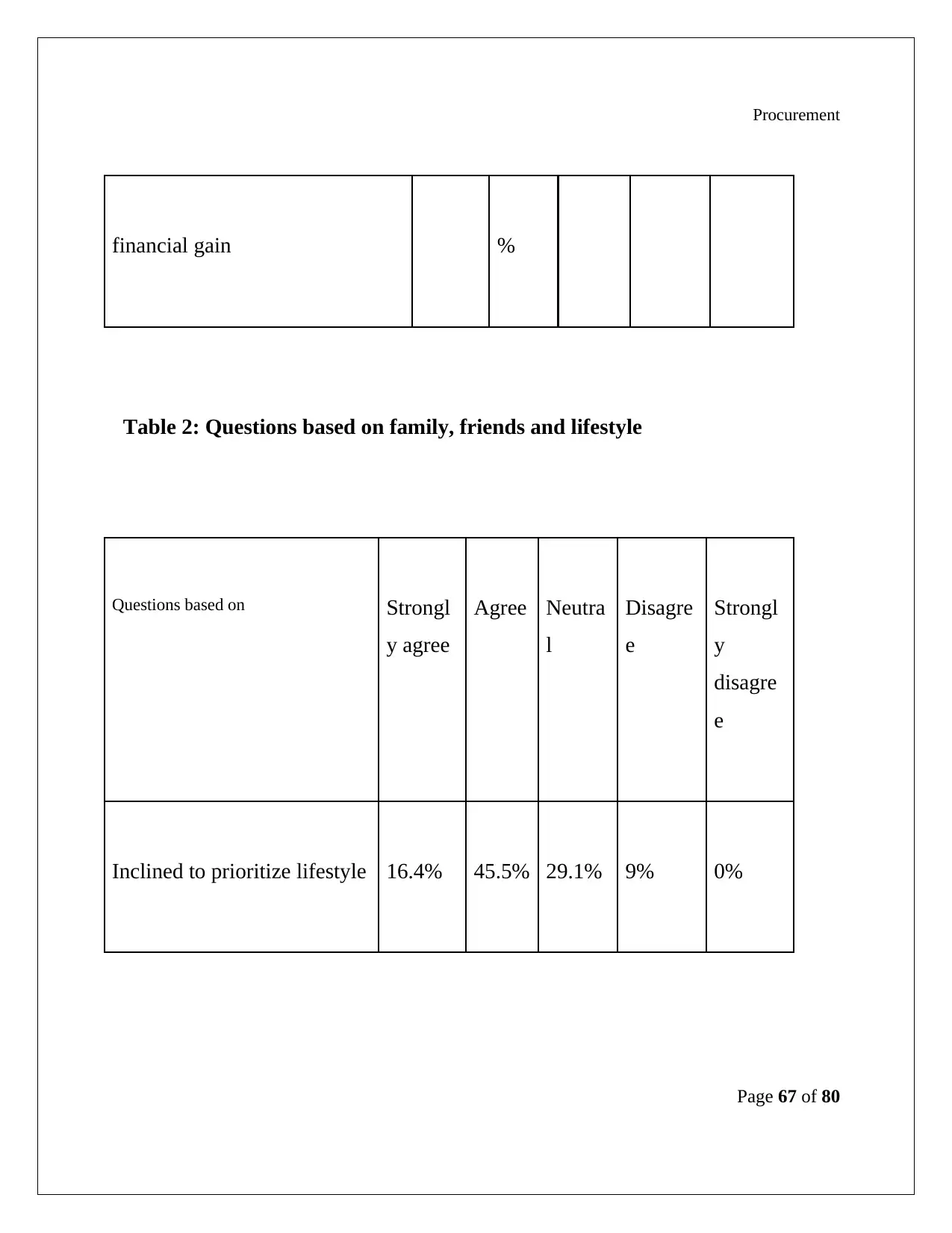
Procurement
financial gain %
Table 2: Questions based on family, friends and lifestyle
Questions based on Strongl
y agree
Agree Neutra
l
Disagre
e
Strongl
y
disagre
e
Inclined to prioritize lifestyle 16.4% 45.5% 29.1% 9% 0%
Page 67 of 80
financial gain %
Table 2: Questions based on family, friends and lifestyle
Questions based on Strongl
y agree
Agree Neutra
l
Disagre
e
Strongl
y
disagre
e
Inclined to prioritize lifestyle 16.4% 45.5% 29.1% 9% 0%
Page 67 of 80
Paraphrase This Document
Need a fresh take? Get an instant paraphrase of this document with our AI Paraphraser
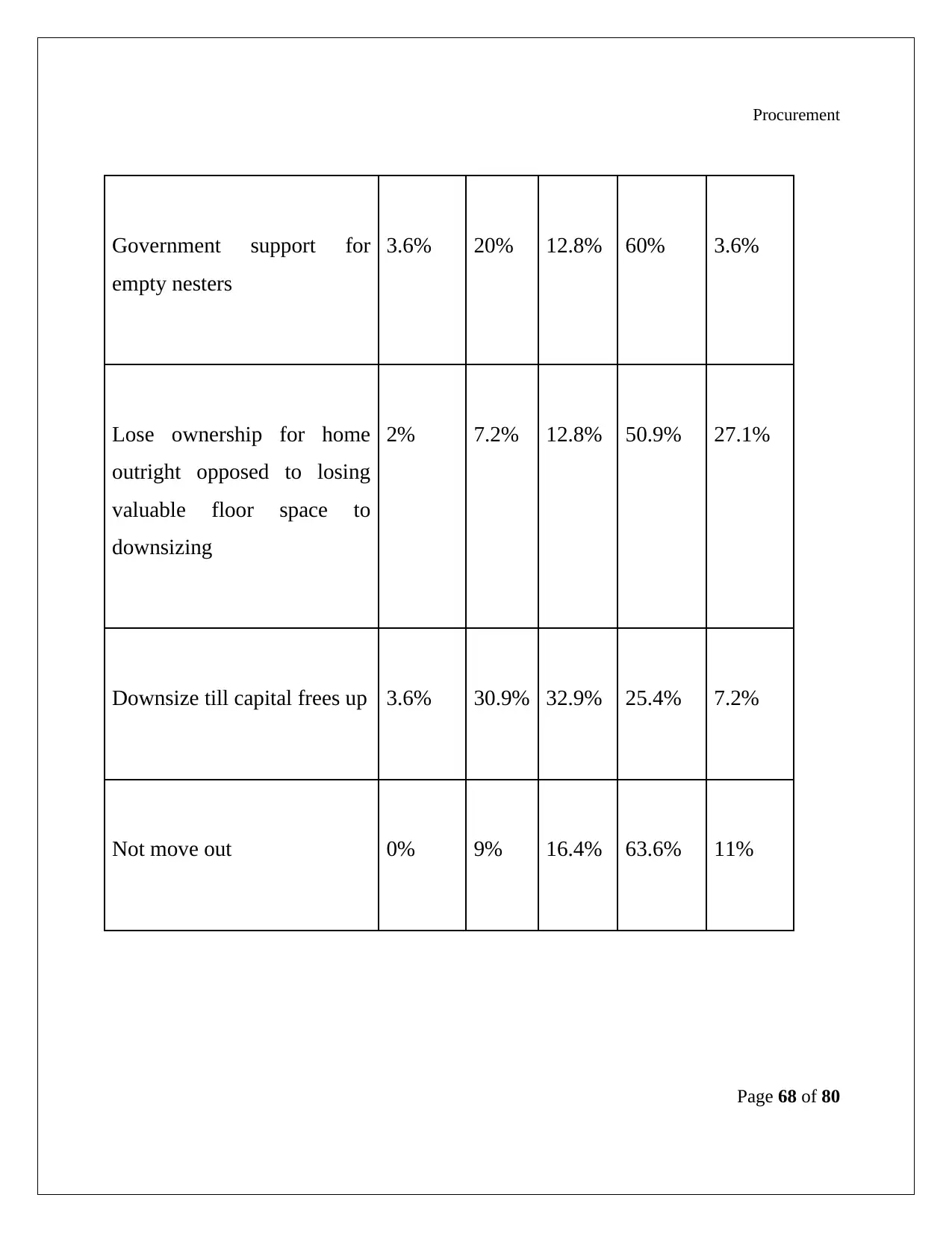
Procurement
Government support for
empty nesters
3.6% 20% 12.8% 60% 3.6%
Lose ownership for home
outright opposed to losing
valuable floor space to
downsizing
2% 7.2% 12.8% 50.9% 27.1%
Downsize till capital frees up 3.6% 30.9% 32.9% 25.4% 7.2%
Not move out 0% 9% 16.4% 63.6% 11%
Page 68 of 80
Government support for
empty nesters
3.6% 20% 12.8% 60% 3.6%
Lose ownership for home
outright opposed to losing
valuable floor space to
downsizing
2% 7.2% 12.8% 50.9% 27.1%
Downsize till capital frees up 3.6% 30.9% 32.9% 25.4% 7.2%
Not move out 0% 9% 16.4% 63.6% 11%
Page 68 of 80

Procurement
House has greater priority
over anything
3.6% 11% 9% 58.2% 18.2%
Questions based on Strongl
y agree
Agree Neutra
l
Disagre
e
Strongl
y
disagre
e
Prioritize space for children 11% 30.9% 27% 29.1% 2%
Downsize after retirement 5.5% 20% 34.5% 36.4% 3.6%
Page 69 of 80
House has greater priority
over anything
3.6% 11% 9% 58.2% 18.2%
Questions based on Strongl
y agree
Agree Neutra
l
Disagre
e
Strongl
y
disagre
e
Prioritize space for children 11% 30.9% 27% 29.1% 2%
Downsize after retirement 5.5% 20% 34.5% 36.4% 3.6%
Page 69 of 80

Procurement
Maintain inheritance with
children
3.7% 20.4% 16.6% 51.9% 7.4%
Focus only on personal needs
rather than inheritance
23.6% 63.4% 5.5% 5.5% 2%
Downsize if friends do the
same
2% 0% 2% 54.2% 41.8%
Ensuring higher quality of
living followed by
downsizing
5.5% 41.8% 29.1% 21.6% 2%
Page 70 of 80
Maintain inheritance with
children
3.7% 20.4% 16.6% 51.9% 7.4%
Focus only on personal needs
rather than inheritance
23.6% 63.4% 5.5% 5.5% 2%
Downsize if friends do the
same
2% 0% 2% 54.2% 41.8%
Ensuring higher quality of
living followed by
downsizing
5.5% 41.8% 29.1% 21.6% 2%
Page 70 of 80
Secure Best Marks with AI Grader
Need help grading? Try our AI Grader for instant feedback on your assignments.

Procurement
Table 3: Questions based on adaptibility
Questions based on Strongl
y agree
Agree Neutra
l
Disagre
e
Strongl
y
disagre
e
Stick to old home 14.5% 50.9% 20% 11% 3.6%
Downsize if maintenance
cost is less
2% 21.6% 32.9% 43.6% 0%
Page 71 of 80
Table 3: Questions based on adaptibility
Questions based on Strongl
y agree
Agree Neutra
l
Disagre
e
Strongl
y
disagre
e
Stick to old home 14.5% 50.9% 20% 11% 3.6%
Downsize if maintenance
cost is less
2% 21.6% 32.9% 43.6% 0%
Page 71 of 80

Procurement
Adapt to new conditions 2% 34.6% 30.7% 30.7% 2%
Depends on better provisions
by new facility
0% 30.6% 41.8% 21.6% 0%
Table 4: Questions based on security and location
Questions based on Strongl
y agree
Agree Neutra
l
Disagre
e
Strongl
y
disagre
e
Page 72 of 80
Adapt to new conditions 2% 34.6% 30.7% 30.7% 2%
Depends on better provisions
by new facility
0% 30.6% 41.8% 21.6% 0%
Table 4: Questions based on security and location
Questions based on Strongl
y agree
Agree Neutra
l
Disagre
e
Strongl
y
disagre
e
Page 72 of 80
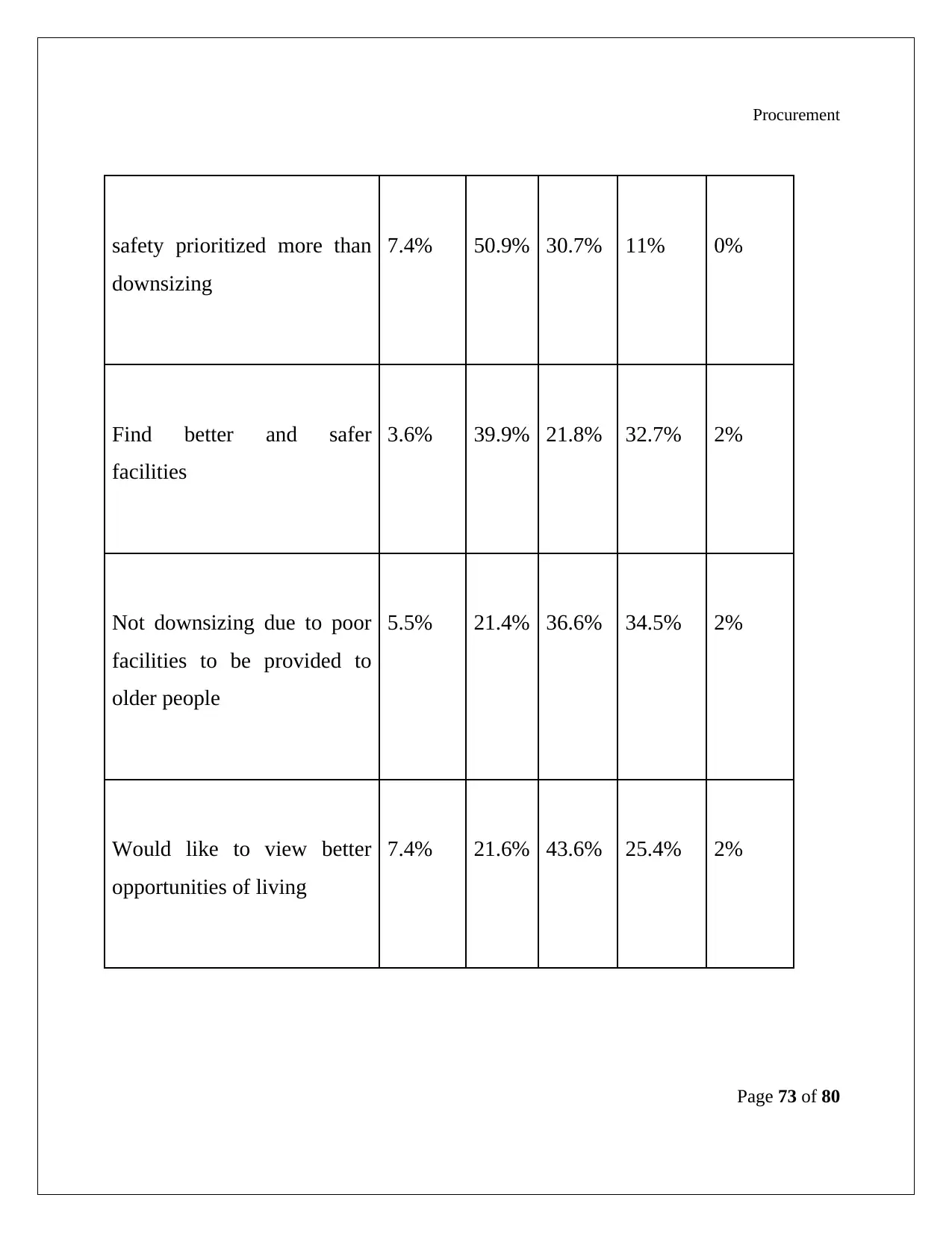
Procurement
safety prioritized more than
downsizing
7.4% 50.9% 30.7% 11% 0%
Find better and safer
facilities
3.6% 39.9% 21.8% 32.7% 2%
Not downsizing due to poor
facilities to be provided to
older people
5.5% 21.4% 36.6% 34.5% 2%
Would like to view better
opportunities of living
7.4% 21.6% 43.6% 25.4% 2%
Page 73 of 80
safety prioritized more than
downsizing
7.4% 50.9% 30.7% 11% 0%
Find better and safer
facilities
3.6% 39.9% 21.8% 32.7% 2%
Not downsizing due to poor
facilities to be provided to
older people
5.5% 21.4% 36.6% 34.5% 2%
Would like to view better
opportunities of living
7.4% 21.6% 43.6% 25.4% 2%
Page 73 of 80
Paraphrase This Document
Need a fresh take? Get an instant paraphrase of this document with our AI Paraphraser
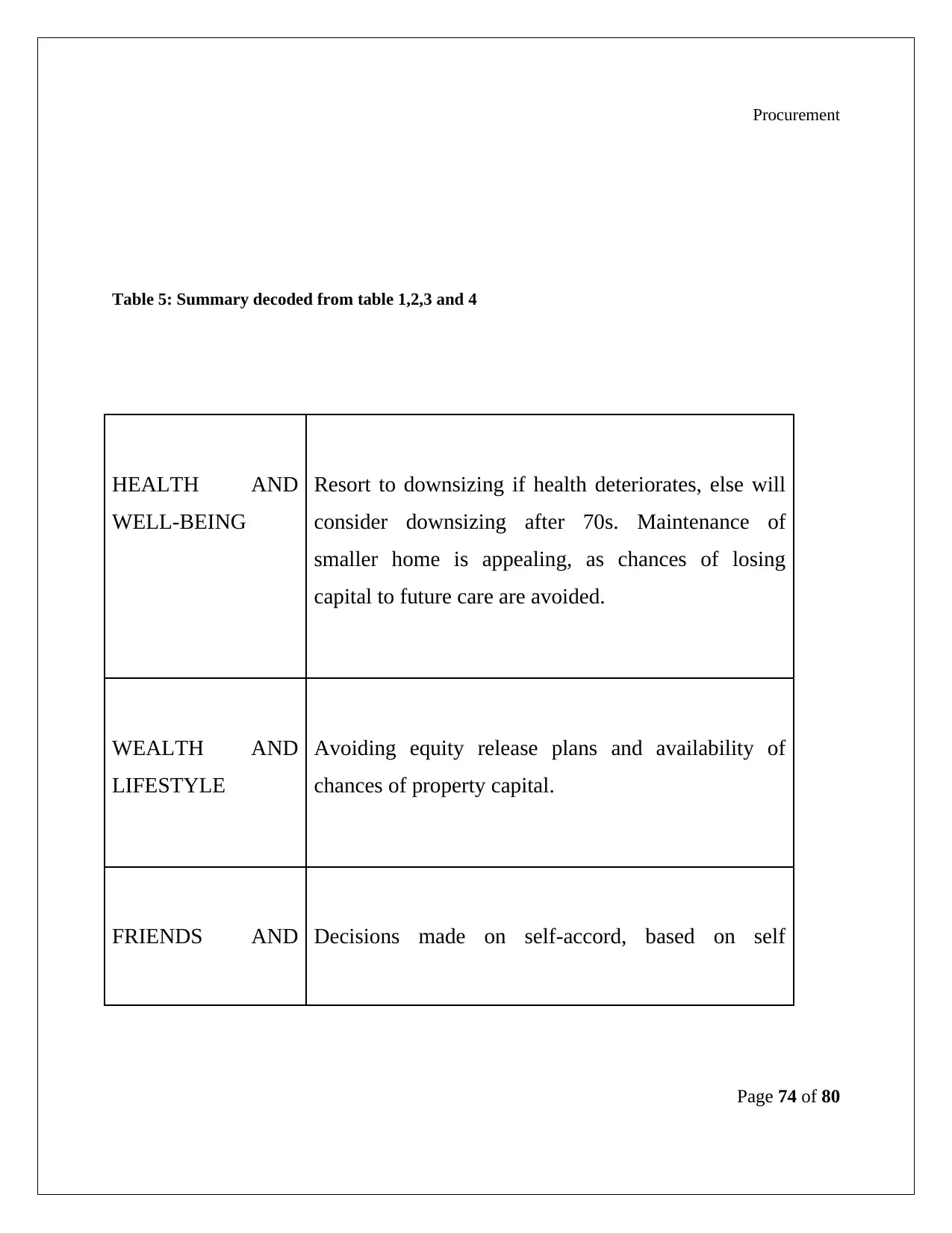
Procurement
Table 5: Summary decoded from table 1,2,3 and 4
HEALTH AND
WELL-BEING
Resort to downsizing if health deteriorates, else will
consider downsizing after 70s. Maintenance of
smaller home is appealing, as chances of losing
capital to future care are avoided.
WEALTH AND
LIFESTYLE
Avoiding equity release plans and availability of
chances of property capital.
FRIENDS AND Decisions made on self-accord, based on self
Page 74 of 80
Table 5: Summary decoded from table 1,2,3 and 4
HEALTH AND
WELL-BEING
Resort to downsizing if health deteriorates, else will
consider downsizing after 70s. Maintenance of
smaller home is appealing, as chances of losing
capital to future care are avoided.
WEALTH AND
LIFESTYLE
Avoiding equity release plans and availability of
chances of property capital.
FRIENDS AND Decisions made on self-accord, based on self
Page 74 of 80
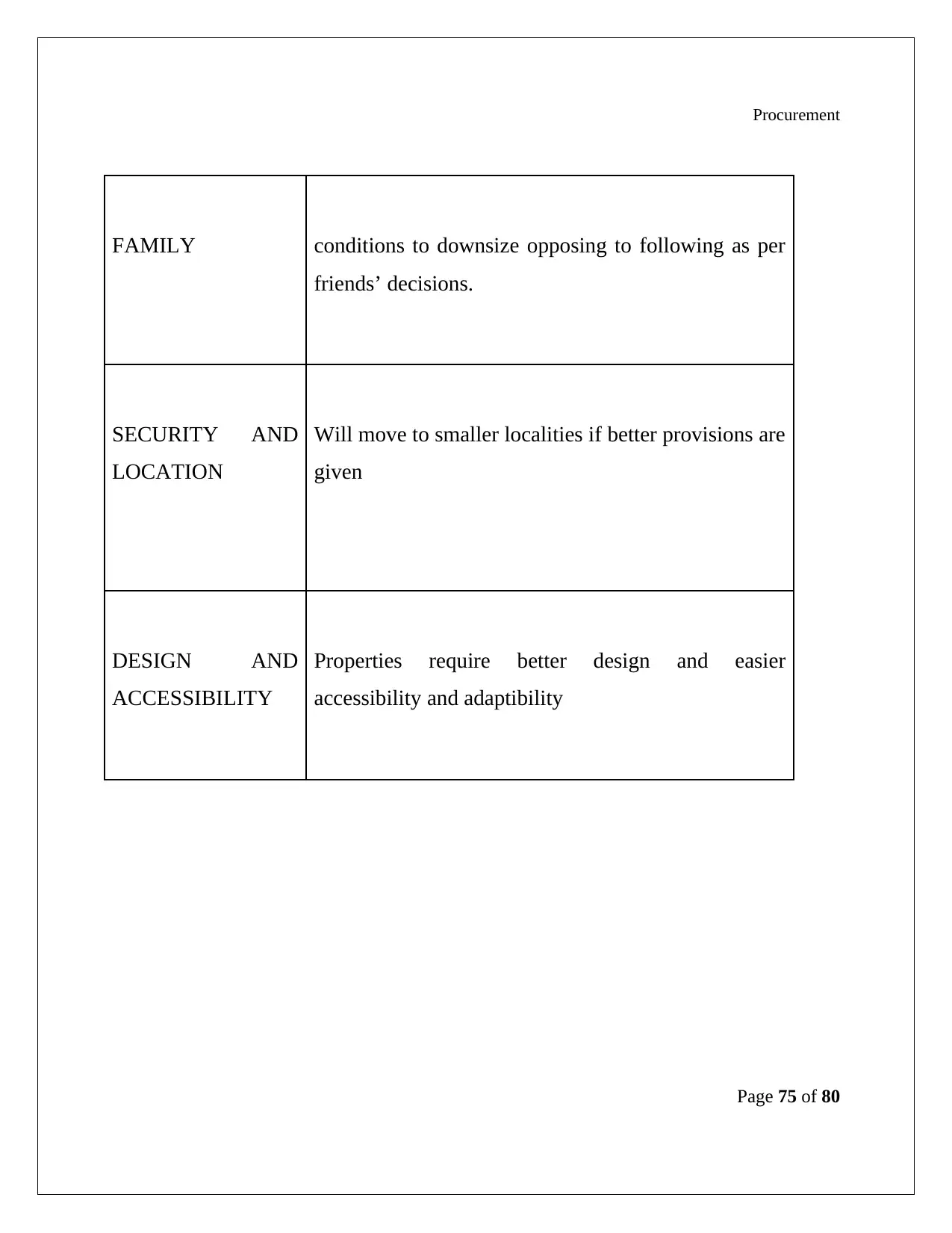
Procurement
FAMILY conditions to downsize opposing to following as per
friends’ decisions.
SECURITY AND
LOCATION
Will move to smaller localities if better provisions are
given
DESIGN AND
ACCESSIBILITY
Properties require better design and easier
accessibility and adaptibility
Page 75 of 80
FAMILY conditions to downsize opposing to following as per
friends’ decisions.
SECURITY AND
LOCATION
Will move to smaller localities if better provisions are
given
DESIGN AND
ACCESSIBILITY
Properties require better design and easier
accessibility and adaptibility
Page 75 of 80

Procurement
Graph 1: Prospective downsizer percentages for proposition to build more
bungalows
Page 76 of 80
Graph 1: Prospective downsizer percentages for proposition to build more
bungalows
Page 76 of 80
Secure Best Marks with AI Grader
Need help grading? Try our AI Grader for instant feedback on your assignments.

Procurement
Graph 2: Percentage of downsizers for proposing the construction of more
retirement villages
List of Figures
Figure 1: House typology data pie chart
Page 77 of 80
Graph 2: Percentage of downsizers for proposing the construction of more
retirement villages
List of Figures
Figure 1: House typology data pie chart
Page 77 of 80
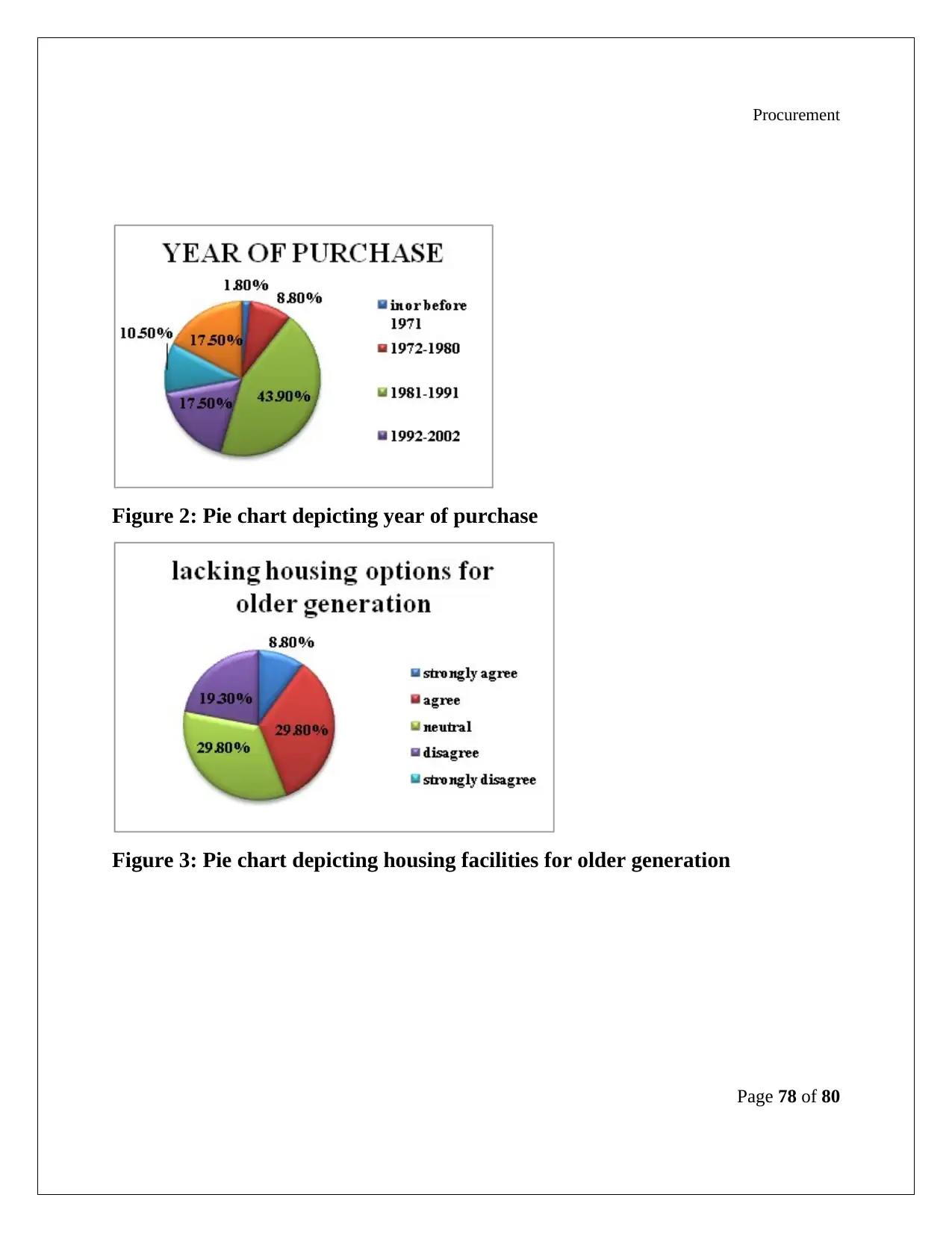
Procurement
Figure 2: Pie chart depicting year of purchase
Figure 3: Pie chart depicting housing facilities for older generation
Page 78 of 80
Figure 2: Pie chart depicting year of purchase
Figure 3: Pie chart depicting housing facilities for older generation
Page 78 of 80
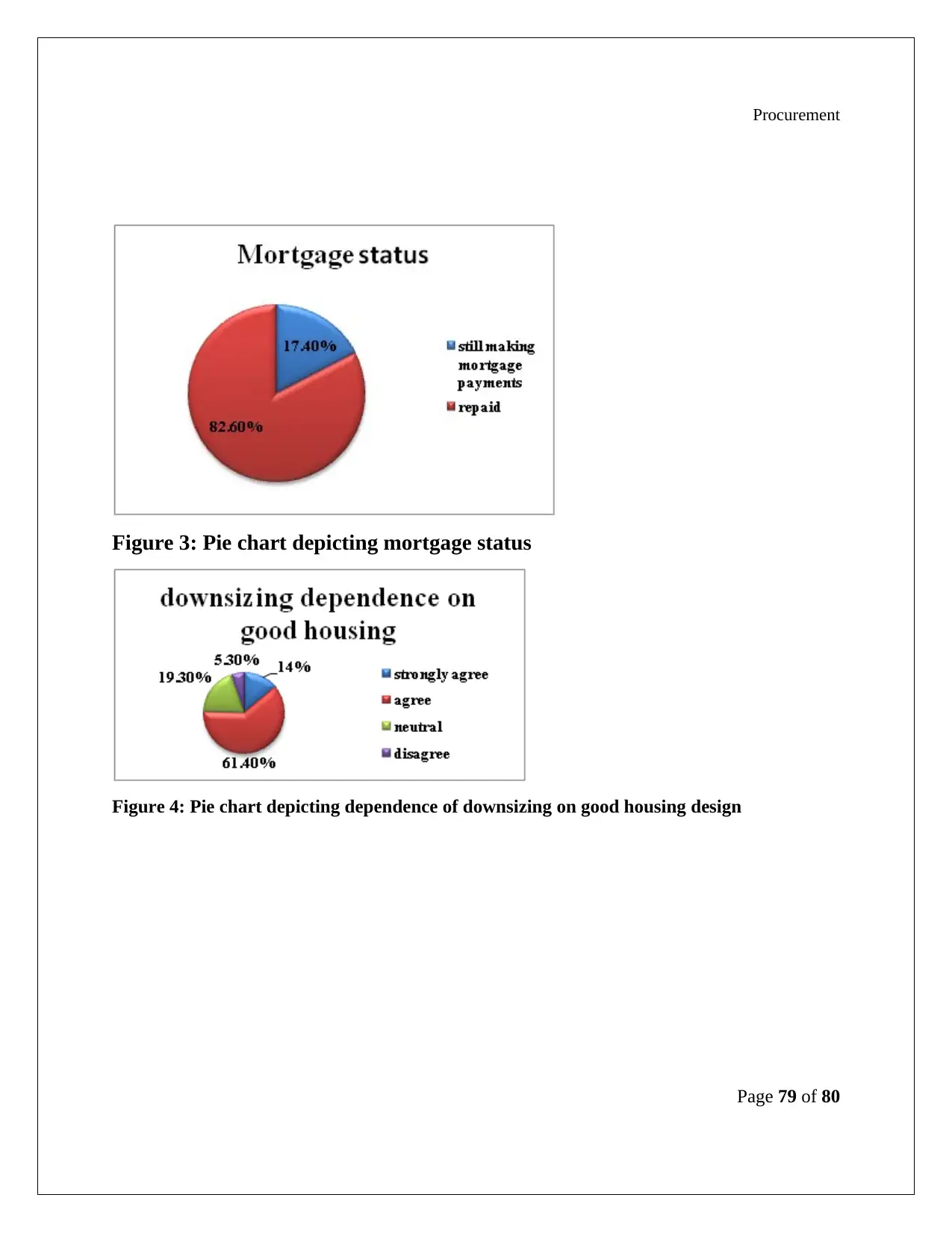
Procurement
Figure 3: Pie chart depicting mortgage status
Figure 4: Pie chart depicting dependence of downsizing on good housing design
Page 79 of 80
Figure 3: Pie chart depicting mortgage status
Figure 4: Pie chart depicting dependence of downsizing on good housing design
Page 79 of 80
Paraphrase This Document
Need a fresh take? Get an instant paraphrase of this document with our AI Paraphraser

Procurement
List of Figures
Figure 1: cost overrun by procurement type
Figure 2: Cost overrun by contract type
Figure 3: Cost overrun by floor area
Figure 4: Cost overrun by contract type and floor area
Figure 5: Cost overrun by contract type and floor area
Figure 6: Cost overrun by procurement and contract type
Figure 7: Prospective downsizer percentages for proposition to build more bungalows
Figure 8: Percentage of downsizers for proposing the construction of more retirement villages
Figure 9: House typology data pie chart
Figure 10: Pie chart depicting year of purchase
Figure 11 : Pie chart depicting housing facilities for older generation
Figure 12 : Pie chart depicting mortgage status
Figure 13 : Pie chart depicting dependence of downsizing on good housing design
List of Tables
Table 1: Questions based on property
Table 2: Questions based on family, friends and lifestyle
Table 3: Questions based on adaptability
Table 4: Questions based on security and location
Table 5: Summary decoded from table 1,2,3 and 4
Page 80 of 80
List of Figures
Figure 1: cost overrun by procurement type
Figure 2: Cost overrun by contract type
Figure 3: Cost overrun by floor area
Figure 4: Cost overrun by contract type and floor area
Figure 5: Cost overrun by contract type and floor area
Figure 6: Cost overrun by procurement and contract type
Figure 7: Prospective downsizer percentages for proposition to build more bungalows
Figure 8: Percentage of downsizers for proposing the construction of more retirement villages
Figure 9: House typology data pie chart
Figure 10: Pie chart depicting year of purchase
Figure 11 : Pie chart depicting housing facilities for older generation
Figure 12 : Pie chart depicting mortgage status
Figure 13 : Pie chart depicting dependence of downsizing on good housing design
List of Tables
Table 1: Questions based on property
Table 2: Questions based on family, friends and lifestyle
Table 3: Questions based on adaptability
Table 4: Questions based on security and location
Table 5: Summary decoded from table 1,2,3 and 4
Page 80 of 80
1 out of 80
Related Documents
Your All-in-One AI-Powered Toolkit for Academic Success.
+13062052269
info@desklib.com
Available 24*7 on WhatsApp / Email
![[object Object]](/_next/static/media/star-bottom.7253800d.svg)
Unlock your academic potential
© 2024 | Zucol Services PVT LTD | All rights reserved.





